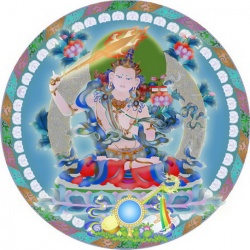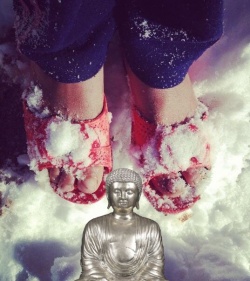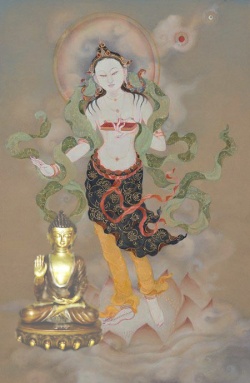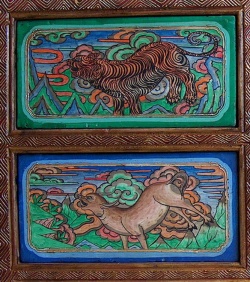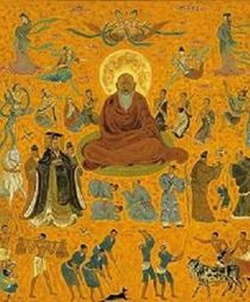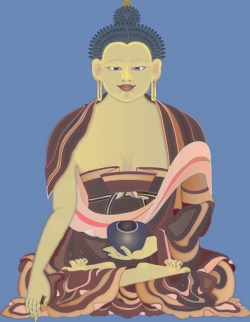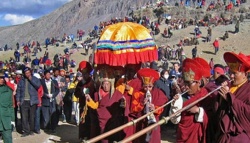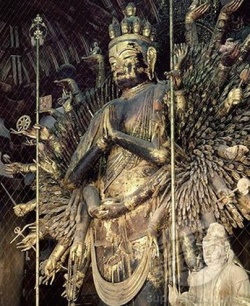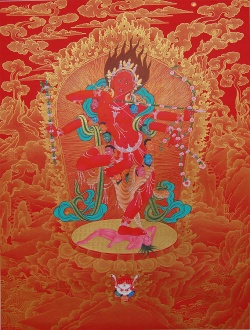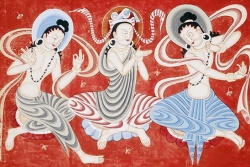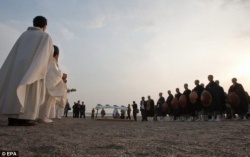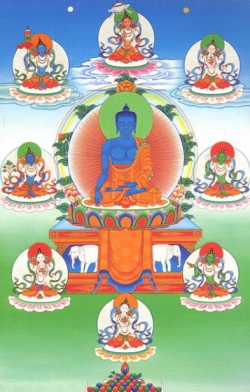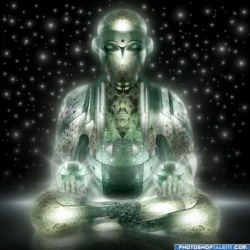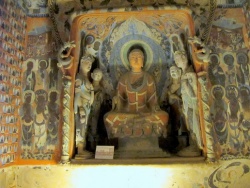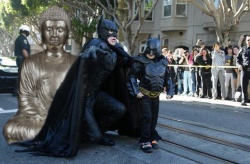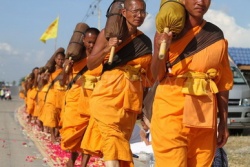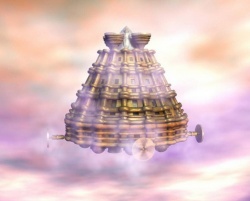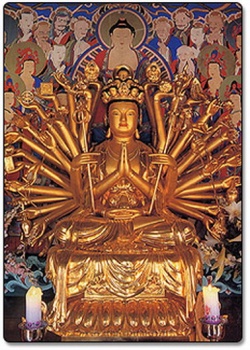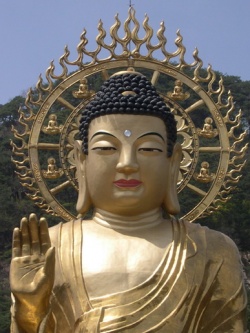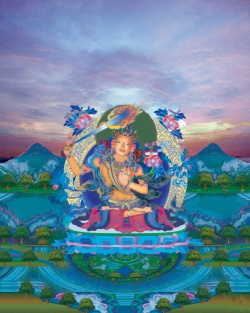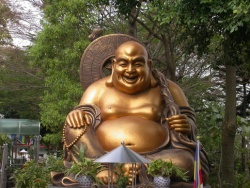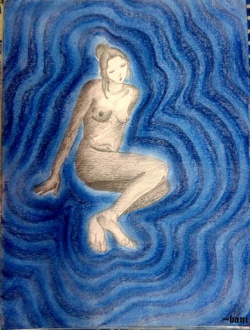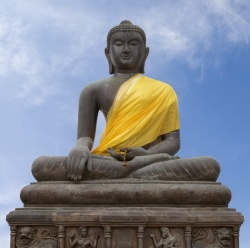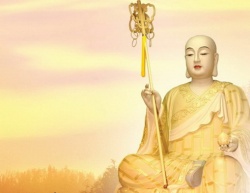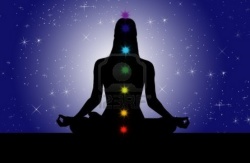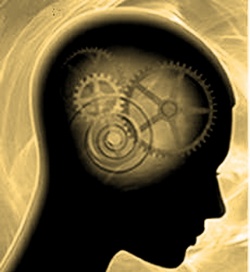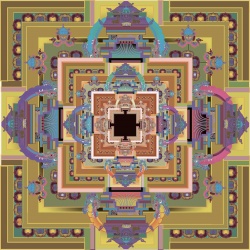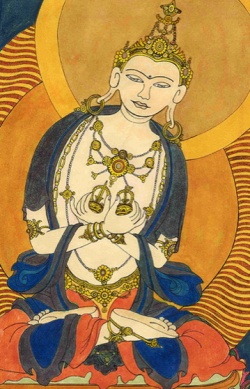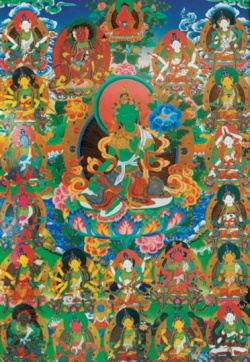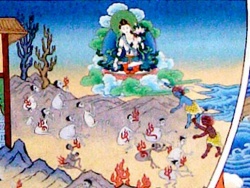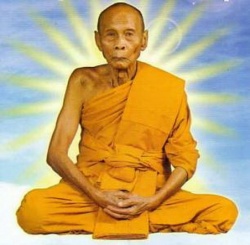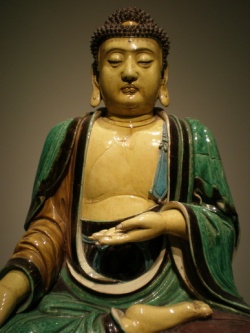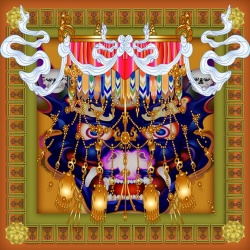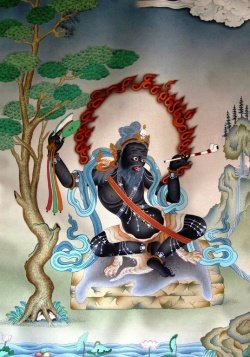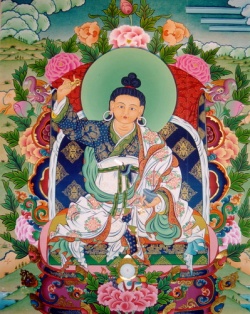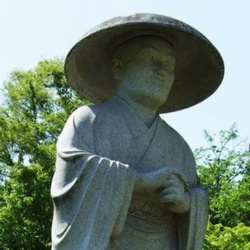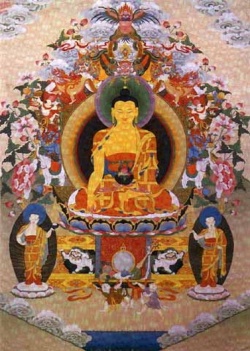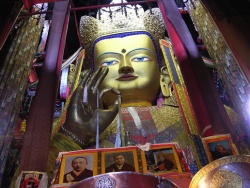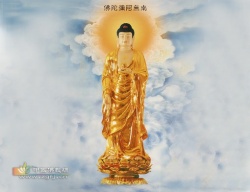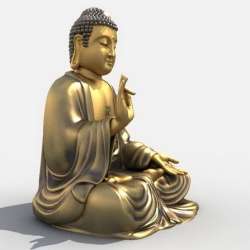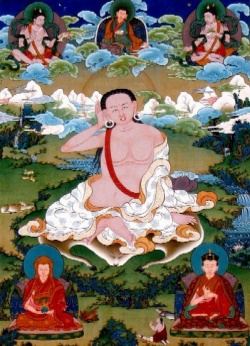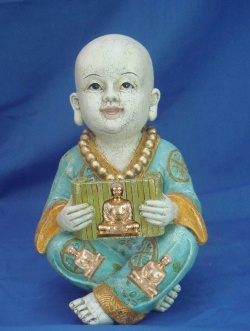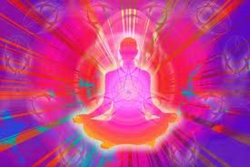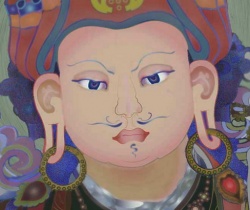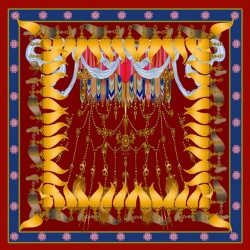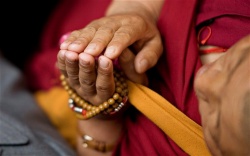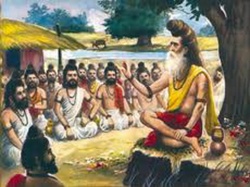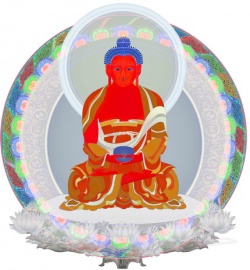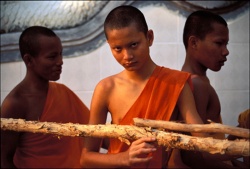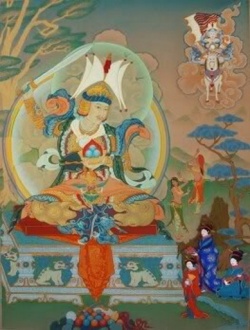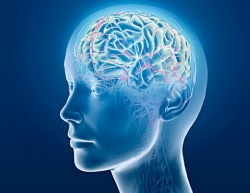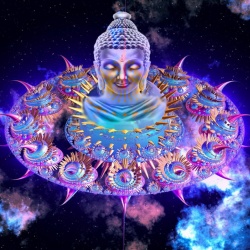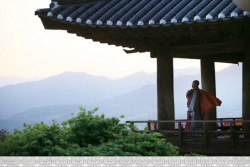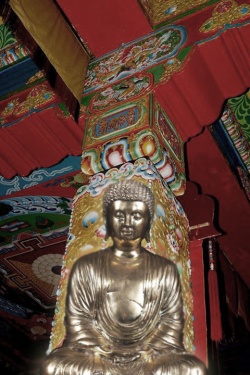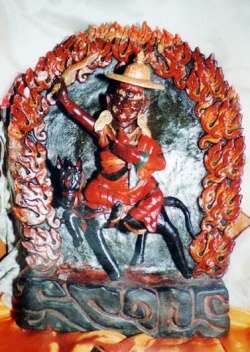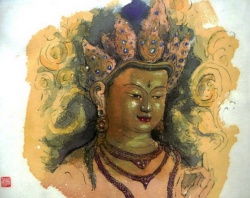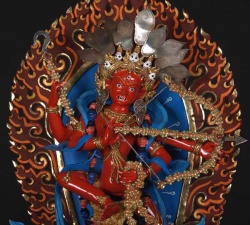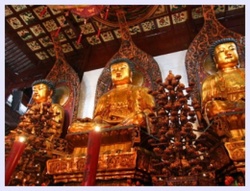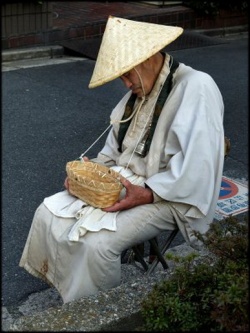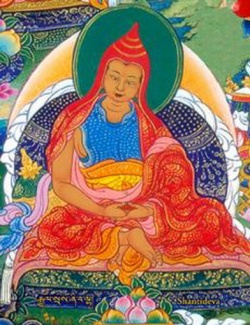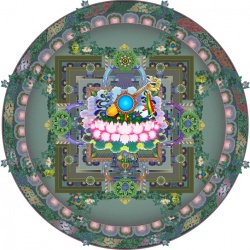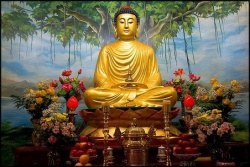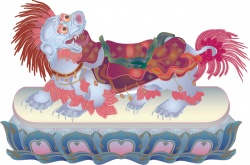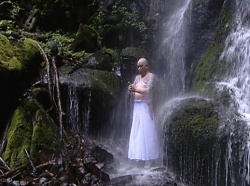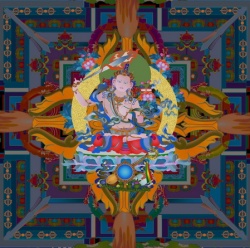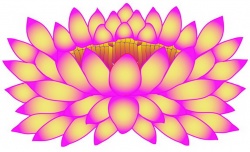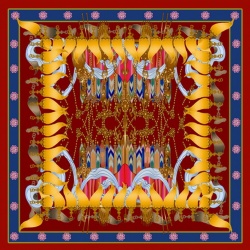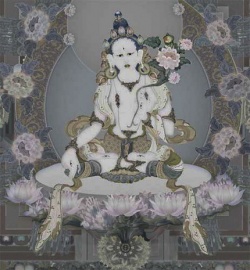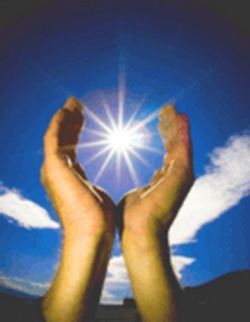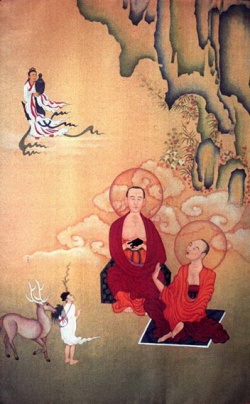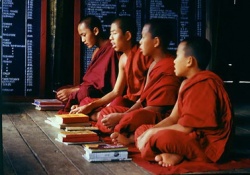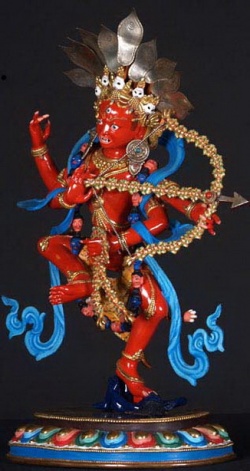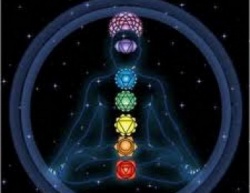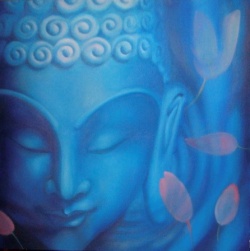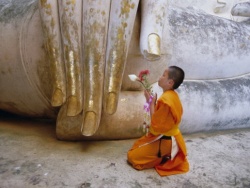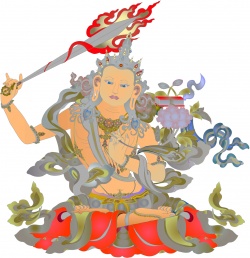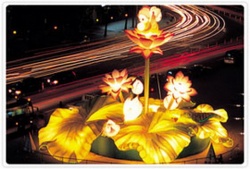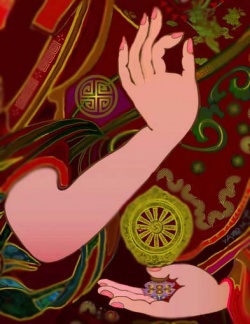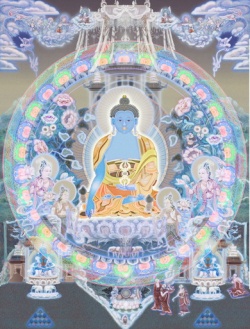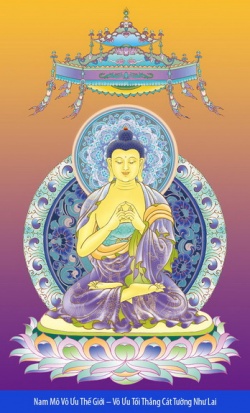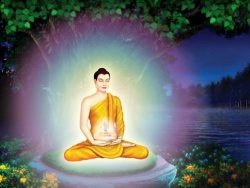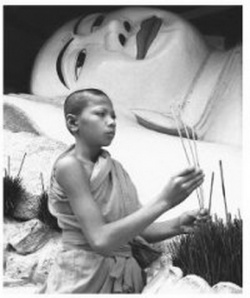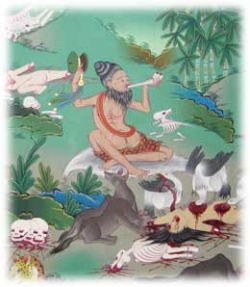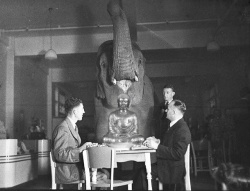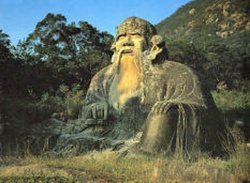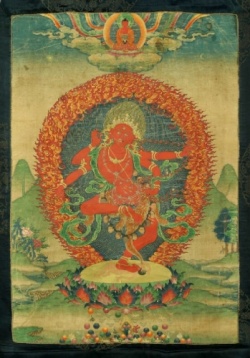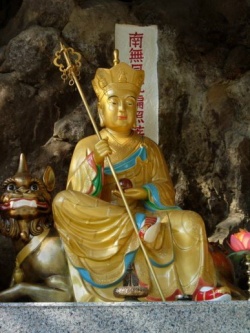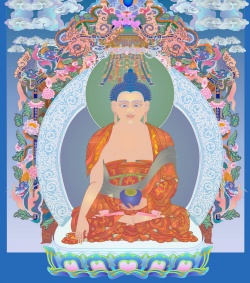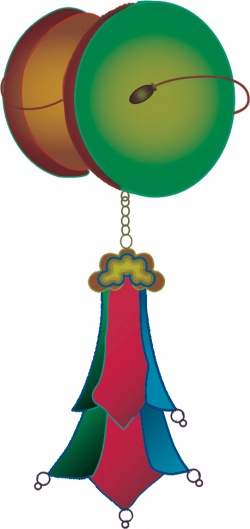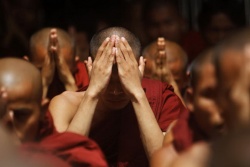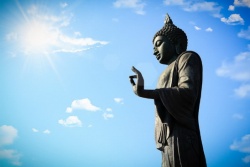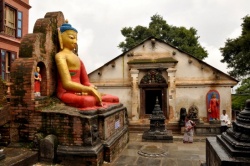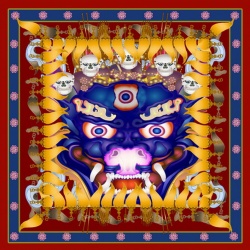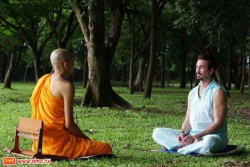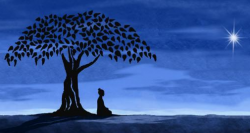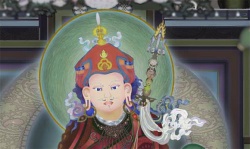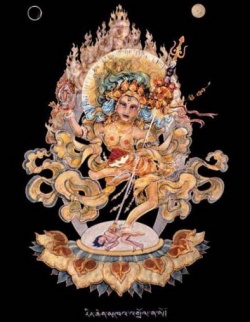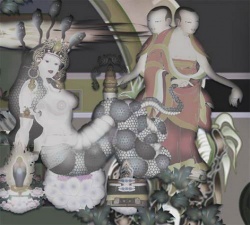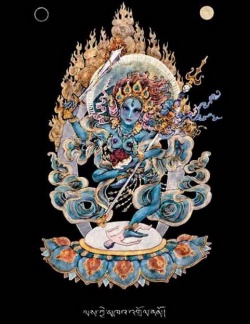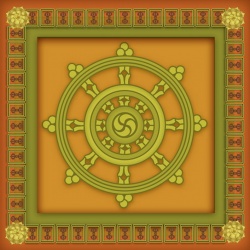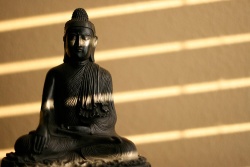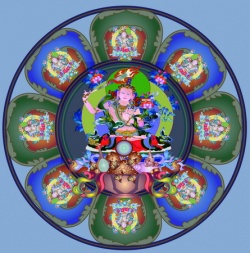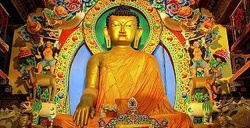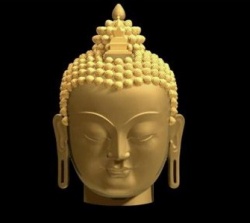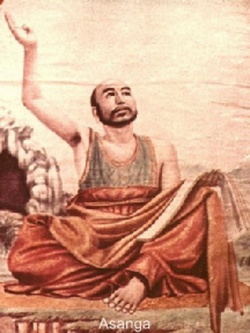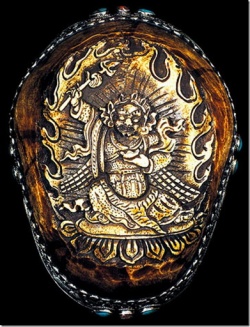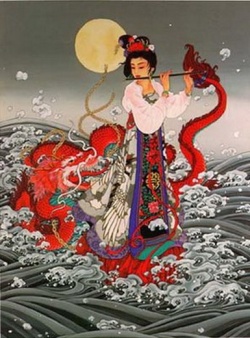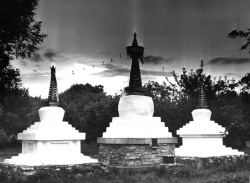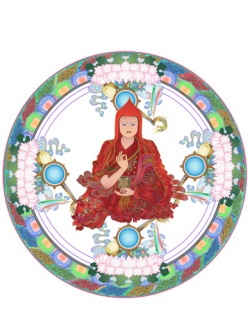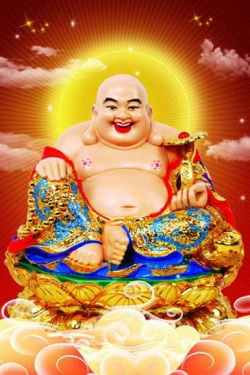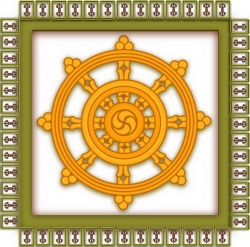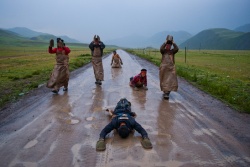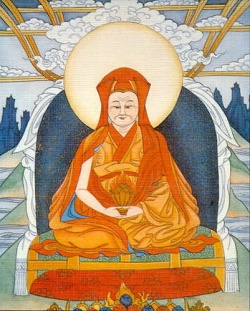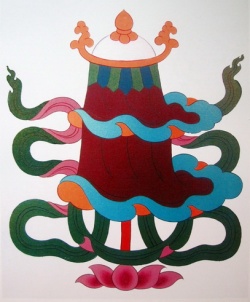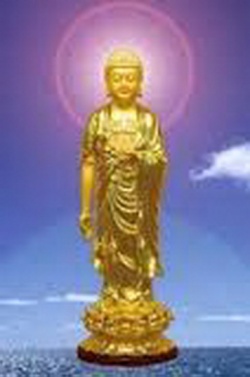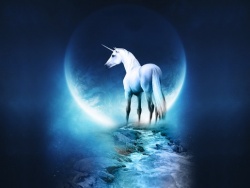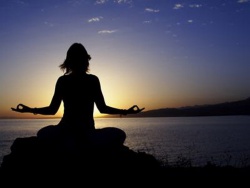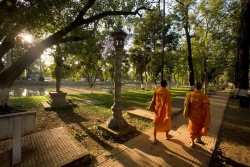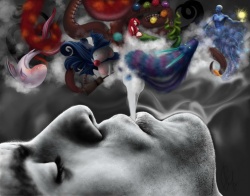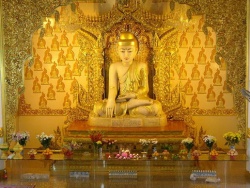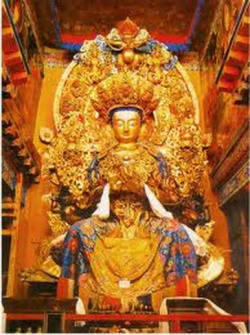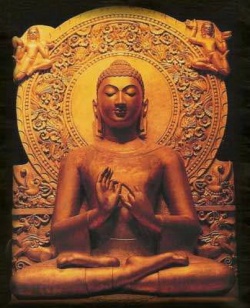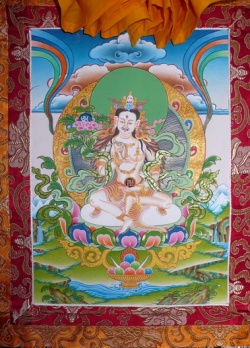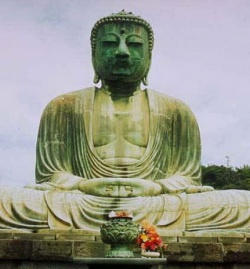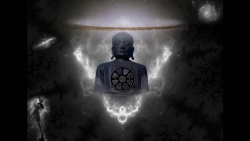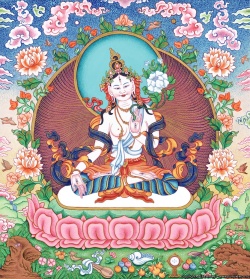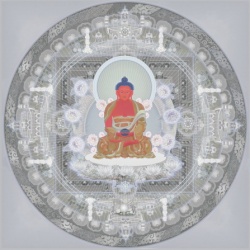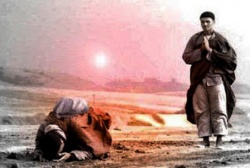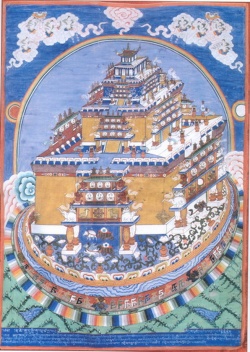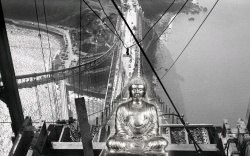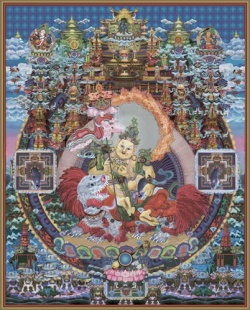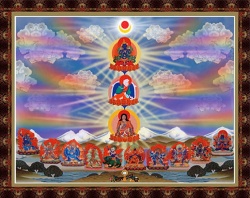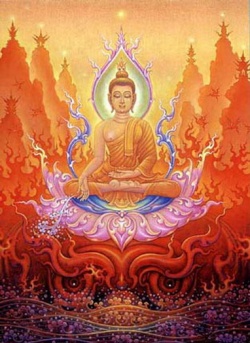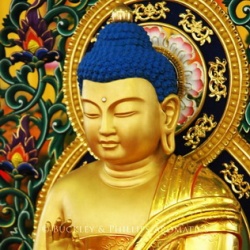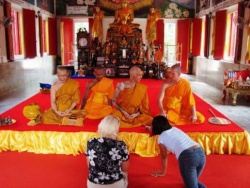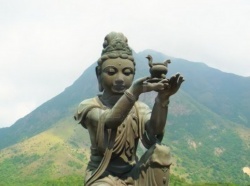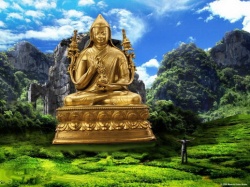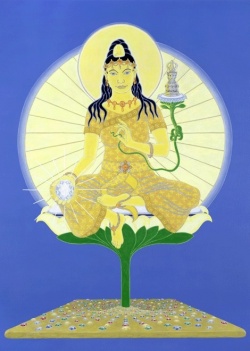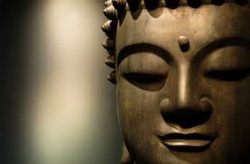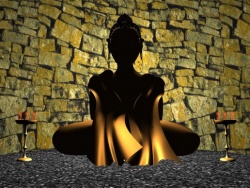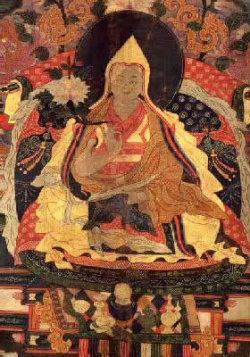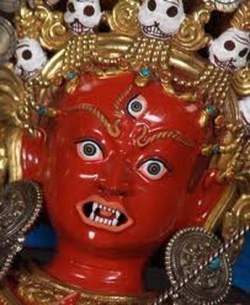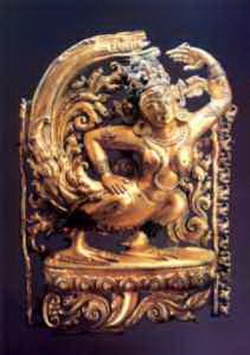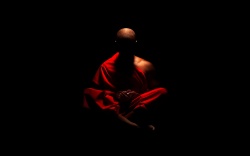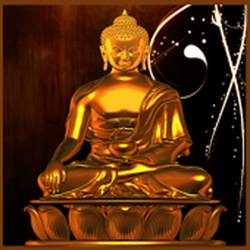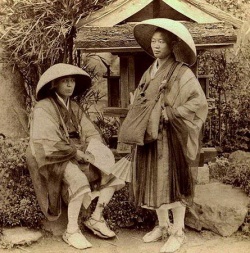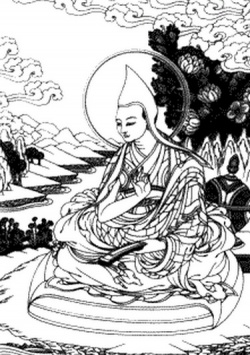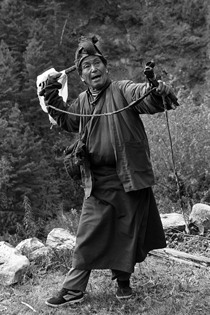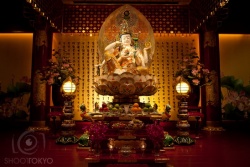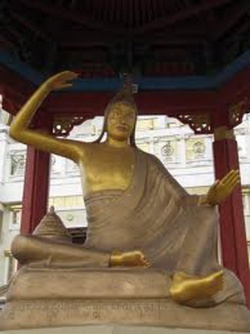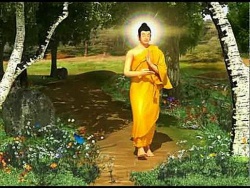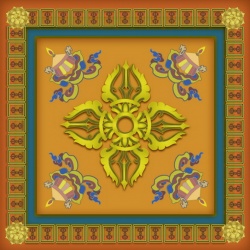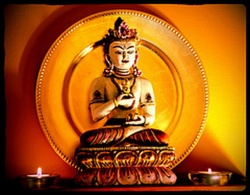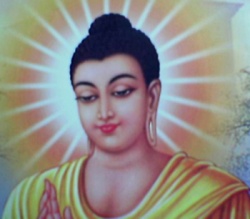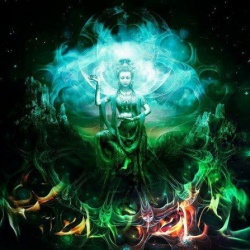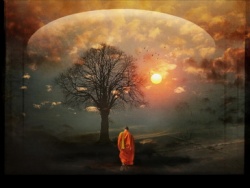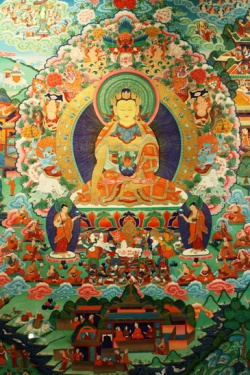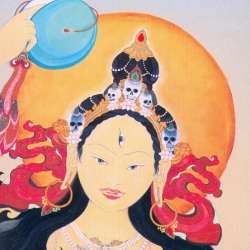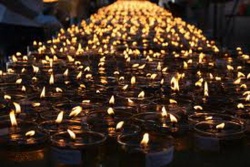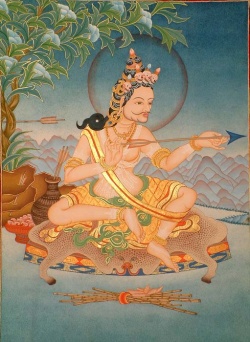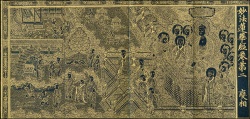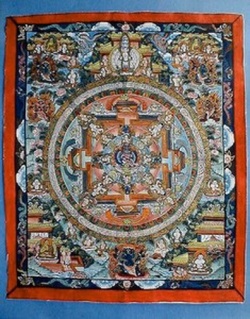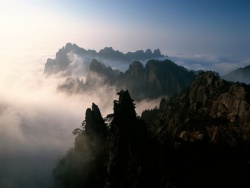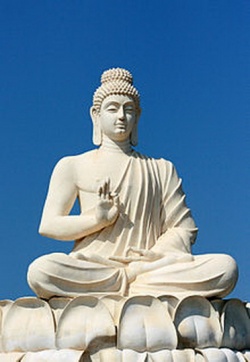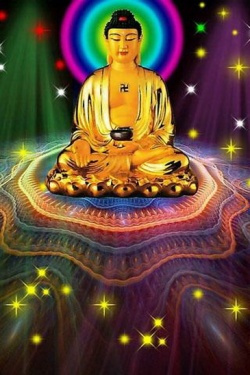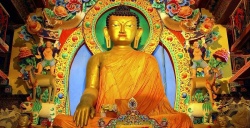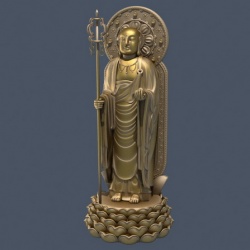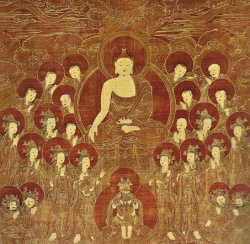Overview of Vajrayana
by His Eminence Kenting Tai Situpa
Introduction
(Beginning Prayers) This time at the request of individual Dharma followers coming from many parts of the world I am spending next six days teaching Dharma every day for two 2-hour sessions. This is with a hope that the knowledge about Dharma of all of you would become more complete and perhaps some wisdom might develop. That remains to be seen.
Definitely you will have more information of teachings and some missing pieces of puzzle might be gathered here, but our ultimate aim is to develop wisdom. And that I really cannot do very much, because the source of wisdom is inside each and every one of you, the primordial wisdom is there in each and every one of you, so you have to realize you have the wisdom, and I can't take off my wisdom hat and put it on your head! If that was to be done, I would have brought lots of hats today. One for each of you, and one to take home to your friends, spare hats.
Unfortunately, Lord Buddha Shakyamuni didn't manage to do that, so how could I? I'm just his follower and hoping to do like him but it may take me a couple of million lifetimes. That's alright with me, each lifetime is better by one million than this life, that's enough for me. This life is not that bad and everything else has been wonderful in this life. All kind of things happen in my life, but I learn from them. So they all are somehow fuel to the flames and I somehow appreciate those… other people might think they are problems and difficulties but I feel that they have done good for me, so I honestly appreciate them, but it doesn't mean you should go around and find problems to create for me, it doesn't mean that. I have learned a lot about myself and about other people and about it, what kind of things can happen in human life, it's very interesting.
To make these couple of days most comprehensive I'm sharing my notes that I made, some of them in a form of books, some of them in a form of pieces of paper, I have hundreds of pages of them. I wish to share them so that what I have learned from my great masters, that is the transmission of lineage from them, I will be able to share with you as much as possible. I found this the best way to do it, otherwise, if we go through one of those great texts, we might not even get quarter of the way, so we might have to come back again, three more times to complete it and that's not convenient for all of you. First I like to start with these notes, which I actually made a copy by hand about two years ago, and these are my notes completed in 1980, that time I was 27 years old. Today I'm half a century old.
I will not go through all of it because it's very philosophical and complicated, but some part of it is I think useful for all of us. Here I wrote four sentences. This is in Tibetan and it says: The essence of Lord Buddha's teaching, which is secret to all of us, is revealed by him, because it is not secret to him.
He realized the ultimate essence of himself and everyone and manifested dana, that is something that we have, but we don't know, so that is called secret. Your secret. By your secret I don't mean that there is something unbecoming that you have done and you don't dare to say it to anybody! But the real essence of you, which has no limitation, you don't know that, it is secret to you. So that secret revealed to Buddha through stainless wisdom. When Buddha overcame his dualism between how he manifested and what he had always been, he wasn't "me, the Buddha", anymore. We call him Buddha Shakyamuni, but he doesn't call himself "I, the Buddha Shakyamuni". Buddha manifested the Dharma, he did not work hard and make notes like this and teach with a microphone with broken English. The outcome of the stainless primordial wisdom is the secret of Lord Buddha's speech.
Now the second sentence: It is heard and received through the ears of the stained ones. Stained by I, the disciple, the Buddha, the master. First there were five of them. After seven weeks of Buddha's enlightenment, when he taught the first Dharma in Varanasi, there were five of them, who received the teaching of Buddha which was Four Noble Truths. Those five people bowed down to Buddha, sat there on their knees and Buddha was glowing with light, magnificent, so it was out of question whether he was Buddha or not. He had two meters light around him that everybody could see. Even those unfortunate people, who did not appreciate Buddha during the time of Buddha, even they had to say: "I have seen nothing great about you except two meter of light around you."
So, they saw him this way, they listened to him and they heard him speak. It was the Four Noble Truths that they heard. So it is heard through the ears of the dualistic ones, stained ones, just like us – I can't say just like us, because they must have been extremely fortunate to hear from Buddha. We are here 2500 years after trying to learn about it, so we are not equal to these five people, but sort of like us.
By hearing through the stained dualistic ears and by remembering it in the mind of dualism, saying that: "I heard Buddha saying that." And I am sure these people talked to each other: "Did he really say that?" "Yes, yes, he said that, but I don't think he said that way." They must have had discussions among themselves and finally they came to a conclusion about the Four Noble Truths.
So they heard through the dualistic ears and they held in the dualistic mind. The third line is: Because of that itself, it is very possible, that it is stained by the composition. (Composition in Tibetan is dy she, composition of subject and object, your ear is made of many things, your eye is a ball of water and your heart is neatly wired jelly. All of this is composition of atoms and molecules.) Because of that it is quite possibly that it is stained by the composition and they don't hear exactly what Buddha manifests. Otherwise there will be only Four Noble Truths, there will be no other teaching. And there was sutra, there was abhidharma and tantra. So as beings evolve Buddha's teachings manifest.
Otherwise, why didn't Buddha manifest tantra first, without all of those other things. Step by step the beings, the disciples evolved, so the teachings manifested according to their capacity. After Four Noble Truths there is the second turning of the Wheel [of Dharma) which is Mahayana, then there is the third turning of the Wheel, then there is tantric aspect of teaching, which can manifest anytime, timeless. So, the third sentence is saying that because of that itself it is possible to be stained by the composition.
Last sentence: Therefore, ultimate meaning/teaching has to be non-dualistic dharmakaya itself. Ultimate teaching of Dharma has to be the non-dualistic dharmakaya itself. You hear the ultimate teaching of Buddha only when you become Buddha. Until that we transform one thing to that, achieve that, hear another thing and practise it, then achieve the realisation of that, and so on we progress. Even we just say a simple prayer: "May all sentient beings be free from suffering." It will have meaning according to each one of us even right now. Slight differences will be there. And when you say today "May all sentient beings be free from suffering" and when you say it after one year, it will have different meaning, because you evolve. If you are progressing, its meaning will become deeper and more profound, increase each year. If you are not progressing but going backwards, the meaning will decrease and become less deep and less profound.
Therefore the ultimate Dharma, the ultimate essence of Lord Buddha's teaching is Dharmakaya itself. Those were these four sentences. As I said, I wrote this long time ago. I cannot say I evolved very much, but I am very sceptical and pragmatic, I am still today, but more so when I was younger, I was just a young man at the time. Next four sentences show that quite clearly.
I don't regret I said that but you have to wait for the next four sentences so that you don't get confused. If you only learn this, you may get confused. Here it says: The Lord Buddhas teaching became 2, 3, 7, 9 etc. The Theravada, Mahayana, Vajrayana, kriyayoga, upayoga, anuttarayoga, mahayoga, anuyoga, atiyoga, so many already.
Next sentence: Each one, they also became quite a few numbers that is countable. So Vajrayana Buddhism of Tibet has eight main lineages. Each one of them has many sub lineages; it became quite a good number, and Mahayana itself became quite a few, the Mahayana of India, Burma, Kampuchea, Korea and Japan, China etc. It became so many kind of Mahayana and each one of them will have for example Lotus sutra, Amitabha and Chenrezig following Mahayana. It is like a big jungle with many trees and each tree with many branches. It's quite complicated actually. I know where I belong because I was born into it, but those of you, who become followers, have a big job to find out which tree that you belong to! It is quite interesting: is it a maple tree or a pine tree? Is it a banyan tree or a cypress? It depends on your final decision that you will be part of one tree and we respect of course all the trees.
The third sentence says that: After few more thousand years – the Buddha taught Dharma a little bit over 2500 years ago, and up to today there appeared so many branches already, after another couple of thousand years, then the last sentence says that it will become like a great offering visualisation. We call it kun-zang cho-drin. Most profound cloud of offerings. It means that you will generate five offerings from your five fingers and each one of them generate five, so it will go on forever, and the sky will be filled with the offerings. It will be go on forever generating. After few thousand years it (Dharma lineages) can become like that. I'm not saying it is wrong but it is how it will become. It's complicated.
Now the next four sentences, which are continuation of that I will skip. After that I wrote four sentences, which somehow try to bring a conclusion to that incomprehendable growth. Pure devotion, pure intention, pure diligence and faith, based on that one listens, contemplates, teaches, debates and does it purely and correctly. By doing that purely and correctly, then at the end, it is also possible that all of those different branches – sometimes they seem to contradict each other, if you sincerely and purely study and debate on them, then they will form into same essence, same meaning in the end. But that requires a lot of faith, patience and diligence; otherwise you will just go to half way: you only see the difference but you don't have enough patience to go further, so you don't see the similarities, and the sameness. So it can fall into the same essence.
The next four sentences, little bit surrendering, because those days I was quite fresh in my mind about my study on Buddhist philosophies and my practise on the various yogas, doing serious practice and retreats, so it was all a bit like balloon that is blown too big, so it is about to burst. When you are twenty something and you have learned a lot and you have little bit of ego also, to be honest, so when you have that kind of ego, then at the same time you learn how much you don't know. The more you learn, the more you see things that you don't know. It is hard for the ego, things that I'm better than so many, I know a lot, but yet I don't know anything. It's little hard to swallow, I'm sure it is happening to those of you who are at that age now. For that I had to do some surrendering because I could not go on like that without becoming stressed.
Therefore I wrote these four sentences: Relative words, details, all of these endless things, whether you know them or not, if your lineage is pure and if you are following with your body, speech and mind the path which accords with the morals and ethics and ways of the lineage sincerely, then the ultimate primordial wisdom, which is the essence of everyone will manifest from within without doubts.
Okay, I know a lot, but it doesn't matter whether I know or not. And how much more there is to know, which is difficult for me to admit, that I don't know yet. But whether I know about these things or not, doesn't matter, if I follow the unbroken lineage of the Lord Buddha's teaching with faith and devotion and sincerely practise it according to the morals and ethics of each one of the practice, then the ultimate essence – whatever it is – very hard to explain and put your fingers on, it will definitely unfold from within. There is no question about it.
So, whether I know about it or not really doesn't matter very much. Whether I wrote 100 or 200 books or read 300 books, doesn't matter, whether I received teachings on 50 philosophical sacred texts or not, doesn't matter, but if I'm practising any one of them sincerely, then the wisdom, the essence of all of this, what we are trying to say, it is impossible to say but we try, and at the end of the six days of our teaching here you will know that ultimate essence cannot be expressed, there is no word for it.
It is like asking somebody: "How do you feel when you become Buddha?" If Buddha had said: "I feel this way or that way," he is dualistic, he is not Buddha. It is dualistic to be experimenting: "Well, let's see, okay, I feel like this but not always," etc. Saying that would mean he is not Buddha, but just like one of us, not enlightened. So Buddha means reaching the realization beyond dualism. It is above feeling. It does not mean Buddha does not have feelings. It is above feeling and not feeling, above knowing and not knowing. You have to reach beyond that, you have to cross that. We are speaking about the unspeakable, it is ineffable, it is unexplainable. That is to make sure we will speak for six days. Each day for four hours, you see. How many hours is that? 24 hours to find out that we cannot say anything about it!
That's what we do, we human beings we think that we are so clever; we have language, culture and all kind of sophisticated things, so we are really smart, but actually we are more stupid than a cockroach, they survived through all of this. They become immune and crawl everywhere and all human beings try their best to exterminate them and they cannot. They even show up in some of the best places, because they are so good in adapting. So actually we are not as smart as we think.
The reason I wrote my notes I give here in the next four sentences. For some people (the newcomers exposed to the Dharma – including myself at that time) the central texts (most important great works which have so many commentaries and thoughts derived from them, so therefore they are like central) and also the view, meditation and action, all of this are so holy and sacred, deep and vast, that one gets confused and I saw one's head turns like the peacock feather umbrella, which is meant for the noble ones. You see, the kings and great masters, in the olden days when they travelled they had up to thirteen umbrellas (the highest rank is 13 umbrellas). They had thirteen people carrying peacock feather umbrellas and they turned them clockwise. They only had one head to cover, but… In Hindi language there is a very good way to say that: "chaka ah hai" or "chaka ah raha hai", the head is turning like a wheel. I saw that in myself as well.
The last four sentences I wrote: Therefore the ground, path and fruition, to simplify and make it short (it is for my own note, so that I don't forget), maybe it will be beneficial for some beginners. That is why I wrote this text. I like to share this part so that you know what Dharma is and you know what learning of the Dharma is. We are not learning Dharma to finish learning Dharma, it is impossible. You can learn Dharma for 10000 lifetimes and still there is more to learn. You can learn Dharma and earn 200 Ph degrees. Still there is more to learn. Learning Dharma is impossible to complete.
Learning Dharma is just like learning of anything. If I want to learn about this glass of water which I will drink in these two hours, if I wanted to know everything about this, how many lifetimes I have to learn? I cannot know everything about this glass of water until I know everything about the whole universe of all sentient beings of the entire space. Until I know everything I will not know everything about this glass of water. That also will be only one perspective, because I as a human being of planet Earth with my eyes and ears, the tools that are suitable for my hands and eyes and ears, with that I am learning about this. Even that I have to learn that way with a human eye, human ear and human mind.
But what about, if I am a dog? Then I have dog's hands, dog's eyes and tools that a civilized dog would use. It will be another way, so it will take forever. What about if I am a spirit, which doesn't have this body but another kind of body and eyes. With that to learn about this glass of water will take forever. Then if I'm born as a god with god's eyes, ears, body and perception, then learning about this glass of water will take forever. The human being of this planet Earth and a human being of another universe, which has totally different environment, they may have no eyes but maybe they see through the sound. And they don't eat our kind of food but something else, so even the human beings – how many kind of human beings there are? – Countless. Human realm of planet Earth has just one kind of human beings.
Among us there are also white, yellow, black, brown, red, so many, but these differences are absolutely hair-splitting differences. There are not really differences, everybody has one nose with two holes and one mouth with teeth in it, you know, filled with bones, and two eyes and two ears on the two sides, hair on the top. Everybody is same, whether you are black or white or red or yellow. There isn't much difference. But human beings in other universes have to be different. We are evolved through certain kind of evolution. If the others evolved through another evolution, they will look totally different. They will have totally different composition even the environment is same. We might be able to see them and shake their hands or tail whatever they have! Or ear even. They may not have hand but a very long ear to write and do things, I don't know, so we can shake them, but then human beings of another universe who have totally different environment, we might not see them. They might not see us. But if it is the same level of the realm, then they are human beings.
So, you have animals like dog, snake, worm, fish, but they all look totally different, they don't look the same. Human realm is also like that. It is a realm, and because of different level of different environment they evolve differently. So, let's say: when I or anybody knows everything about this glass of water totally, than that person is Buddha.
If you are a scientist who wants to know everything about anything, you have to become enlightened. Otherwise it is impossible. You maybe can write the finding of your research, maybe two hundred books, and you will die for sure with unfinished job. Then others will be critics of your fans and continue, they will write another two hundred books on it and they will die. Others will do the same and die, but they might win a Nobel Price of Science or they might be very respected and there can be statues made of them in front of science institutes and their portraits may hang in the gallery of the institutes. All of that can happen, but it doesn't mean you can know everything without realisation. That is impossible.
These things I wrote down and I'm sharing this with you because this part is very important. One shouldn't get discouraged or encouraged or anything, just simple facts one has to know. Of course all these things that I wrote are not coming from me but my masters. My masters' great wisdom, which they received from their masters, was transmitted to me with compassion and I received it with devotion. That is the kind of transmission and blessing I received and I tried to put it on paper for my own notes.
Why I say that those days I knew a lot, means since those days I have been working like a coolie to serve Buddha and the lineage. So I am teaching, building, travelling and doing all kind of things and past ten years or so I have also been handling things that I have no training for and which I have not been exposed before. This way it is also very interesting. I have been working like a coolie to serve Dharma. I am grateful of it – it is a great honour, but then, my learning of new texts, very little has happened since that time. I cannot work and study or teach and study at the same time. So my knowledge about Buddhist philosophy and texts pretty much stays the same as that time. Of course there is a little bit more experience, because I'm teaching and talking to people.
From here I'd like to go to one most important teaching and fundamental basic practice of Vajrayana. In Vajrayana devotion is most important but most of the time it is little bit difficult to express, because devotion is not that politically correct. Compassion is more politically correct. I talk about compassion – I can talk about compassion to anybody, but when I talk about devotion, I have to be very clear and quite sure who I am talking to. I consider all of you very serious in the Dharma and you are not just experimenting, so I must talk about devotion.
The foundation of devotion is: your confidence in your essence. If you don't have confidence in your essence, you cannot really have true devotion. Then it becomes like fear rather than devotion. When you have confidence in your essence, which is the essence of Mahayana teaching, in Mahayana Buddha taught about Bodhicitta, and Bodhicitta is about your essence. "I wish to become Buddha," that is Bodhicitta, "I wish to become Buddha for the benefit of all sentient beings to help them to become Buddha." And on the way I like to alleviate them from their suffering etc., but ultimate goal is: I wish to become Buddha. That is very big confidence that you have in you, which makes you able to say that.
"I" means I, each one of us, no matter what kind of façade we put outside, each one of us has thousands of problems and shortcomings in each one of us, we know. We don't have to exhibit to the others, not necessarily, but we at least have to know by ourselves: "I have this shortcoming; I have attachment, anger, jealousy, pride and ignorance, all of this." Each one of us has bigger share than enough of those defilements and the karma that each one of us has committed to those defilements is enormous. Each one of us has lived countless lifetimes trying to fulfil our dreams, big or small dreams. In order to achieve that, we have done so many things. Sometimes we have little bit conscience, so we are careful but sometimes we have no conscience, so we are very ruthless and do everything to get what we want and cause lots of harm to others. I'm sure each one of us has done both of those countless times.
The result shows right now. To do some good things we have to work very hard, and if we are not careful just without even knowing, we end up doing things that are not so good. For example, a mosquito lands here and bites me and to slap is very easy, automatic. And what did we do? Somebody just tried to take little bit of blood from us, maybe it is good for us, definitely it is good for me because I have little bit high blood pressure, too much blood, so if 100 mosquitoes bite me at the same time, will be good for me. Of course, if they have malaria, then I have a problem. But then it is also good for my doctors, I can go to doctors and they get job, in the clinic they sell the medicine and I get well, they made some money, why not? But fortunately or unfortunately my doctor refuses to take money from me, but pharmacies do and I buy the medicines from the pharmacies. So whether I get sick or not it doesn't really benefit him. Of course it benefits, because he is being generous and he is doing service, he considers himself a follower of Buddha, so something is special, and he is doing this free for me. It is good for his merit and a little bit low on me, because then I have to somehow digest the generosity of my doctor. I have to have pretty good stomach, pure and strong and healthy and genuine. Otherwise digesting other people's service and donations is not easy. It will short-circuit your merit, if you don’t have the ability to digest it.
This way in the Mahayana Lord Buddha taught about the motivation, and the motivation is: "I wish to attain Buddhahood for the benefit of all sentient beings." That is: you have to have the full confidence in you: I can become Buddha. And how can you have such a big confidence in you? – By knowing what is Buddha. Otherwise it becomes ego, an ambition. "I wish to become Buddha" is not ego, not an ambition; it is a truth and destination. My essence and the essence of Prince Siddharta before he became Buddha are same, and Buddha called it Buddha-nature, Dewa shegpa nyingpo in Tibetan, Tathagatagarbha in Sanskrit and Fau-shing in Chinese. This Buddha-essence is in everyone, this is our essence, and knowing that and having faith in that, that is the basis of devotion.
If you don't have faith in that, and then you try to be devoted to something, it can become something like fear. People say things like this: "Law-abiding", "God fearing", I don't know what they mean; it sounds good, I like it. I'm not saying that to say that is wrong, but we don't fear Buddha. If we do something bad we will go to hell or somewhere which is not so good, but Buddha is not sending us there. It is not Buddha punishing us, Buddha does not have a torturing chamber. And Buddha does not have torturing tools, he doesn't invent them, you see. Buddha is embodiment of compassion and wisdom. We don't fear Buddha and we can't hide anything from Buddha. We do something which nobody knows and we think Buddha also doesn't know. Buddha is in front of us all the time.
It's very interesting. Some people make little shrine in their house and when they go inside they behave very well. They really walk on their knees and try not to think any unbecoming things. They change their clothes before they go into the Buddha's room and all of that is good, it is a good gesture, we should do it, it is meritorial, but if we do this by thinking Buddha is only in the shrine, and not everywhere else, then we don't understand Buddha. Buddha is everywhere.
You should have a shrine, no problem, and shrine should be kept clean, no problem, we shouldn't be engaging in worldly activities in the shrine, we don't keep our business desk or kitchen in the shrine. We don't put our fridge in the shrine, we shouldn't do those things. That is only because of us, we are dualistic and we are doing our best in our own dualistic way to respect Buddha, it is like taking your shoes off but not your socks! In India we take off our shoes outside every respected place: our parent's home or religious place, our teacher's place we take off our shoes. But you don't take off your socks. Socks are also shoes, right?
And sometimes better to go in with the shoes than without… If you have been shopping, had a lunch and went to a nice walk in the garden here, and then come back, I would rather have you wearing shoes than taking them off! That would be more polite, and meritorial. But anyway, we do our best and behave very nicely in our shrine and that is wonderful, but that doesn't mean that the Buddha is only there. Buddha is in the park, in the restaurant, in your office, on the street, in your car, Buddha is everywhere. Wherever you are, your shadow is there. Buddha is omniscient and you can't hide anything from Buddha. We have to know that as well.
By knowing that then keeping a nice clean shrine is good. Without knowing that you have strange idea about Buddha and you might fear the Buddha. If you have fear that means, you don't have confidence. If you are Hercules, a lion has got loose here, he will like it, but all of us will hide under the table. I don't know how much it will help, but we definitely go under the table. But Hercules will stand up and handle the lion. So if we don't have confidence, then we have fear. And Bodhicitta is about that confidence. So when we have confidence, then we have devotion.
I have devotion to my Dharma masters. I have respect for my music teacher but not devotion. If I were learning piano and the teacher came to my house every week once or twice, and I paid the teacher certain amount of money, I would learn from this teacher and I would respect him because he would be teaching me something that I don't know, but I would have no devotion to him, because I want to learn to play piano but I don't want to become like him. Do you understand? I have devotion towards my Dharma masters, because I want to become like them. My ultimate devotion is to Buddha, because I want to become like him, and I have devotion to my masters, because on the way I want to become like them. That is the difference between respect and devotion.
I don't know how the worldly people outside of the Dharma community think about devotion and respect, but devotion is based on your potential: I have the potential to become Buddha and Prince Siddharta achieved that goal already, so I want to become like him, that is my ultimate devotion to Buddha. That continues through the lineage of Buddha, so I have devotion to my Guru, because my Guru transmits the blessing, the lineage of the Buddha to me. He is Buddha's substitute for me. His body could be Sangha, but his teaching is the Buddha's teaching and his mind is the treasure of the Buddha's teaching because he (he or she, doesn't matter) received it from his master with devotion.
This way the devotion is very important. There is one devotional prayer, I think this prayer is written by the first Jamgon Kongtrul Lodro Thaye of Palpung Monastery, or he emphasized it, I can't say exactly but I think he wrote it. There are two set of devotional prayers and I would like to explain this to you.
Solwa deb-so lama Rinpoche
Dong-we bö do drin-chen chö chi je
Kal-me da la re-sa che le me
Thu-yi yer-me dre-par chin-ji-lop.
I, with devotion pray and supplicate to the precious master/guru, I call with most sincere genuine devotion and feeling to the most kind Lord of Dharma. I, who am not yet enlightened, have not had the fortunate karma to attain Buddhahood up to today. So I turn to you, the precious master, May your mind and my mind become one.
May my Guru's wisdom and my wisdom become one. My Guru's wisdom is the unbroken lineage of the Buddha's Dharmakaya, so may I become one with my Guru means may I become one with all the lineage gurus up to the Buddha himself. In our lineage tree (like family tree) Buddha is on the top and Guru is in the middle, and all the lineage asters are in between. We call the Lineage Tree. Buddha in the form of Vajradhara, which is Dharmakaya, Sambhogakaya, Nirmanakaya, all in one, and Guru in the form of Vajradhara, which is equivalent, same form as the Buddha in the middle. This is unbroken lineage of transmission of Buddha's enlightenment, may I become one with this, means may mind and Buddha's mind become one. If we have true devotion, not forged (pretended) one, it will happen. But it may take many lifetimes before we have it. At least we can learn about it and we can cultivate towards it. So this is one prayer, very common prayer of our lineage.
The next sentence is an elaboration of this.
I pray and supplicate with devotion to the precious Guru
And then, what blessings you are asking for, you line them up here. The first blessing you are asking is: May I be able to renounce my ego.
When we pray we should not be pragmatic. We should be most limitless in our prayer, so may I renounce my ego. Can I renounce my ego? – No, of course not. And did I renounce totally my ego? – I didn't. I have a big ego, really. If you could see it you would be surprised. Everybody has ego. Don't say you don't have, I wouldn't believe it, everybody has it, but our ego can be good, bad or mixed. God ego is confidence, bad ego is ruthlessness and so and so is what I think all of us have most of the time. May I be able to renounce this ego, that is the first prayer. When you are sitting in front of a judge you have prayers, right? So he is saying: "I want this and this and this." In the similar way in front of the Buddha we are asking for Buddha's blessing. And our first prayer is: "Please bless me, so that I can renounce my ego." Number one.
Number two: May I truly have the meaninglessness of the worldly activities born within me. So it is not just intellectual, not just kind of intention, but through understanding of meaninglessness of the worldly activity. What does worldly activity mean? It means serving our ego, attachment, jealousy, fear, greed, that is worldly; we are slaves of our greed and hatred and jealousy and doing everything to fulfil those things: attachment, anger, jealousy, pride. This is meaningless because our greed can never be fulfilled.
I tell you: If you become the king and queen of Planet Earth today and if all the 5000 million human beings respect you like a god, within one week, it wouldn't take even one week and you will have a lot of complains and there will be so many things that you want and you find out that you don't have so many things. If you are provided with most comfortable things, within one week you will feel uncomfortable, I guarantee. It is impossible to fulfil. It doesn't mean you should stop your work and business right now, you can still do it, but you have to know: this has no end, there is nothing in it. No matter how much we have. We cannot wear more than we can wear, we get too hot, we cannot eat more than we can eat, otherwise our stomach will burst.
Therefore really all of these worldly, things which we enjoy – like myself, I always had what I needed – when I wanted to build my monasteries, there were devoted people who gave me money from here and there, and I was able to do it. I needed a land and the land was just available, somebody made it available. Whatever I needed somehow came to me. I appreciate it very much, I think it is because of the great deeds that my predecessors have done, as the result of that karma I have this. But I have very little extras, which also I really appreciate, I'm not saying you shouldn't have extras, you should have, because otherwise if you get retired, then how are you going to live? Your living standard shouldn't go down after you retire. But it is nice for me not to have much extras, because if I had ten elephants with no circus, what should I do with them? I have to feed them and clean them; it's an awful lot of work to take care of ten elephants. But if I had a circus then no problem. There would be many people to take care of them, and they would get job, too. But ten tigers and elephants without a circus would kill me. I would be their slave. So, I'm grateful for this blessing that whatever is needed for the duties I have to perform somehow came, because people realized, they were devoted and generous, and the extras were not there, because they would have been a burden for me. Buddha blessed me, so that I don't have to worry about extra things. So the second prayer is: May I realise the meaninglessness of the worldly activities and worldly things.
When we aspire, it has to be maximum. We shouldn't be pragmatic and practical there, we have to be most ultimate. The third prayer is: Please bless me so that all the thoughts except for Dharma thoughts cease to exist in my mind. May my mind be totally occupied with the thoughts of Dharma, thoughts of compassion and devotion, thoughts that are positive for developing wisdom and beneficial to me and beneficial to others. May my mind be totally occupied with that.
The fourth prayer is: Please bless me, so that I may recognize and realize the immortal primordial essence of my mind. My mind was never born and it never dies. It is without characteristics and limitless. Each one of us, our mind, Tathagatagarbha, Buddha-nature, is without characteristics and limitless, it never dies and it was never born. It is ever present and pure at all times, perfect all the time, it was never stained by anything. It is like the best diamond in the worst coalmine. Whatever happens there; how black it is, how dirty it is, it never stains the best diamond. When it is discovered, it shines. It is pure. Like that our Buddha essence, essence of what we call "I", everyone of you call yourself "I" first, then you say your name "I, the Mr or Mrs so and so." The essence of that I. Some of you think: "There is nothing in me, I'm just made of molecules and all of that." Who thinks so and says it? – The "I". Some of you think "Maybe there is something." Who thinks that? And there are others who say: "My essence is Buddha." Who is saying that? The essence of the one which believes or doesn't believe, it is the same essence. And that essence is ever present Dharmakaya. To know that is our fourth prayer.
The fifth prayer is: All of the things that are happening to us right now – of course there are our past lives and pretty surely many future lives until we become Buddha, whatever is happening to us – it is all an illusion of our perceptions, which are the result of our karma derived and generated by our ego. It is quite clear right here: some of you like to have short hair, some like long hair, some like grey hair and some of you like to make your hair red or black. Some of you like to wear certain kind of clothes and others like to wear other kind of clothes. So, each one perceives the world and himself or herself in a certain way. Some of you like your tea very sweet, some of you like your tea salty, some like it just bitter, that's coffee, cappuccino. Each one has different tastes and manifestations and something that you think beautiful and wonderful others don't think so and something others think wonderful, someone else one doesn't think so. Each one's definition of pleasant, wonderful, pleasant, nice, tasty is different. Some of you like lots of chili, others hate chili, some of you like to put honey, others want to fry, some of you like to eat with hands, some like to eat with sticks and some eat with spoon. All different ways, our karma manifest the way, we like it that way.
When I was growing up I always ate with hands. My lamas thought it is not very polite, and they put a silver spoon there for me. And I put that aside and ate with my hand. I used to say: "My mother would be more happy if I ate with my hands, she gave me these!" But real reason was when I eat with my hand it is tastier. With spoon I taste the spoon, with stick I taste the stick. With hand I taste the food, because my hand is with me all the time and so I taste my hand all the time I think. Therefore I really taste the real food and no other taste in there when I eat with my hand. But nowadays, when I'm travelling around the world I use fork and knife and chopsticks, because in some places it would not be very appropriate otherwise. But in India I like to eat with my hands. It really tastes different, tastes good.
Everything is illusion and we are praying that may all this illusion rest by itself, that means be exposed by itself. How does our illusion get exposed? I give you a very simple example. We all have an illusion. The world's biggest illusion is a piece of paper with one number at the beginning with zeros following it. That is the biggest illusion which dominates all so called civilized human beings. Money is the biggest illusion, but we have to have money, otherwise we have no home, we have to walk, cannot go in car, we have no food to eat, no clothes to wear, if we have no money. If you have no money to make clothes, you have to grow cotton seeds and wait there with no clothes! Collect the cotton and save it somewhere, grow more and wait. When you have enough cotton you work very hard to make strings, then you make a sweater and then you wear it. It might talk you 3 – 4 years before you have clothes.
We still can have everything without money, we can, but it's very difficult. Especially this illusion is becoming so established that it is a bit too late to live without money. One who wants to live without it has to work very hard and rather have money and use it to live. We worked past 20000 – 30000 years to put ourselves in this difficult situation. But it is an illusion created, it succeeded and now it is dominating us. So we are totally controlled with a paper with one number at the beginning and many zeros after that. It is illusion. We created the money, money just didn't appear, we created it, we worked very hard to create it. History of the evolution of money is very interesting.
If we know money is illusion, we can still make it, but our perception and attachment for the money will not be the same. We will see money as a tool and not as a god, and we will earn money according to our needs, we won't try to earn it without objectives just limitlessly. We wouldn't become crazy to make money but we would make certain amount of it, because we want to do this and that. We know it is an illusion, a tool, therefore we can do like that. But many people do not think that way, they would do anything to get money, they will kill people to get money, they will cheat and commit fraud and all kinds of things to make money. And do they really need all of that money? Maybe yes, maybe not. So it is very good to have a clear understanding of everything being an illusion.
For example health. To be healthy is very good but if this illusion of being healthy becomes an obsession, then you will kill yourself, because you want to be healthy. Don't touch this, don't eat that, your stomach, your everything becomes so fragile, so that when some virus or whatever goes into you, you will die. You have no resistance and strength to handle that. Your body becomes defenceless. One little thing can kill you. This is a health illusion. You should be healthy and know that being healthy is an illusion. Nobody can live 10000 years, although we say that: "You are so great you should live 10000 years." And the greatest one stands up and says: "Yes, I'm going to live 10000 years." And nobody call that hypocrisy although it is, because nobody can live 10000 years. Do you like to live so long? I don't think so. We all enjoy our lives, but at the same time we actually have had quite enough of it. Anyway, we don't mind a new beginning, going to kindergarten again, it will be very interesting.
All of this is illusion and we have to participate in it out of necessity but we have to know, it is an illusion. Knowing it is an illusion then we can do our best to keep healthy, make money etc., knowing it is illusion. Otherwise we get lost. When we get lost, very difficult to find. And when we can't find ourselves, nobody can find us. Before anybody is able to find us, we have to find ourselves. This is very important. So may illusion be pacified in itself or exposed by itself.
Now the last (sixth) prayer. This is very important essence of Vajrayana teaching. The ultimate essence of everything is dharmakaya. May I realize that. In Vajrayana, the Lord Buddha's teaching of tantra, the highest teaching of Buddha, what he manifested was the essence of everything, which is perfect. You hold the worst most untouchable things in your left hand and most precious and most sacred and best things in your right hand. The essence of both has to be same. Cannot have two essences. So the highest, the Buddha and the lowest, whoever it is, the essence is same. So the essence of everything is perfect but the good and bad and clean and dirty and right and wrong is in between. There is nothing that is ultimately wrong. The ultimate of everything is right but relatively there is wrong and right. May I realise that the essence of everything is dharmakaya. He also uses the words: may I realise everything that is visible or invisible, but whatever is there, that means everything. May we realise that.
This was the last prayer. What we can do with it is we respect everyone and everything but do the good things and don't do the bad things. And we associate with the good ones and if we can help the bad ones, associate with them, but f you can't, keep away from them. If you have the strength and ability to make the bad ones good, associate with them, otherwise keep away from them physically but pray for them and dedicate merit for them. But if you associate with them when you don't have the strength, they can make you bad. Bad company is bad company for the weak ones. Bad company is good company for the strong ones, because you can make them good. Sometimes it can be lot of work, and ultimately you should know that the bad ones' essence is also good. There is no such thing as ultimate badness, ultimate evilness, ultimate dirtiness. Ultimately everything is perfect.
Now I have to stop here because I got little bit carried away here and it is your time for lunch, which is must. You must. It is illusion of course, but very real illusion. It talks from inside. We pray this three times.
Solwa deb-so Lama Rinpoche Audio
Dong-we bö do drin-chen chö chi je
Kal-me da la re-sa che le me
Thu-yi yer-me dre-par chin-ji-lop.
(several times)
Lama Rinpoche-la sol-wa-deb
Da zin lo yi tong-war chin-ji-lop
Gö-me jü-la che-war chin-ji-lop
Chö min nam-tog gak-par chin-ji-lop.
Rang sem chie-me tok-par chin-ji-lop
Trul-pa rang-sar shi-war chin-ji-lop
Nang-si chö-kur tok-par chin-ji-lop
Lama Rinpoche la solwa-deb.
Da zin lo yi tong-war chin-ji-lop
Gö-me jü-la che-war chin-ji-lop
Chö min nam-tog gak-par chin-ji-lop.
Rang sem chie-me tok-par chin-ji-lop
Trul-pa rang-sar shi-war chin-ji-lop
Nang-si chö-kur tok-par chin-ji-lop
Lama Rinpoche la solwa-deb.
Da zin lo yi tong-war chin-ji-lop
Gö-me jü-la che-war chin-ji-lop
Chö min nam-tog gak-par chin-ji-lop.
Rang sem chie-me tok-par chin-ji-lop
Trul-pa rang-sar shi-war chin-ji-lop
Nang-si chö-kur tok-par chin-ji-lop
Lama Rinpoche la solwa-deb
Da zin lo yi tong-war chin-ji-lop
Gö-me jü-la che-war chin-ji-lop
Chö min nam-tog gak-par chin-ji-lop.
Rang sem chie-me tok-par chin-ji-lop
Trul-pa rang-sar shi-war chin-ji-lop
Nang-si chö-kur tok-par chin-ji-lop
Lama Rinpoche la solwa-deb
Da zin lo yi tong-war chin-ji-lop
Gö-me jü-la che-war chin-ji-lop
Chö min nam-tog gak-par chin-ji-lop.
Rang sem chie-me tok-par chin-ji-lop
Trul-pa rang-sar shi-war chin-ji-lop
Nang-si chö-kur tok-par chin-ji-lop
Lama Rinpoche la solwa-deb.
Da zin lo yi tong-war chin-ji-lop
Gö-me jü-la che-war chin-ji-lop
Chö min nam-tog gak-par chin-ji-lop.
Rang sem chie-me tok-par chin-ji-lop
Trul-pa rang-sar shi-war chin-ji-lop
Nang-si chö-kur tok-par chin-ji-lop
Lama Rinpoche la solwa-deb.
Da zin lo yi tong-war chin-ji-lop
Gö-me jü-la che-war chin-ji-lop
Chö min nam-tog gak-par chin-ji-lop.
Rang sem chie-me tok-par chin-ji-lop
Trul-pa rang-sar shi-war chin-ji-lop
Nang-si chö-kur tok-par chin-ji-lop
Lama Rinpoche la solwa-deb.
Da zin lo yi tong-war chin-ji-lop
Gö-me jü-la che-war chin-ji-lop
Chö min nam-tog gak-par chin-ji-lop.
Rang sem chie-me tok-par chin-ji-lop
Trul-pa rang-sar shi-war chin-ji-lop
Nang-si chö-kur tok-par chin-ji-lop.
I pray to you, precious guru
Kind Lama, Lord of Dharma,
I call out to you with longing.
For me, the unworthy one,
you are the only hope.
Grant your blessing
that your mind blends with me.
Precious lama, I pray to you,
Grant your blessing
that my mind may let go of the belief in a self
Bless me that
contentment arises in the stream of my mind
Bless me that non-dharma thoughts may cease.
Grant your blessing that
my mind may be realised as unborn.
Grant your blessing
that delusion may subside of itself.
Grant your blessing that phenomenal appearances may be realised to be the Dharmakaya.
Precious lama, I pray to you.
Calling the Lama from Afar
Short teaching and chanting by the 4th Jamgon Kongtrul Rinpoche Feb 2012. The prayer was originally composed by the 1st Jamgon Kongtrul Lodro Thaye. (Chanting starts at 26:10)
Khentin Tai Situpa
Emptiness
Teachings in India Habitat Centre, New Delhi, December 2003
Audio
Heart Sutra
GYA GAR KE TU BHAGAVATI PRAJNAPARAMITAHRDAYA.
BÖ KE TU CHOM DEN DE MA SHE RAB KYI PA ROL TU CHIN PA’I NYING PO CHOM DEN DE MA SHE RAB KYI PA ROL TU CHIN PA LA CHAG TSAL LO
(Homage to Prajnaparamita)
DI KE DAG GI TÖ PA DÜ CHIG NA, CHOM DEN DE GYAL PO’I KHAB CHA GÖ PUNG PO’I RI LA, GE LONG GI GEN DÜN CHEN PO TANG, JANG CHUB SEM PA’I GEN DUN CHEN PO TANG TAB CHIG TU ZHUG TE, DE’I TSE CHOM DEN DE ZAB MO NANG WA ZHE JA WA CHÖ KYI NAM DRANG KYI TING NGE DZIN LA NYOM PAR ZHUG SO.
Thus I have heard. Once the Blessed One was dwelling in Rajagriha at Vulture Peak mountain, together with a great gathering of the sangha of monks and a great gathering of the sangha of bodhisattvas. At that time the Blessed One entered the samadhi that expresses the dharma called "profound illumination,"
YANG DE’I TSE, JANG CHUB SEM PA SEM PA CHEN PO PAG PA CHEN RE ZIG WANG CHUK SHE RAB KYI PA ROL TU CHIN PA ZAB MO CHÖ PA NYI LA NAM PAR TA ZHING, PUNG PO NGA PO DE DAG LA YANG RANG ZHIN GYI TONG PAR NAM PAR TA’O and at the same time noble Avalokiteshvara, the bodhisattva mahasattva, while practicing the profound prajnaparamita, saw in this way: he saw the five skandhas to be empty of nature.
DE NEI, SANG GYE KYI TÜ TSE DANG DEN PA SHA RI’I BÜ JANG CHUB SEM PA SEM PA CHEN PO PAG PA CHEN RE ZIG WANG CHUK LA DI KE CHE ME SO: Then, through the inspiration of the Buddha, venerable Shariputra said to noble Avalokiteshvara, the bodhisattva mahasattva,
RIG KYI BU GANG LA LA SHE RAB KYI PA ROL TU CHIN PA ZAB MO CHÖ PA CHE PAR DÖ PA DE JI TAR LAB PAR JA "How should a son or daughter of noble family train, who wishes to practice the profound prajnaparamita?"
DI KE CHE ME PA DANG, JANG CHUB SEM PA SEM PA CHEN PO PAG PA CHEN RE ZIG WANG CHUK GI TSE DANG DEN PA SHA RA DA TI’I BU LA DI KE CHE ME SO: Addressed in this way, noble Avalokiteshvara, the bodhisattva mahasattva, said to venerable Shariputra,
SHA RI’I BU, RIG KYI BU AM RIG KYI BU MO GANG LA LA SHE RAB KYI PA ROL TU CHIN PA ZAB MO CHÖ PA CHE PAR DÖ PA DE, DI TAR NAM PAR TA WAR JA TE, PUNG PO NGA PO DE DAG KYANG RANG ZHIN GYI TONG PAR NAM PAR YANG DAG PAR JE SU TA’O
"O Shariputra, a son or daughter of noble family who wishes to practice the profound prajnaparamita should see in this way: seeing the five skandhas to be empty of nature.
ZUG TONG PA’O. TONG PA NYI ZUG SO. ZUG LE TONG PA NYI ZHEN MA YIN NO. TONG PA NYI LE KYANG ZUG ZHEN MA YIN NO. DE ZHIN DU, TSOR WA DANG, DÜ SHE DANG, DÜ CHE DANG, NAM PAR SHE PA NAM TONG PA’O. Form is emptiness; emptiness also is form. Emptiness is no other than form; form is no other than emptiness. In the same way, feeling, perception, formation, and consciousness are emptiness.
SHA RI BU, DE TA WE NA, CHÖ TAM CHE TONG PA NYI DE, TSEN NYI ME PA, MA KYE PA, MA GAG PA, DRI MA ME PA, DRI MA DANG DRAL WA ME PA, DRI WA ME PA, GANG WA ME PA’O. Thus, Shariputra, all dharmas are emptiness. There are no characteristics. There is no birth and no cessation. There is no impurity and no purity. There is no decrease and no increase.
SHA RI’I BU, DE TA WE NA, TONG PA NYI LA ZUG ME, TSOR WA ME, DÜ SHE ME, DÜ CHE NAM ME, NAM PAR SHE PA ME, MIG ME, NA WA ME, NA ME, CHE ME, LÜ ME, YID ME, ZUG ME, DRA ME, DRI ME, RO ME, REG JA ME, CHÖ ME DO. Therefore, Shariputra, in emptiness, there is no form, no feeling, no perception, no formation, no consciousness; no eye, no ear, no nose, no tongue, no body, no mind; no appearance, no sound, no smell, no taste, no touch, no dharmas,
MIG GI KHAM ME PA NE YID KYI KHAM ME, YID KYI NAM PAR SHE PA’I KHAM KYI BAR DU YANG ME DO. no eye dhatu up to no mind dhatu, no dhatu of dharmas, no mind consciousness dhatu;
MA RIG PA ME, MA RIG PA ZE PA ME PA NE GA SHI ME, GA SHI ZE PA’I BAR DU YANG ME DO. no ignorance, no end of ignorance up to no old age and death, no end of old age and death;
DUG NGAL WA DANG, KUN JUNG WA DANG, GOK PA DANG, LAM ME, YE SHE ME, TOB PA ME, MA TOB PA YANG ME DO. no suffering, no origin of suffering, no cessation of suffering, no path, no wisdom, no attainment, and no non-attainment.
SHA RI’I BU, DE TA WE NA, JANG CHUB SEM PA NAM TOB PA ME PA’I CHIR, SHE RAB KYI PA ROL TU CHIN PA LA TEN CHING NE TE, SEM LA DRIB PA ME PE, TRAK PA ME DO. CHIN CHI LOG LE SHIN TU DE NE NYA NGEN LE DE PA’I TAR CHIN TO. Therefore, Shariputra, since the bodhisattvas have no attainment, they abide by means of prajnaparamita. Since there is no obscuration of mind, there is no fear. They transcend falsity and attain complete nirvana.
DÜ SUM DU NAM PAR ZHUG PA’I SANG GYE TAM CHE KYANG SHE RAB KYI PA ROL TU CHIN PA LA TEN NE, LA NA ME PA YANG DAG PAR DZOG PA’I JANG CHUB TU NGÖN PAR SANG GYE SO.
All the buddhas of the three times, by means of prajnaparamita, fully awaken to unsurpassable, true, complete enlightenment.
DE TA WE NA, SHE RAB KYI PA ROL TU CHIN PA’I NGAG, RIG PA CHEN PO’I NGAG, LA NA ME PA’I NGAG, MI NYAM PA DANG NYAM PA’I NGAG, DUG NGAL TAM CHE RAB TU ZHI WAR CHE PA’I NGAG, MI DZÜN PE NA DEN PAR SHE PAR JA TE, SHE RAB KYI PA ROL TU CHIN PA’I NGAG ME PA:
Therefore, the great mantra of prajnaparamita, the mantra of great insight, the unsurpassed mantra, the unequalled mantra, the mantra that calms all suffering, should be known as truth, since there is no deception. The prajnaparamita mantra is said in this way:
TEYATA OM GATE GATE PARAGATE PARASAMGATE BODHI SVAHA TEYATA OM GATE GATE PARAGATE PARASAMGATE BODHI SVAHA
SHA RI’I BU, JANG CHUB SEM PA SEM PA CHEN PÖ DE TAR SHE RAB KYI PA ROL TU CHIN PA ZAB MO LA LAB PAR JA’O.
Thus, Shariputra, the bodhisattva mahasattva should train in the profound prajnaparamita.
DE NE, CHOM DEN DE TING NGE DZIN DE LE ZHENG TE, JANG CHUB SEM PA SEM PA CHEN PO PAG PA CHEN RE ZIG WANG CHUK LA LEG SO ZHE JA WA JIN NE, LEG SO LEG SO,RIG KYI BU DE DE ZHIN NO.
Then the Blessed One arose from that samadhi and praised noble Avalokiteshvara, the bodhisattva mahasattva, saying, "Good, good, O son of noble family; thus it is,
RIG KYI BU, DE DE ZHIN TE, JI TAR KHYÖ KYI TEN PA DE ZHIN DU SHE RAB KYI PA ROL TU CHIN PA ZAB MO LA CHE PAR JA TE, DE ZHIN SHEG PA NAM KYANG JE SU YI RANG NGO.
O son of noble family, thus it is. One should practice the profound prajnaparamita just as you have taught and all the tathagatas will rejoice."
CHOM DEN DE KYI DI KE CHE KA TSAL NE, TSE DANG DEN PA SHA RI’I BU DANG, JANG CHUB SEM PA SEM PA CHEN PO PAG PA CHEN RE ZIG WANG CHUK DANG, TAM CHE DANG DEN PA’I KHOR DE DANG, LHA DANG, MI DANG, LHA MA YIN DANG, DRI ZAR CHE PA’I JIG TEN YI RANG TE, CHOM DEN DE KYI SUNG PA LA NGÖN PAR TÖ DO. When the Blessed One had said this, venerable Shariputra and noble Avalokiteshvara, the bodhisattva mahasattva, that whole assembly and the world with its gods, humans, asuras, and gandharvas rejoiced and praised the words of the Blessed One.
CHOM DEN DE MA SHE RAB KYI PA ROL TU CHIN PA’I NYING PO ZHE JA WA TEG PA CHEN PO’I DO DZOG SO. (Completion of the verses.)
Lecture
Yesterday I went through history as well as some particulars, which I thought will make you a good foundation or remind of the foundation. This morning I'd like to go through some of the teachings related to emptiness, Prajnaparamita. The teachings of Lord Buddha which are part of the sutra and known as the Prajnaparamita Sutra – actually there are six main sutras, which are known as Six Mothers and eleven sutras, which are known as eleven daughters, let's say. Se yum. Se means mother, yum means child. If it is po, it is son, if it is mo, then it is daughter, so it doesn't say semo, it doesn't have to be son or daughter, but the main texts are described as mother and the smaller texts are described as the child, daughter or son.
The six main texts, all Lord Buddhas words, first one has 100000 shlokas. Shloka means four sentences, four sentences make one shloka. So, the first one has 100000 shlokas, 400000 sentences. That is the largest of the Prajnaparamita teaching of Buddha. Second one has 20000, third one has 18000, fourth one has 10000, fifth one has 8000 and the sixth one is known as do dypa. It is quite short text compared to the others. It is suitable to be read as a daily practice and reading do dypa quite fast but not very fast might take you ½ hr – 1hr. So it is manageable size of text as a daily practice. The first one with 100000 shlokas has 12 volumes of huge size, so it is not suitable as a daily practice(!)
One of the greatest readers in our lineage today, as far as rinpoches are concerned, is Sangye Nyenpa Rinpoche. From dawn to dusk he can complete reading three volumes, two volumes comfortably. For me it might take one and a half day of two days to finish one volume. It is an enormous task to read page after page, and it will be good number of pages. To western standard – way of counting a page of two sides as one – so counting your way this volume will have 800 to 1000 pages and these are called arrow size. Size of an arrow is this long and six lines, so it's quite big text.
These are known as the six mothers, and the eleven daughters are the Prajnaparamita 700 shokas, Prajnaparamita 500 shlokas, Prajnaparamita 300 slokas, Prajnaparamita 150 shlokas, Prajnaparamita 50 shlokas, Prajnaparamita which has 25 parts, Prajnaparamita which is requested by one disciple known as Rabsal Namnön in Tibetan, I don't know his name in Sanskrit, then another one is Prajnaparamita taught by Buddha at the request of Koshika, that is a Sanskrit word, I'm sure the pronunciation is not correct but I can't do anything about it. Then another one is known as Prajnaparamita one word, and another one is known as Prajnaparamita few sentences, and another one is Prajnaparamita the Heart Sutra, we call it Heart Sutra. These are known as daughters.
The reason for mother and daughter definition has two things: one is the size of the text. The other reason, more important than the size of the text, which defines mother or daughter is, that any text that has eight aspects of Prajnaparamita to it, is a mother text, and any text that does not have all the eight aspects of Prajnaparamita, are known as daughters. So the mother and daughter definition is not necessarily the size of the text.
The eight aspects, which define mother, are actually very clearly taught by Lord Maitreya in Prajnaparamita of the Samaya Alankara. So, one of the five teachings of Lord Maitreya to Asanga is Prajnaparamita. In that text the eight aspects are taught. There are other texts, too, such as Essence of Sun, Essence of Moon, the Prajnapramita Kuntuzangpo, Prajnaparamita at the request of Vajrapani, Prajnaparamita at the request of Vajra Gyaltsen (Victory Banner), at his request, so there are many other Prajnaparamita texts, which are not included in the seventeen, they are also Prajnaparamita sutras.
Within the Six Mothers the do dypa, which you can use as a day to day reading, is actually one chapter of the Third Mother, which has 18000 shlokas. This is one chapter of that sutra. That particular sutra has 87 chapters and the do dypa is the 84th chapter. Why it is made as a Mother is because in that chapter all eight aspects of the Prajnaparamita are complete. And the whole text without the 84th chapter also covers the 8 aspects of the Prajnaparamita. Therefore this text is taken out from the main text and that one text is made into mother text. Otherwise you can say five mothers and eleven daughters, but this way it is six mothers and eleven daughters. They are known as seventeen main texts of Prajnaparamita.
Having said that, now you know where the teachings of emptiness come from. The teaching of emptiness itself and its being a Prajnaparamita, this connection is very important. Prajnaparamita and emptiness have same meaning. Prajnaparamita means wisdom paramita. Prajna – my Sanskrit is not good, I haven't studied it more that two or three weeks. There was one professor in Sanskrit language, who was invited by my Guru His Holiness Karmapa to come to Rumtek and teach us, but I think our food or our habits or whatever it was, professor did not want to stay and he went away after two or three weeks. He never came back and my Sanskrit is zero. He was very learned, I think he knew 18 or 17 languages and he was a very wonderful person. But somehow he couldn't stand us, I guess! And those days I myself was like a real teenager, maybe 15 – 16 years old, definitely over 13 and having a handful of teenagers like me was difficult for him, I guess. Therefore I pronounce the Sanskrit words the way all Tibetans pronounce them traditionally.
I myself have a very important historical connection to Sanskrit because the 8th Tai Situpa is supposed to be one of the greatest Sanskrit masters since the time beginning. In the beginning, during the time of Guru Rinpoche and afterwards, there were many great Tibetan masters who mastered Sanskrit, but then there was a very long gap: about 800 years of gap. Then he was a master of Sanskrit. He was in Nepal and there he had encounters with Sanskrit panditas and they told him that if you were in India, you would get 13 peacock umbrellas. It is something like stars on shoulders with general. He was so good in Sanskrit that he would have got that kind of respect.
So, I have a history behind me, according to it I should be very good in Sanskrit, but unfortunately I am not. I am not blaming our teacher, who went away, but somehow it didn't work out up to today, and now I am past the learning age, so I don't think I'm going to be master of Sanskrit in this life. My English is also not good, because I never learned from a teacher, I just picked up, and my writing is very bad. I only know the difference in spelling between good and god. The god other way round is dog. Beyond that my English is terrible in writing. In speaking if you are a linguistic you will find a grammar problem there in every few sentences that I say. But I really can't afford to care and worry about this. Otherwise I will be so self-conscious that I dare not say anything!
Now the connection between Prajnaparamita and emptiness: prajna means wisdom, paramita means complete. If you want to cross a river, when you reach to the other side of the river, then that is paramita of crossing the river: you reached the other side. Paramita means a completion, accomplishment, completeness and reaching beyond. And Prajnaparamita means reaching beyond of the wisdom. What is that? What is the difference between wisdom and reaching beyond, the accomplishment of the wisdom? – Accomplishment of the wisdom is the realisation of the primordial wisdom. Wisdom itself is derived from primordial wisdom, you can have wisdom without realisation of the primordial wisdom. So there are difference between wisdom only and the primordial wisdom.
For example: if you put three people together, a business expert, a computer expert and an expert politician and they have a weekend session. They come out with a brilliant master plan, which has lots of insight and depth in it, that's wisdom. As each one of them individually, each one of them might be in a terrible state, each one of them might have lots of problems at their home individually. That means the primordial wisdom is not really realised, but as a team there is wisdom derived from it. In Tibetan wisdom we call sherab, primordial wisdom is yeshe. She means knowing, rab means best or profound. You can have sherab but your yeshe is in you, primordial, as your essence. Having sherab you can be very intelligent and good in certain things, but as long as you have ego, the self, the ignorance, primordial wisdom is not manifesting, and you will have all kind of limitations. Primordial wisdom has no limitations. The limitless potential and primordial wisdom is the same thing.
Prajnaparamita means realisation of the primordial wisdom. What does that have to do with emptiness? It is very simple. Emptiness means: everything is nothing more and nothing less than interdependent manifestation of everything else. Everything is nothing more or nothing less than interdependent manifestation of everything else. Do you hear me? That is the definition of emptiness. It doesn't mean you are not there. It doesn't mean I'm not here. It doesn't mean I'm not talking. It doesn't mean you are not hearing. I'm talking, you are hearing, you are making notes, you are there, I'm here, each one of us has a history and a family tree, each one of us has plusses and minuses, all of that, but each of the things that each of one has, has nothing more and nothing less than interdependent manifestation of everything else.
For example our relationships in this room: some of us feel very clear about each other, some of us might be a little bit confused about each other, some of us must be positively allergic to each other, some of us could be negatively allergic to each other. All of these things are there but how come? It is because of countless lifetimes of relationship to be bold and clear about. Each one of us has been our father, mother, brother, sister, husband, wife, lunch, dinner, enemy, friend, neighbour and stranger countless times. Each one of us has been countless times all of this to us. Each one of us has been kings and queens, gods and hell beings. Each one of us has been all the animals that you can think of, dinosaurs, tyrannosaurs, amoebas, earthworms, cockroaches, beautiful peacocks, mighty lions, you name it. Each one of us has been all of that countless times, not only one time. As the result of that the final finger print up to today is this life. This life is our finger print of all the past lives. So here we are: this is how we look, how we sound, how we feel and perceive and that is what we are, the tip of the iceberg, the fingerprint, the signature of all the past lives that we have lived, which are countless.
This life is the reflection, the production, the cream, the butter of all the past lives. That’s what we are and we are unique. Each one of us is a masterpiece, which took billions of lifetimes to correct; each one of us is a piece of art which took billions, countless lifetimes to create. This is what we managed to create! Okay. That means, time is relative, perceptions are relative. All aspects of environment there and beings in here and perceptions that go into heads of each being here, all are relative.
Relative means: they are not ultimate. So I am here and you are there. In your manifestation and my manifestation it is truth, but it is relative truth. Ultimately I am not this, ultimately you are not that. Ultimately you are equal to Buddha, ultimately I am equal to Buddha. But because of all the relative karmas that we have accumulated through the countless lifetimes I am not Buddha and you are not Buddha yet. We are like – I don't mean to be negative, but we are like a big piece of coal, which has the biggest diamond in the middle of it. This big piece of coal can be very nice and clean or very dirty and messy, it can have a nice shape or an ugly shape, it can be in a bad place or good place, on a shrine or in the garbage, but this piece of coal has a diamond in it. That diamond is the best and biggest of all the diamonds. So our limitless potential in each one of us is primordial wisdom. And what covers it right now is the relative truth. The relative truth is according to our own doing.
Therefore Buddha says: emptiness, tong-pa nyi la zug me…Emptiness has no form, no feeling, no this, no that, no eye, no ear, no nose, no form to look at, no sound to hear, all of this Buddha goes through all of the details. Buddha manifested all of the details in his teaching of Prajnaparamita which is in the Heart Sutra, which we read. It says very clearly, each one of these things in great detail. He says like this: "Form is empty." He does not stop there. "Emptiness is form." If he just stopped there, "Form is empty," then it would not be complete. Therefore he says: "Emptiness is form." Then he says: "Emptiness is not other than form; form is not other than the emptiness." He goes on and on with feeling, perception, efforts, consciousness etc.
This way Prajnaparamita with the emptiness connection is very important to know. Otherwise you will have strange perception of what Prajnaparamita and emptiness are. I saw it in people. Very devoted hard working practitioners I know, who have little bit… some pieces of puzzle are missing in their practice. Emptiness means something like everything is nothing. And then Prajnaparamita is something very complicated and very hard to understand, so that you don't even try to study. You just read [the prayer) every day, that's it. This kind of thing. To take care of that, you make these two connections. Then it becomes very simple. Prajnaparamita is about the primordial wisdom. Primordial wisdom is the essence of everything. And everything, the way it manifests, is the relative truth. And primordial wisdom, the emptiness, is the ultimate truth. That is the connection.
Emptiness is a very simple subject to understand, actually. By knowing and understanding emptiness then everything makes sense. Otherwise it is very hard to explain: why do you think the way you think, and why do I think the way I think, why do you look the way you look, and why do I look the way I look? Why does the world manifest in such a way, why things exist in certain way, why some things are extinct, why some things manifest? Why? How? You have no answer. You have no real satisfying, true commonsense answer without understanding emptiness.
Without understanding emptiness I have to draw simple conclusions like: that's my faith, or it is predestined, or it is a good/bad accident, or somebody made me like this, because he or she wanted me this way. All kinds of easy conclusions to make us feel temporarily okay. If we say that and somebody else says: "Yes, that's true" and when 3, 4, 5 people say "It's true" then it becomes comfortable and we feel all right. It's a faith. But if you sit down and think clearly, because we all have the capacity to think, the limitless potential is in each one of us, if we think very carefully and clearly, then that kind of conclusion does not make any sense. If somebody has the ability to make me, why don't they me the best, most perfect? That way, if you really think little deeper, that person becomes responsible for all my problems. That person made me this way. So he or she whoever it is, is responsible for all of my problems. He cannot just take credit of all the good things that I have, and say: "All the bad things you did!" I made you to do good, but you won't listen, so you do bad things. You can't say that, it's two-way traffic. When somebody makes you, they have to make you in every possible way, if one has the power to do such thing.
This way easy conclusions are okay for people to feel comfortable and find a nice pillow to lie down. It's like a glass of wine, or pillow or air conditioning, nice music to put you sleep and feel comfortable from day to day. Day by day. Other than that it does not take you really any further. It does not involve you, it does not help you find out exactly what you could be. It is not a bad thing, but it is for the stop gap measure benefit. And Prajnaparamita breaks through that. I'm not talking about any religion; I'm just talking about the basic…
For example in Buddhist, ourselves we have all of this. If we know about karma just half cooked, then karma becomes faith and we look at karma as ultimate truth. If karma is ultimate truth we are finished. We can never become Buddha if karma is ultimate truth. Even we drink a glass of water the karma of drinking a glass of water – how many lifetimes we have to live to purify it? Living without drinking one drop of water, how could we do that? The glass of water becomes drinkable because all the germs are killed. There must be 10000 or I don't know, scientists will know, maybe 10 million germs killed to make that one glass of water drinkable. Because of them being so small and we cannot see them, you think there is no karma. It's not true. We took many lives to make a glass of water drinkable.
And as we walk, how many little beings are being squashed? When I walk from here to there, how many dust mites I may have killed on the way? Their hearts or intestines come out from their mouth, or their eyes come out, because I'm very heavy, Gulliver. My travel from here to there is Gulliver's travel. All these little creatures are living there with their family, their little dust mite babies, cousins and nephews. I squash them on the way. That's why in India we have one religion called Jains, who put white cloth on their mouth and never walk on carpets and who carry a piece of wood to sit on and the real masters don't wear any clothes at all. It takes a long time for them to eat their meal, even it is vegetarian they take one handful and look, look and look. Really, they take a long time and make sure that they don't breathe or squash any insects. I think it is the nuns who cover themselves totally and carry a cotton sort of soft broom and sweep in front of them when they walk. They wear special very soft shoes made of cloth and they also have a bell to drive away all the bigger insect. Smaller insects they sweep away. They do their best. Even we do it like that, how many lifetimes it will take us to purify the karma of drinking a glass of water, if it is not emptiness?
That is the greatness, sacredness and profoundness of the Lord Buddha's second turning of the Wheel of Dharma at Rajgir, on top of the hill, Vulture Peak, Prajnaparamita. There he said: "Everything is nothing more, nothing less than interdependent manifestation of everything else." Therefore we have hope. Our hope is based on truth, the ultimate truth: we are perfect at all times, ultimately. Ultimately everything is perfect at all times, everything is sunyata, I am sunyata, I'm emptiness, everything is emptiness, perfect. Relatively, as long as I have defilements, sunyata is only something I can understand and have faith on, confidence that enlightenment is possible. But relatively we have lots of hard work to do. Hard work or honourable work, I don't know, all the honourable works are very hard. Dishonourable works are not hard. So, honourable work to do.
I give you a simple but cruel example, happening all over the world. To make a good human being, how much time and energy it takes? The father, the mother, the relatives, the family, the school, the college, the teacher, the tutors, all of them, doctors, they have to work so hard using everything that they have got, and it will take about 30 years from the time the baby was born until the person is complete, and you don't have to worry too much about getting to wrong way. It takes about 30 years. Until 30 years of age you can be influenced, because you don't have that much experience, you are not exposed to certain things, so when you get exposed to certain things, they can overwhelm you, so it takes about 30 years. Even though today's legal age is 18 years, it really is not the case in true reality. It is very hard to influence truly mature 30 years old person. But even quite mature 25 years old can be influenced much more easier than someone who is 30. But of course, when somebody is over 40 or 50, they have mid-life crisis, then there might be a little window where you get influenced! If somebody flatters you and says: "Oh, really, you don't look like that," then you may start thinking like that yourselves and buy a new red coloured Ferrari and try to do all kind of dangerous things. In that age you might break your back to prove yourself that you are younger than your years. So there is a little window.
It takes about 30 years to make a person really set, but to destroy that – in a split of a second, it doesn't cost anything. This bringing up one careless, ignorant person can destroy to get the 500 dollars he has in his pocket, to buy some drugs. That happens all the time. Anything that is good is not so easy and anything not so good is quite easy. This way relatively, although everything is perfect and emptiness, relatively we have to have constant, effort, awareness and diligence to really continually progress.
It is very hard work from that point of view. You will never reach a stage when you can sit back and say: "Now I don't have to do anything, everything will go by itself." There is no such thing until you reach something like close to first level Bodhisattva. Then it is like that. We call it zöpa (patience). When you reach the state of zöpa, before the first level Bodhisattva, then everything will go automatically, but until we reach to that stage, we have to stay totally on our toes. And we have to use our ears, eyes, nose, and tentacles, everything that we have got to detect whatever negative influence that we might be overwhelmed by, and we have to always be disciplined and follow the guidelines given by Lord Buddha in his teaching, as a Buddhist. And if you are not Buddhist, then given by your own whatever religion you follow. You have to follow them and implement them.
Relatively everything is also empty, because for example in many schools of Buddhism there are quite few ways that each of these schools emphasize the concept of emptiness. I will describe some of them from my notebook. There are many, but I just give you examples of three of them.
First is rang tong me ga. Rang means self, tong means emptiness, ga is total cessation and me means non-existence. There it will be mentioned. The essence of everything including everything itself, does not have any true solid existence, because from the form (that we can see) to the enlightenment itself, nothing exists in a solid existing manner. That is rang tong me ga. Self non-existence by itself.
Another one is rang tong ma yin ga. Ma yin means 'it is not'. There is a difference. When somebody is looking for Mr Agarwul and he is not here, that is me. But when Mr Marter is here but somebody has taken Mr Marter for Mr Agarwul, I say: "He is not Mr Agarwul, he is Mr Marter." There is a difference: he is not here or he is not. Me ga means not there and ma yin ga means he is not.
This school or lineage will say: Buddha-nature, it does not have any solid permanent entity, but its nature is ineffable and indescribable and there isn't any other example to it. This is saying that it is not there dualistically, solidly, but its nature is ineffable and it is inexplicable. That is rang tong ma yin ga. Rang means self and tong means empty, so the Buddha-nature itself, let's use Buddha-nature for it, we can use anything, but Buddha-nature is easy, so the Buddha-nature, the primordial wisdom itself does not have any solid existence, because it is ineffable, inexplicable, unimaginable, there is no example to it. That is rang tong ma yin ga.
Now shen tong ma yin ga. Shen tong is always ma yin ga. You don't have shen tong me ga. (You remember, me ga means not existing). What does shen tong ma yin ga mean? – The Buddha-nature is always there, it is never not there, because it is the quality of the Buddha-nature. It is there not dualistically, but the non-dualistic primordial essence is there. And it is void of any kind of dualistic existence. So it is not there like a table, not there like a thought, not there as a subject, not there as an object via others, dualistic, but non-dualistic limitless primordial perfectness is always there. That is shen tong ma yin ga. I am follower of that. I will never say: we are nothing, I say: we are everything, but our essence is ineffable, indescribable with any limited kind of description, limitless essence, the perfectness, same as the Dharmakaya of Buddha is there. But it is not there dualistically as a subject or object, free from dualism the non-dualistic primordial essence is there. And that is shen tong ma yin ga.
These three examples somehow describe little bit, but there are so many others which sometimes even make a school by themselves. So rang tong me ga, rang tong ma yin ga and shen tong ma yin ga. Rang tong means – I give you a stupid example. This is the Buddha-nature and rang means itself, tong means empty. Rang tong me ga says: its self is empty, it doesn't exist. Rang tong ma yin ga says: it does not exist, because its quality cannot be described. Shen tong ma yin ga says: its essence exists but not dualistically. 'Other' is dualistic, so empty of the other means empty of dualistic entity. But non-dualistic perfect essence, which has limitless potential, is there in everyone, in everything, all the time. That is the definition of rangtong and shentong and rang tong me ga and rang tong ma yin ga and shen tong ma yin ga.
You will never find shen tong me ga, shen tong is only one, ma yin ga. Rang tong you can find both, me ga and ma yin ga. And there is so much debate between them, volumes written on this. One of the great texts written by a shentong master of our lineage is called Faith of the Shentong, the Lions Roar. You cannot have any greater roar than a roar of the lion today. Maybe tyrannosaurs had a greater roar but they have gone long time ago. So the king of the animals, the king of the jungle, his roar is the loudest and most majestic. The words of the shen tong ma yin ga are like the lion's roar.
And ultimately everything can fall into it, and there is no way to describe the essence of the Buddha better than the shen tong ma yin ga, that is how the shentong followers will say for the sake of the debate. But actually, if you really learn rang tong me ga, in the end it will be like sheng tong ma yin ga. If you learn shen tong ma yin ga truly, in the end there will be no problem with rang tong me ga or rang tong ma yin ga. But you really have to learn. And rang tong me ga is little harder to reach to the point than the rang tong ma yin ga. Rang tong ma yin ga is little harder to reach to the point than shen tong ma yin ga. And of course you are hearing this from a shentong practitioner, you shouldn't forget that. In the end it is really the same thing.
The description of emptiness is in a very subtle way in many many schools, the transmission is given in various ways, but truly it is the key to the basic definition of enlightenment, samsara, karma and all of the other things that Dharma and life involve. So it is a very profound teaching of Lord Buddha. Of course all the teachings of Lord Buddha are profound, but when he taught at Rajgir, what he manifested was much more than what he manifested in Varanasi, which is Four Noble Truths. Four Noble Truths is a very important base, and through that the disciples evolved and by the time when Buddha manifested the Prajnaparamita teaching then the disciples were that much evolved, so this second step of teaching manifested. It is not just good and bad but it is the essence of all which include good and bad. And then further the tantra aspect of teaching manifested.
Khentin Tai Situpa
Madhyamaka and Pramana
Teachings in India Habitat Centre, New Delhi, December 2003
Audio
This afternoon I'd like to go through some of the – actually it is already covered, but in other way it is not. Such subject as Madhyamaka and tsema, dialectics, how do you say that in Sanskrit? – Pramana, yes. Madhyamaka and Pramana these two subjects we already covered somewhat, but not specifically. So I would like to go on with these two subjects so that your knowledge will be more full.
Madhyamaka is translated in English as Middle Way and Pramana is translated as…? –Dialectics, cognitive science, valid cognition. Something like that. It is reasoning and you are not giving any room for superstition or just simple blind belief. You are digging into every aspect of the subject and making sure that the truth reveals. Valid cognition may be a good translation.
When we study Buddhist philosophy we study five subjects: 1.Vinaya, 2. Abhidharma, 3. Madhyamaka, 4. Prajnaparamita, 5. Pramana. These five are called Central Texts. All of this is of course in Buddha's teaching, but later great masters elaborated them. In certain way more elaborations, certain way more condensations. These masters are called The Eight Masters in India, eight masters, four of whom wrote the root texts and four of whom wrote the commentaries on them.
I only know few of them by their Sanskrit name: first four who wrote the root text are Nagarjuna, then Togme in Tibetan, I think Asanga in Sanskrit, then Chog-gi Lang-po, the name contains the word elephant, can be translated as the great master of all directions. He wrote tsema, tsema rigo etc. [Audience: Dignaga) Dignaga. The last one is Yönten Ö, The Light of the Knowledge, Gunaprabha. These are the four, who wrote the root texts.
Then Aryadeva and Vasubandu, the brother of Asanga, Chöje Drakpa which is Dharmakirti and Shakya ö, which is Shakyaprabha in Sanskrit [wrote the commentaries].
The root text which Nagarjuna wrote is known as Madhyamika root text and he wrote six of them, six major texts. Asanga wrote five texts on Abhidharma and another two texts which are to summarise the Abhidharma. So he together wrote seven texts on Abhidharma. Dignaga wrote 108 texts on pramana (tsema) and then the essence of all of that he put together and it is called tsema kundu. Altogether he wrote 109 texts and each one of them are sizeable major texts. Gunaprabha wrote a root text on Vinaya, this is called do tsawa, the root text on Vinaya and he also made his own commentaries on the root texts that he wrote. Many of these masters wrote their own commentaries. So, they wrote a root text and then they made commentaries on their own text.
Those who made the commentaries, these are Aryadeva, Vasubadhu, Dharmakirti and Shakyaprabha. They wrote commentaries on the texts of the four just mentioned. There are many Madhyamaka commentaries but the one considered as most comprehensible and largest is Madhyamaka 400 shlokas. Asanga's brother Vasubandhu wrote Abhidharma commentaries. They are known as Eight Prakarana. Dharmakirti wrote seven commentaries on Pramana, four of them are known as limbs. Sakyaprabha wrote 300 shloka Karika, which is a very important Vinaya text. He also wrote few other texts on Vinaya but these are the major ones: the Vinaya Karika, 300 shlokas.
I talked a little bit about Vinaya and Abhidharma yesterday, but Madhyamaka and Pramana I did not talk clearly, so I will go into these two. Madhyamaka is translated as Middle Way and it has quite few schools or school of thoughts or actually lineages of Madhyamaka. First one is known as uma rang jypa. Second one is uma pal jurwa. They are the two main categories of Madhyamaka.
The disciple of Nagarjuna, whose name is in Tibetan Legden Je and his disciple known as Bodhisattva, their lineage is known as uma rang jypa. It has four main schools developed in itself. First one is uma rang jypa based on sutras. The tsawa sherab is written by Nagarjuna and its commentary, tokden parwa, is written by the great master Legden Je mentioned earlier. Legden Gye also wrote another commentary on the same text uma tsawa sherab but it is not the commentary of the words, it’s the commentary of the meaning.
First he used the text written by Nagarjuna and he made a commentary based on that. Nagarjuna says something like "I pay refuge in Buddha." So he will wrote commentary: I – means this and this, pay – means this and this, refuge – means this and this, in – means this, and Buddha means this. That we call a word-commentary.
But the second commentary which he wrote, we call sherab döne, wisdom light, it should be prajna dipa or something like that [in Sanskrit). This is not a word by word commentary but a meaning commentary. The content of all of these aspects of Madhyamika are known the Madhyamika according to the sutras, do de dang dungi uma rang jypa.
Now the second one is sem tsam pa dype uma rang jypa. This is slightly different because the disciple of Nagarjuna, Legden Je and his followers Bodhisattva (Shiwa tso "who lives by peace"), whose name is Senge Zangpo, and Kamalashila, their teaching, their kind of lineage, still based on uma tsawa sherab, the Madhyamika tsawa sherab written by Nagarjuna, that is known as sem tsam pa dungi uma rang jypa.
Sem tsam pa means, basic philosophy is: everything is mind. Everything is a manifestation of mind. Sometimes when we are debating, some of the Buddhist schools such as rangtong will say that we, the shentong are sem tsam pa, Mind Only, but it is not quite the same. The philosophical lineage of these masters contain quite few texts: the commentary of uma tsawa sherab written by Bodhisattva Shiwa Tso, uma gen, and then Kamalashila wrote three texts which are very enlightening and comprehensive, based on practise, meditation of Madhyamika known as gom rim thoma, gom rim dharma, gom rim thama. So, Madhyamika Meditation Stage One, Stage Two, Stage Three upwards.
The contents of all this is known as sem tsam pa dungi uma rang jypa. This is rang jypa still. Then the third one is close to the sem tsam pa but also quite close to the tang jurwa (at the beginning I said Madhyamika has two main lineages, one is rang jypa and one is tang jurwa.) I will explain what those words mean later. This is called juma rig drukju umapa. Juma means illusion, rigpa means cognitive science, cognitive reasoning. Drukpa means you are using your cognitive science or methods to verify drukpa, umapa. So this is juma rig drukju umapa uma rang jypa. What is the real stand of this lineage from the form, the lowest, to the highest, enlightenment? – Everything is just like a dream, illusion or magic. Some philosophical texts say that this is also Vasubandhu's and Bodhisattva Senge Zangpo's belief. It has been questioned many times by other scholars. Anyway, the main stand for this lineage is: from the lowest to the highest everything is equally illusion, like a dream.
The fourth one is known as she drang ngawa tang dyn dy uma rang jypa. She drang ngawa means – one of the masters, who is an Arhat, his name in Tibetan is Rabjampa Nyerbe, made commentaries on the basic three teachings of the Buddha, Tripitaka (Vinaya, Abhidharma and Sutra), the basic three teachings of the Buddha, except the tantra, he made his own kind of interpretation of Tripitaka. He made it very clear and his own way; he is an Arhat, not an ordinary person like us who try to make interpretation of Lord Buddha's teaching. He reached the Arhathood and after he reached it, he taught the Tripitaka manifesting in his own way, slightly different from others. She drang ngawa means… she drang means specifically, slightly differently and ngawa means speaking and teaching. So that is the fourth aspect of the uma rang jypa.
This somehow roughly covers the sub-branches of Madhyamika lineage known as rang jypa. Now I will define what is rang jypa. Rang is oneself, jy means it is focused on oneself. It's like this: when you learn the Madhyamika then you also have to use the teachings and terminology of the Pramana, because what I say: "Here is a glass of water" but I have to prove it. There is a glass and water inside. And this is a glass of water, it is like all the other water and glasses. It is not simply: "Here is a glass of water" and not show the water and glass, it can be a photograph of a glass of water. It can be vinegar which looks like water, it can be glass of wine or vodka. It is very simple to say: "Here is a glass of water," but you don't know. Pramana has ways to define and come to a conclusion and say that it indeed is a glass of water. Therefore we have to use that.
When we are using the Pramana, it is a very advanced subject. As I told you, there are seven main texts. Each one is enormous. There are so many ways, but one of the simplest ways that I can describe here is tsul sum [three things]. To say there is a fire on the mountain side, there has to be three principles to confirm it. The first one is: there is a fire on the mountain side because there is smoke there. What is the subject? The subject is the fire on the mountain side. The second is the sign of the fire, which is the smoke. The third is that there is smoke, there has to be a fire, or there was a fire. Maybe not actually right now, but there was a fire. One cannot have smoke without fire. Nowadays of course you can, the restaurants use something in the discos, which looks like smoke, but it is not coming from fire. Let's forget about… It is a steam it's not smoke, you see. You are not saying there is a fire on the mountain side because there is steam. We are still okay.
These three things we call chok chö, je chap, dok chap. Chok chö means: when there is fire, there is smoke. Je chap is: when there is smoke, there will be a fire, dok chap is opposite, if there is no fire, there is no smoke. The rang jypa [school] holds onto these three things and they take it as their stand. They consider these three things are their standpoint.
Earlier I said some of the rang jypa [followers] are according to sutras, do depa, some of them are according to the Mind Only. Some of them are sherab ngawa. Sherab ngawa I already explained, but sem tsampa and do depa I have to explain to you roughly.
Sem tsampa (Mind Only) means: all the phenomena from hell to heaven, everything is not separate from our mind. It is mirror-like projection or it is manifestation or it is totally related to our mind. So it is mind's reflection, nothing more, nothing less. Within sem tsampa itself there are quite a few definitions and beliefs, but I will leave that alone for the time being.
Do depa is based on the original sutra teaching of the Lord Buddha, rather than commentaries made by the great masters. They focus very much on the original sutras, and commentaries are taken as a secondary thing. They don't take these commentaries like the root text made by Nagarjuna and the commentary on that made by Aryadeva etc. so important, they take absolute importance on the sutra, and then they will learn the other texts as commentaries of the sutras. So there is an emphasis on them, so they are more on the comment than on the commentary of the comment. They look all the other texts as secondary.
I would like to give you some example of these three things (tsul sum). Sem tsampa , Mind Only, for example, they will say: 1. The subject, all phenomena, everything 2. is all just a manifestation of the mind and inseparable from it. 3. It is only happening because of the karma created by the mind through body and speech. All the things that are happening here are happening only because of karma created through the body and speech by the mind. So it all boils down to the mind. This is a simple way of giving definition of sem tsampa, the Mind Only.
There are very interesting ways to go into hair-splitting of this. I will go into it a little bit. That is kun ta, shen wang and jong dru. Kun ta means all is just mind's projection. We call something we put our feet in "shoes". Could we call it a hat or jacket? English people decided to call it shoes. Tibetans call it lam. In hindi it is called djuta. This is all kun ta.
Shen wang means it is through other forces, something happens through other forces, it is called shen wang. All phenomena are nothing but it is according to the power of the mind and all phenomena are totally perceived, utilized, consumed and affected positively and negatively by the mind, through the power of the mind.
Kun ta: let's say we are dreaming and seeing everything as a projection and everything is just that. Shen wang: all phenomena are influenced by the power of the mind. The third is jong dru: there is nothing other than the projection of the mind. So shen wang is void of kun ta. When I say "This is a table, a nice long table," this is kun ta. "I see this as a nice long table." That is influenced by my perception of what is nice, what is long and what is a table. Nothing more, nothing less.
These three aspects kun ta, je wang and jong dru are sem tsampas' (Mind Only) basic philosophical stands. I will not go further so that you will not get confused. I hope you are not confused yet! Now we leave these philosophical aspects a little bit aside. If you are confused it is not very meaningful.
Let's try one more time. First one is rang jypa. Now I am superficially finished with rang jypa, because half of you are confused. We try tang jurwa. That is another main lineage or system of Madhyamika. Tang jurwa by definition is: rang jypa has a belief based on three things, rang jypa believes on these three things and hold onto it and tries to proof everything with these three things. Rang jypa does not hold onto anything it is little bit like offensive. Tang jurwa is only defensive. It will not say "I believe in this or that" but according to what you say tang jurwa reacts. The philosophy of tang jurwa is to examine according to what you say and come to a conclusion rather than saying this is my belief and has to be like this and like that. That's the difference between tang jurwa and rang jypa. Rang jypa means to hold onto a belief. Tang jurwa does not fall onto a belief like this. Of course all of them believe in Buddhahood and Bodhicitta, but not as a particular dualistic belief system.
There are many branches of tang jurwa, so I will give you one example. When tang jurwa says: "Everything is impermanent," the tang jurwa is saying everything is impermanent because somebody thinks it is permanent. Therefore tang jurwa will use the philosophical principles and pramana techniques to prove to others everything is impermanent, because somebody believes it is permanent. That is shen la ka gyi jipa. Tang jurwa themselves will not believe in a particular dualistic thing. Then it is like making a condition for yourself. It becomes like a target practice. When you should send the arrow at the target, you limit yourself to that bull's eye, and all the other opportunities to be happy you somehow lose. Because until you hit that little bull's eye with your arrow, you are not happy. If you don't see the target – you shoot anywhere, it's okay. You will be happy, right? So the tang jurwa doesn't create a bull's eye. According to the others' standpoint they make comments and react. Rang jypa is different because they believe in three principles, which I have mentioned. If everything fit into this, it's okay, if it doesn't fit, then they will dismiss it. It is not as simple as that but when I simplify them, then it becomes something like that.
This way I think the Madhyamika part, which is rang jypa and tang jurwa, generally speaking these two aspects of the schools of the lineage, somehow covers the Madhyamika aspect of teaching. When it comes to the Pramana, actually Pramana is an entire subject itself, based on sutras and abhidharma. Pramana is basically a tool to truly understand the sutras and abhidharma.
For example karma, cause and result is a very basic subject, but it is very difficult for people to believe that everything is karma cause and everything is karma result. It is very difficult to believe for many people. The Pramana makes it easier for people to understand by using common sense. For example: how can there be today without yesterday? How can there be no tomorrow? Known as today is here, there will be tomorrow. They give simple examples: if you plant rice, it will grow rice, if you plant orange, you will grow orange. If you plant rice you will not grow orange. This way karma, cause and result become very simple common sense.
Why does each one of us have different taste and different likings and dislikings? Something I like may be exactly what you don’t like. Something you like may be exactly what I don't like. I see this from paintings for example. When I made exhibitions of my paintings, some paintings I did not like and I wanted to burn them, tear them and throw them away. But some of the organizers said: "This is beautiful, I want to exhibit this." For me it is terrible but some people think it is wonderful. And some things I think really beautiful and nice and they say: "I think we should skip this!" Why does it happen?
Of course we can say, I grew up in this kind of culture and environment, this is what I was taught, I became like this because I was exposed to this and not to that, you can say that, but is doesn't stop there. Conveniently we can stop at our birth. But it doesn't stop there. How can is stop there? If we have the ability to go further than that, then we can find out the past. Nothing stops conveniently somewhere. Everything comes from very far away and it goes forever. If you trace yourself, you can trace forever. There is no end to it. If you get tired of it and if you don't know how to trace further, that's one thing. But if you know how to trace and if you really want to trace, you can trace forever.
Pramana helps us to get these things right. For example I'm quite sure you all know that in Buddhism we believe in all the gods, but we don't believe somebody created us, just us, you know. We don't believe in that. But the concept of a Creator we can understand and appreciate, because we consider ourselves equal to anything that is highest. So we create ourselves.
Yesterday we did something good, today we feel good. Yesterday we did something bad, today we end up in jail. We created it. And we created past life's karma with our parents, so in this life we end up with this couple who we call daddy and mummy. We end up with brothers and sisters, cousins and nephews and all kind of people. And because all of us have developed connections for all these past lives, something is called teacher, student, guru, disciple, friend, husband, wife; all these things are production of so many lifetimes. It is not arranged by somebody like chessboard and then playing games with our life, it's not like that. We don't believe in that kind of creation. But we believe in creation by the most ultimate essence within us, which is equal to the essence of all the gods we can think of.
The essence of – I don't know too much of other gods but about the Hindu gods we say that the great god Wangchuk Chenpo is an emanation of Avalokiteshvara Bodhisattva. That way it is quite easy for me to understand the interpretation that one god creates, one god maintains, one god destroys. I understand that by interpretation but I don't have a lineage of Hindu teaching, so I cannot preach this to you and I cannot verify it because I don't have a Guru who would have transmitted this teaching to me. But I read this and heard it so many times, I've been in India since I was barely six years old, so I know, I have no problem with that.
But if one took it literally that three guys sit up there and one creates us, one maintains us and one destroys us, then it doesn't make sense. That way it doesn't make sense. But if I go one step further and take these three aspects, creator, maintainer and destroyer as the essence – of course. Our essence, the minute we don't recognise ourselves as the limitless primordial wisdom, then we are created. Then I am created. And I am created constantly this way. And I am maintained constantly this way. I teach you. I learn. I rest. I get sick and I take medicine. Now I'm well, not like yesterday, this way I maintain. And my essence manifests and maintains. The essence of me which for me is – can we call G or D? No problem. It is more than just G(od) or D(evil) for me. My essence is limitless, so it maintains. Then, in the end it destroys, because I have to defeat and destroy my ego in order to become Buddha. If I can't defeat my ego, my attachment and my jealousy and my pride, I can never become Buddha. So, who has to defeat that? – It is my essence, by awakening.
You know Narasingha takes the evil king on his lap and the evil king has the shakti that he can never be killed by any weapon and he can never be killed when he is on Earth. So what does the destroyer do? – Pick him up and put on his lap. So he is not on the ground. He uses his hand to open his heart, his chest, no weapon was used. Whatever kind of shakti that our ego can have, cannot be compared to the shakti of our primordial wisdom. Our primordial wisdom can rib through it and destroy the ego and reveal the primordial wisdom which is within. Forgive me, I hope I'm not playing a Hindu Guru here, because I have no right, but what I'm saying is: from the teaching of Buddha and especially Vajrayana teaching that I have learned I have no problem with great maintainer, destroyer, from this kind of point of view.
But I can never believe and accept (other people believe, no problem) but I can never sincerely believe that there are guys up there dualistic, just like us, who prays to them they get happy and help, and who doesn't pray to them they get unhappy and punish you. If you listen to them they do nice things to you, if you don't listen to them, they punish you, I don't believe in that. That becomes dualistic and I don't believe in dualistic Buddha. Sometimes people tell me: "God will be happy if you do this." I don't argue with them. Sometimes people say: "God will be unhappy if you do this." I don't argue with them. But for me that doesn't make any sense, because the God, the most supreme and limitless should not have any likings and dislikings or preferences.
When I say God, I can only think of the highest of the highest. Therefore the manifestation of the Buddha up there which is always perfect and equal for all; whether how I will receive it and how I will perceive it and how it will benefit me is according to my vessel. If I am clean, (my vessel is clean,) when milk is poured into it, it will stay pure milk. But if I am a dirty vessel, sour vessel, then the best milk of a snow lion (we say the snow lion's milk is most powerful and best, snow lioness) when it is poured into it, so precious, but when it touches my vessel, it goes bad if my vessel is sour, not clean.
It is like that, Buddha's blessing and in this case I don't mind saying God, no problem with me, but it is only G or D and Buddha is B, U, D, D, H, A for me, right? So it is just different language and terminology. Buddha's blessing is there for all sentient beings at all times and it is not that if we shout loud enough, Buddha hears it and if we whisper, Buddha cannot hear it, not like that. But we, because we are dualistic, we think that we have to sing and shout, so that Buddha can hear. That's correct, because we shout as loud as we can, so the Buddha can hear us, we are doing everything that we have got to shout as loud as we can and sing as beautifully as we can, so that Buddha responds to it. It makes sense. It's because of us, not because of Buddha. It is like tang jurwa, Buddha himself is not offensive, not promoting, not doing anything dualistic but just like a sky provides at all times for all. And according to the vessel each one of us receives according to our own capacity.
It is very interesting, different capacity. I think those of you who are not from our country, you don't know. We in India believe that one sour lemon and few hot green chilli put together can wear off other people's jealousy. If other people say: "Oh, he has a nice house, he has a nice car," it brings bad luck. We don't want this to happen to us. You see this everywhere. Some shoe polisher just sitting in the corner of the street with nothing on top also has chilli and lemon hanging next to him, really. And some Mercedes car also has that hanging on the windowsill. Some very big mansion with 10 acres land around it has that hanging at the door, and some very petty shopkeeper, who has nothing but maybe just few pieces of potatoes and vegetables, worth 200 or 500 rupees altogether, also will have that.
It is very interesting, the way we perceive and for me our receiving of Buddha's blessing or as Christians say the God's grace, is like that. Everybody has their own reason to put that. If I have that small 500 rupee shop, instead of putting a lemon and those things there, I will be very depressed and instead of thinking that people will be jealous of me, I will worry that they will look down at me, because I have nothing. But the people of that level have others on that level, which will be jealous of him having that little place. So it is one's own illusion, it is really all illusion. It is very interesting. Other day, when I was driving the car, one kid selling the lemons and chillies, I bought five of them! It's so interesting. I don't know where I put them, I didn't hang them anywhere but I did buy five.
So, the Pramana is very important tool for Madhyamika. Madhyamika has to go together with Pramana. Then it all becomes very interesting and rich. But of course for beginners who are not exposed to that, it can be very complicated. That is why I wrote a book long time ago, because my head was spinning like an umbrella meant for the noble ones, because the subject is so deep and vast. Therefore I try to simplify it.
This is about the Madhyamika and Pramana. Coming to a conclusion of this subject, if you look at all of them, right from the beginning: Vinaya, Abhidharma, Madhyamika, Prajnaparamita and the Pramana, all of these five are very big subjects. For example in my monastery in Himachal Pradesh monks learn every day and debate every day to complete these five texts. It takes nine years. They only learn few of the five texts. Each of the five has many [parts]. They only learn symbolically the basics of the five texts and it takes nine solid years. And they only have 1½ – 2 months holiday each year. Every week they just have Thursday holiday. Other than that they are there every day and have several classes going on and they debate until like 11 o'clock at night. It's quite something.
When they debate they get so excited, so those of you who don't know, if you go there you will think the monks are fighting. Because the little ones have no chance. Big ones pick them up and throw them outside. The little ones are itching in their mouth to say something but never given a chance. The big ones push them aside. It can look very unruly and little aggressive, but it never gets into fight. I never saw anybody getting into fight for that. First 9-years graduations took place this year, six of them graduated. I have 108 or 109 of them right now doing this every day. But I think for you – this much is enough (laughter).
Madhyamika means Middle Way. Simplified version of Middle Way is: everything is neither this nor that. The essence of everything is limitless and it is beyond any dualistic limitation. That is the simplest way to describe the Middle Way. Middle way does not mean to be Swiss national. Switzerland is a neutral country. Middle Way doesn't mean neutral. Middle Way means: everything is neither this nor that, everything has limitless potential and everything is perfect beyond any description. Essence of everything cannot be described by any example exactly, so example for it will be only it. We can say: Mind is empty like sky, limitless like sky, but you also have to add to it: It is clear like a sun. Then you have to add to it: It is solid like a vajra. Then you have to add to it: It is illusory like a rainbow. You have to say so many things, because if you say: Mind is solid like a diamond, then you become eternalistic. And if you say: Mind is empty like sky, then you become nihilistic. Both are wrong. So you have to say everything. So the Middle Way is this, and the shentong point of the Middle Way is: Mind is the essence of everything, and the essence of everything has no limitation. That is a specific way of emphasis.
I think this is maybe time to stop here.
Khentin Tai Situpa
Chenrezig Sadhana
Teachings in India Habitat Centre, New Delhi, December 2003.
Audio:
Intro
Part1 - listen to the actual practice
Part2
Look also: Teachings in March 2003.
(Beginning Prayers) As I told you this morning after saying the refuge and bodhicitta prayer we have the visualisation of Chenrezig. This is very clearly translated here. "On the crown of my head and all sentient beings pervading space there rests a white lotus and moon seat.
From the HRI-syllable, which is standing up on the moon and lotus, appears the noble Chenrezig, white. Luminous, radiating five colour light rays, smiling with compassion charmingly and gazing with compassionate eyes. He has four arms; the upper two joined together and lower two holding a whit lotus and crystal mala. He is adorned by precious jewels and silks. That means beautifully adorned.
A deerskin covers his upper part, it symbolizes compassion. Actually some people have a hard time to understand why a deerskin should represent compassion, but it is a skin of a compassionate deer, who sacrificed for the benefit of all sentient beings, so it represents the compassion, which is the bodhisattva manifestation of the deer. It is not that the deer was shot and then skin is worn, sometimes people have misperception.
The crown jewel of Avalokiteshvara is the Buddha Amitabha, although all the five Buddha families are there in his crown, on top is the Buddha Amitabha. The deer skin covers his upper part, left shoulder, Amitabha adorns his crown and he sits in Vajrasana. His back is supported by a stainless moon; there is one is one moon disc underneath as a seat and another moon crystal disc behind Chenrezig as the backrest. He is the essence of all sources of refuge, which is the basic visualisation.
After we have that visualisation then next is a prayer as I told you. There isn't any particular visualisation for this, but maintain the visualisation which we already have and through that Chenrezig we are praying and supplicating this:
Lord, whose white body is not clothed by fault,
Whose head is adorned by the perfect Buddha (that means Amitabha)
Who looks upon all beings with compassionate eyes (Chen is an honorific word for eye, ordinary eye is called mig in Tibetan but honorific word for eye is chen, chenre is like shalre, the face, the eyes entirely, zig means looking. In Tibetan language you have to look at the composition, and chenre without the last word za means a tiger or leopard.)
To you, Chenrezig, I prostrate.
That is the salutation, praise, supplication. Then this little detail, which I thought would be very good for us, because the meaning of om mani peme hung is more clear through this prayer.
I pray to you lama Chenrezig (lama means Guru).
I pray to you yidam Chenrezig (yidam means deity, the Sambhogakaya aspect of Buddha).
I pray to you the perfect noble Chenrezig.
I pray to you Lord Protector, Chenrezig.
I pray to you, Lord of Love, Chenrezig.
All of this being said you will continue the prayer with more specifics, such as
Great, Compassionate, Victorious One,
Please hold us with your compassion.
For numberless beings who wander in endless samsara
Experiencing unbearable suffering, there is no refuge other than you, Protector.
Please bestow the blessing to obtain omniscient Buddhahood.
Until now you were asking Chenrezig to bless. Now you are going through each one of the six realms, so, om mani peme hung. First you are praying according to the meaning of the hung. Hung is representing the compassion of Chenrezig to purify the karma of sentient beings which is committed through anger, so that the beings of the hell would be free from the suffering of the hell. This is starting from the lowest, which is represented by the hung. Om is the highest and hung is the lowest. Here, according to this prayer it goes with hung first, then me, pe, ni, ma and om, upwards. We are praying according to the level of realms and requesting Chenrezig's blessing to help the sentient beings of the lowest (realm) first, then above them until the highest god realm represented by om. It is the last. Here we say:
By the power of accumulating negative karma from beginningless time
Sentient beings through the force of anger are born as hell beings
And experience the suffering of heat and cold (that means extreme suffering)
May they all be born in your presence, perfect deity, om mani peme hung.
(You are calling Chenrezig as a perfect deity.)
By the power of accumulating negative karma from beginningless time
Sentient beings through the force of greed are born in the realm of pretas
And experience the suffering of hunger and thirst.
May they all be born in your perfect realm, the Potala, om mani peme hung.
You are requesting Chenrezig to liberate all sentient beings of the preta realm from suffering. The way it is written is not very smooth, because Tibetan language and English language do not match exactly. For example when we ask somebody: "How are you?" Tibetans say: "Cherang kusum dewo jinbe." Cherang means 'your', kusum is a honorific way to say 'body', dewo means 'comfortable' jin means 'have' or 'are' and be is a question word. It means something like "Your body comfortable, yes?" When these prayers are translated almost literally they become little bit not so smooth.
By the power of accumulating negative karma from beginningless time
Sentient beings through the force of stupidity are born as animals
And experience the suffering of dullness or stupidity.
May they all be born in your presence, great protector Chenrezig, om mani peme hung.
Since beginningless time sentient beings accumulate negative karma through ignorance. As a result of that they are born in the animal realm. We pray to Chenrezig so that may they be free from this suffering.
Although I really like animals, they are very ignorant; I can tell you very clearly. People raise them for food by thousands and they just sit there and wait to be slaughtered, they don't know they are going to be slaughtered. Otherwise, if they were intelligent, physical strength of animals is many times more than human beings. Even a small animal like a cat, if they really want to challenge you physically, and if human being doesn't have the intelligence and protective things to wear or anything to use against them, you will be defeated by a cat.
But because they are suffering from ignorance people raise them and use them as slaves, hardly give them anything and they still sit there. That is the definition of ignorance. It doesn't mean animals are bad, for me animals are very good, pure and genuine, like dogs, they are very good people actually, and with due respect dogs are more loyal to their master than most of the people. I have one thing to say about dogs: when a dog steals food from you, what does he think? "Oh, my poor master forgot to give it to me!" He sees food there and thinks how kind his master is, and he just goes and eats it. They have a very good heart, I think. That is the syllable pe. Then:
By the power of accumulating negative karma from beginningless time
Sentient beings through the force of desire are born in the human realm
And experience the suffering of excessive activity (derwa -being busy) and constant frustration (pongpa -like greed, not being fulfilled, always empty.)
May they all be born in the pure Land (Sukhavati), om mani peme hung.
By the power of accumulating negative karma from beginningless time
Sentient beings through the force of jealousy are born in the realm of demi-gods (titans)
And experience the suffering of fighting and quarrelling out of jealousy.
May they all be born in your realm, the Potala, om mani peme hung.
That is about the semi-gods. They are not as good as gods, but they have certain amount of power and ability, so they are always jealous to the gods and fight with the gods. They will never win. That is the asura or demi-gods, om mani peme hung.
The last is:
By the power of accumulating negative karma from beginningless time
Sentient beings through the force of pride are born in the realm of the gods
And experience the sufferings of change and falling.
May they all be born in your realm, the Potala, om mani peme hung.
Gods are the highest realm and their suffering is that they know the future and the past, and when their karma of being god is coming to end, they can see their future, where they are going to be born. That way they suffer immensely because of that. That is the prayer for liberating all the gods from the suffering of samsara, om mani peme hung. That way the meaning of the om mani peme hung is said in the prayer.
Now again, the prayer becomes a little bit more personal:
Whenever I am born, may my deeds by equalling Chenrezig
Liberate beings from impure realms
And spread the perfect sound of six syllables in the ten directions
Through the power of praying to you.
What you are saying is: In this life and all the future lives to come, may my activity be just like your activity to liberate sentient beings from the lower realms and help them to be free and happy and may the sound of the sacred words om mani peme hung be pervading all ten directions.
Ten directions is a simple way to count directions: east, south, west, north, southeast, southwest, northwest, northeast, up and down. Those are the ten directions. It means all directions actually, ten directions is just a way of saying it.
Then you continue:
Perfect noble one,
May beings which I am to discipline pay the greatest attention to action and result,
And diligently practise the virtue and the Dharma for the benefit of all sentient beings.
What you are saying here is: "By the power of praying to you, the Great Lord, all the sentient beings who will be subject of my activity, whoever I will encounter, whoever I will benefit, may all of those sentient beings respect and follow sincerely the Karma Cause and Result. May all of these sentient beings be moral and ethical, lead ethical life. As a result of this virtue by diligently practising virtue may everything be beneficial to all sentient beings and may all sentient beings live according to the Dharma. May I live according to the Dharma for the benefit of all sentient beings. May all of my followers live according to the Dharma for the benefit of all sentient beings. May anybody who encounters me in the future life live according to the Dharma for the benefit of all sentient beings. That is what we are saying here. The translation is unclear here. It is quite simple but sometimes it gets slightly complicated if you don't see the meaning.
I give you one very simple example: one of our most precious texts, Gampopa's Tharpa Rinpochei Gen is translated many times and translations and translators are very good but sometimes we don't get the words exactly according to the meaning of the words. It is translated as Jewel Ornament of Liberation. It is good, but it does not mean Tharpa Rinpochei Gen. In order to be that in Tibetan it should be written Tharpei Rinchen Gen. Tharpa Rinpochei Gen means Ornament of Precious Liberation or even you can say the Beautifier of Precious Liberation. There is not much difference, but to be exact the translation should be Ornament of Precious Liberation rather than Jewel Ornament of Liberation. Tharpa Rinpoche means Precious Liberation, Gen means Ornament. Ornament for what? – Ornament to make it more beautiful. So the precious liberation is made more beautiful, more understandable, more clear, this text makes the precious liberation more understandable, approachable, clear and easier to appreciate. Now I hope it's clear.
Next is the visualisation. Up to now is same visualisation, now here something happens, that is very clearly translated here: "Through this one-pointed prayer, the prayer we have said already, light radiates from the body of the Sublime One (Chenrezig), purifies impure karma, impure appearances and deluded mind."
Chenrezig's body's blessing purifies the impure karma of the body, speech and mind. Outer realm is Pure Land of Dewachen. Outer realm means this and everything, it transforms into Pure Land of Dewachen, the Sukhavati and body, speech and mind of all beings are in the perfect form of sublime Body, Speech and pure Mind of mighty Chenrezig. That means: as Chenrezig radiates light, whatever it touches the whole universe, outer inanimate objects transform into a Pure Land and all the sentient beings' body, speech and mind transform into the Body, Speech and Mind of Chenrezig.
Then, this is quite important, the last sentence: nang-drag ri-tong jer-me djur. The indivisible union of appearance, sound and awareness with emptiness – what you see, what you hear and everything become non-dualistic Chenrezig, sentient beings and outer ordinary world and the Pure Land of Chenrezig, it all become non-dualistic. It is like your mind and Chenrezig's mind, your speech and Chenrezig's speech, your body and Chenrezig's body, all become non-dualistic. Remain in this state and try to say om mani peme hung.
In the beginning there is lots happening, lights have to radiate and everything has to transform. Once it is transformed, then it is one, it is in absolute unity, absolute harmony, absolute union, absolutely non-dualistic and in that state we have to recite the mantra. So, you will chant om mani peme hung. Today, after chanting the om mani peme hung, which is the mantra of all the Chenrezigs, especially the mantra of the four-armed Chenrezig but all the other Chenrezigs as well. Then we will make a connection with the 1000-armed Chenrezig, which is same thing but different manifestation, so I will say the long mantra.
My intention for this is: in the future all of you will do lots of practice on Chenrezig. Not only om mani peme hung but also the njungne. Njungne is fasting practice and very sacred and precious practice. I hope that you will do njungne from time to time. Many of you maybe doing it from time to time and those of you who haven't done I hope you will do it, it is a wonderful practice and it is lots of inspiration and blessing you really can feel by doing the njungne practice. Physically you feel cleansed, mentally you feel blessed. Although it's not that easy, it is a very profound practice and hoping that you will do it I will say this mantra also.
After om mani peme hung – now you know the meaning of the mantra very well, the six syllables, because of the prayer – after the recitation, as we conclude the practice, you are saying this, there is the absorption. It is translated as: My body, the body of others and all appearances are perfect form of the supreme one. All sounds are the melody of the six-syllable mantra; all thoughts are the vastness of the great jnana (that means primordial wisdom). Through this virtue may I quickly achieve the realisation of mighty Chenrezig and may I bring every single being to that same state (the realisation of Chenrezig). That means may I become like Chenrezig and may all sentient beings become like Chenrezig. That is our prayer and visualisation.
Here the Chenrezig-visualisation dissolves to you and all sentient beings and everything becomes inseparable with Chenrezig. Then after the absorption we sit a few seconds, maybe a minute or so. When we manifest, we manifest in this form: all the beings as Chenrezig, all the outer universe as the mandala of Dewachen and all the thoughts as the wisdom of Chenrezig, the compassion, and all the sounds as om mani peme hung.
We don't have to brainwash ourselves, but we somehow should have that pure perception as long as we can maintain it. Throughout the day we try to say om mani peme hung, whenever we are free, and then other times of course we do what we have to do. Naturally, comfortably, simply we try to feel the presence of Chenrezig at all times.
Of course when you are very new in the Dharma and you take these things extremely serious and literal, that is not very healthy. Therefore you have to sit back a little bit and take it easy. And everything is okay, everybody is Buddha, everything is nothing different from a Pure Land in its essence. But practically we have to deal with it and little bit of pragmatism is necessary, we can't be just like all of a sudden become totally different. It doesn't work. Even if we pretend everything is different, it is not. So we have to maintain our basic commonsense and at the same time have this outlook as a plus on top of it. So when you see somebody who is not very nice to you, you can do everything to avoid the trouble, the harm or the bad feelings, at the same time deep inside you know: he or she is no different from Chenrezig in essence.
When you walk, you see some dirty place, and you go around it, you don't go on it purposely saying that this is Pure Land. You avoid it but deep inside you know, there is no difference between this not so pleasant place and the very clean apartment in which you live. There is no difference. And that clean apartment and the Pure Land, no difference in essence. But relatively there is a very big difference. If you go in that dirty place, your clean apartment will become dirty. And you have lots of attachment to your clean apartment, so it makes sure that you stay in samsara.
There is a story. There were two great practitioners practising one form of Vajravarahi and one of them had a very beautiful mala (rosary). The other one did not have such. Both of them were practising very hard. Vajravarahi sent red light stairs down for them to come to Akanistha (Pure Land.] The one, who did not have any nice mala, went and the one who had a nice mala went half way, but forgot his mala. So he came down to get it. By the time he got his mala, the stairs were gone.
Our very nice apartment will be the beautiful mala. Deep inside of us we should of course know, that the essence of everything is same, and we should try to maintain the presence of Avalokiteshvara in all aspects of our life, in all aspects of environment around us.
The dedication which we have here which we have here is very short. After we wake up from the state of oneness we stop that and go into the next stage. Then we dedicate the merit: Through this virtue may I quickly achieve the realisation of mighty Chenrezig and may I bring every sentient being to that same state. That is our dedication.
Then many other dedication prayers are there, we can add to it. Today we will say Mahamudra Dedication Prayer and also we will say Amitabha Prayer, which we said this morning for the people who died in Iran. Not only them, for everybody we should say it to all sentient beings. After the short Amitabha Prayer we will say the Mahamudra Prayer. Then we will end our session.
Short Chenrezig Practice
Audio: Intro
Part1 - listen to the actual practice
Part2
Refuge and Bodhicitta (three times)
San-gye chö dang tso-ji cho nam la
chang chub bar-du da ni chab-su-nchi
da-gi gom-de ji-pay sö-nam ji
dro-la pen-chir san-gye dru par sho.
In the Buddha, Dharma and noblest Sangha
I take refuge until enlightenment is reached.
Through the virtue generated by this meditation and mantra-recitation may I achieve Buddhahood for the benefit of beings.
Visualisation
Da sog kha- chab sem-chen ji
chi-tsu pe-kar da-way teng
hri-le pa-cho Chen-re-zi
kar sal ö-zer nga den drö
dzum-den tuk-je chen ji zik
cha shi dang-po tal-jar dze
o nji shel-dreng pe-kar nam
dar dang rin-chen jen-ji dre
ri-dag pak-pei tö-yok sol
ö-pa-me-pay u-jen chen
shap nyi dor-je chil-drung shu
dri-me da-war jab ten-pa
chab ne kun-du ngo-wor jur.
Above my head and above the heads of all beings throughout space is a white lotus-flower bearing a moon-disc.
Upon it is the syllable HRI which becomes the most sublime Chenrezig.
White, bright, radiating five-coloured lights,
smiling, gazing with such great compassion,
having one face, four arms,
the upper two held together and
the lower holding a crystal rosary and a white lotus,
adorned with fine silken clothes and precious gems,
wearing a gazelle-skin as a mantle,
crowned with the glory of Amitabha
seated in the vajra-posture with an immaculate moon for a backrest – this is the essence of all sources of refuge, fused together.
Devotional prayer (three times)
Jo-wo chön-ji ma-gö ku-do kar
dzo san-gye ji u-la jen
Tuk-je chen-ji dro-la zig
Chen-re-zi la cha-chal-lo.
Highest One, unblemished by any fault and of white form, whose head is crowned by a perfect Buddha,
you look upon beings with eyes of compassion
I bow down to you, Chenrezig.
A prayer of the six-syllable mantra
Sol-wa deb-so la-ma Chen-re-zig
sol-wa deb-so ji-dam Chen-re-zig
sol-wa deb-so pa tso Chen-re-zig
sol-wa deb-so chab-gön Chen-re-zig
sol-wa deb-so cham-gön Chen-re-zig
tuk-je zung shig jal-wa tuk-je chen
ta-me khor-war drangme cham-jur-shing
zö-me du-gnal nyong-we dro-wa la
göm-po che-le chab-shen ma-chi-so
nam-chen san-gye tob-par chin-ji lop.
To-me dy-ne le-ngen sak-pe ty
she-dang wan-gi nyal-war che-jur te
tsa drang du-gnal nyong-we sem-chen nam
lha tsog che-chi drung-du che-var sho.
OM MANI PEME HUNG
To-me dy-ne le-ngen sak-pe ty
ser-ne wan-gi yi-dak ne-su che
dre-gom du-gnal nyong-we sem-chen nam
shing cho po-ta-la-ru che-war sho.
OM MANI PEME HUNG
To-me dy-ne le-ngen sak-pe ty
ti-muk wan-gi dyn-dror che-jur te
len-ku du-gnal nyong-we sem-chen nam
gön-po che chi drung-du che-var sho.
OM MANI PEME HUNG
To-me dy-ne le-ngen sak-pe ty
dö-chag wan-gi mi-yi ne-su che
drel-pong du-gnal nyong-we sem-chen nam
shing-chog de-wa-chen du che-war sho.
OM MANI PEME HUNG
To-me dy-ne le-ngen sak-pe ty
dra-dog wan-gi lha-min ne-su che
ta-chö du-gnal nyong-we sem-chen nam
po-ta-la ji shing du che-war sho.
OM MANI PEME HUNG
To-me dy-ne le-ngen sak-pe ty
Nga-jal wan-gi lha-min ne-su che
Po-tung du-gnal njong-we sem-chen nam
po-ta-la yi shing-du che-war sho.
OM MANI PEME HUNG
Che-shing che-la che-wa tam-che du
Chen-re-zig dang dze-pa tsung-pa-yi
ma-dag shin-gi dro-nam drol-wa dang
sung-cho yi-drug cho-chur je-par-sho.
Pa-cho che-la sol-wa-ta-pe tu
da-gi dul-char jur-we dro-wa nam
le-dre hlur-len ge-we le la tsön
dro-we dön-du chö dang den-par sho
I pray to you Lama Chenrezig,
I pray to you Yidam Chenrezig,
I pray to you most sublimeChenrezig,
I pray to you great Refuge and Protector Chenrezig,
to you I pray, loving Protector Chenrezig.
Please hold us with your compassion,
compassionate Buddha.
For all beings who have been wandering
countless numbers of times in endless samsara
and who endure unbearable torments,
there is no other refuge than you, Great Protector.
Through the power of bad actions
accumulated since beginningless time
under the influence of hatred, one is born in hells.
May all beings who endure the tortures of heat and cold be reborn in your presence, great symbol of perfection.
OM MANI PEME HUNG
Through the power of bad actions
accumulated since beginningless time
under the influence of avarice, one is born in the realm of craving spirits.
May all beings who undergo the torments of starvation and thirst, be reborn in your presence, in the perfect Pure Land of Potala.
OM MANI PEME HUNG
Through the power of bad actions
accumulated since beginningless time
under the influence of desire one is born in the human realm.
May all beings who endure the pains due to excessive activity and constant frustration
be reborn in the perfect Pure Land of Dewachen..
OM MANI PEME HUNG
Through the power of bad actions
accumulated since beginningless time
under the influence of jealousy one is born in the realm of jealous semi-gods.
May all beings who endure the pains of fighting and quarrelling,
be reborn in the Pure land of Potala.
OM MANI PEME HUNG
Through the power of bad actions
accumulated since beginningless time
under the influence of pride one is born in the realm of gods.
May all beings who undergo the sufferings of transmigration and fall,
be reborn in the Pure land of Potala.
OM MANI PEME HUNG
By the power of thus praying to you,
most Sublime One, may all the beings
I will have to train pay the greatest
of attention to karma, strive to act
virtuously and practise the Dharma
for the sake of all beings.
Becoming aware of the identical nature with Chenrezig
De-tar tse-chik sol tab pe
pak-pe ku-le ö-zer drö
ma-dag le nang drul-she jang
chi-nö de-wa chen-ji shing
nang-chu chen-dro ly nga sem
Chen-re-zig wang ku sung tu
nang-drag ri-tong yer-me jur.
Through this one-pointed prayer
light radiates from the form of the Sublime One
and purifies impure karma, impure appearances and the deluded mind.
The outer environment is the Pure Land of Dewachen
and the body, speech and mind of beings therein
are the perfect Form, sublime Speech and pure Mind of Mighty Chenrezig,
the indivisible union of appearance, sound and vivid intelligence with Voidness.
Chanting the short mantra with a tune:
OM MANI PEME HUNG, OM MANI PEME HUNG…
Chanting the long mantra (several times)
Namo ratna tra-ya -ya / nama a-rya jna-na /
sa-ga-ra / be-ro-tsa-na /
Ba-yoo ha-ra-dza-ya / tat-ha-ga-ta ya /
ar-ha-te / sa-myak sam / budd-ha-ya /
Na-ma sarva tat-ha-ga-te bhay /ar-ha-te bhay/
Sa-myak-sam bhudd-he bhay /
nama a-rya a-va-lo-ki-tesh-va-ra-ya /
bod-hi-satt-va-ya / ma-ha-satt-va-ya /
maha ka-ru-ni-ka-ya / te-ya-ta
Om dha-ra dha-ra/ dhi-ri dhi-ri /
dhu-ru dhu-ru / itt-eh witt-eh /
tsa-leh tsa-leh / pra-tsa-leh / pra-tsa-leh /
ku-su-me / ku-su-ma wa-reh /
i-li-mi-li tsi-ti dzo-la ma-pa-na-yeh so-ha.
Chanting the short mantra with a tune
OM MANI PEME HUNG, OM MANI PEME HUNG…
Quiet recitation of the short mantra
OM MANI PEME HUNG, OM MANI PEME HUNG…
Chanting the short mantra with a tune:
OM MANI PEME HUNG…
Integrating everything into practice
Da-shen ly nang pak-pay ku
Dra-drag yi-ge dru-pay yang
Dren-tok ye-she chen-pö long.
(silence)
My body, the bodies of others and all appearances
are the perfect form of the Sublime One,
all sounds, the melody of the six syllables,
all thoughts, the vastness of the great jnana.
Dedication
Ge-va di-yi nyur-du da
Chen-re-zig wang drubjur-ne
dro-wa chig chang ma-ly pa
de-yi sa-la gö-par sho.
Through this virtue, may I quickly
achieve the realisation of mighty Chenrezig
and may I bring every single being
to that same state.
Amitabha prayer
EMAHO Ngo-tsar san-gye nang-wa ta-ye dang
ye-su jo-wo tuk-je chen-pö dang
yön-du sem-pa tu-chen top nam-la
san-gye chang-sem pa-me kor-ji-kor
de-chi ngo-tsar pa-tu-me-pa yi
de-wa-chen she cha-we shing-kam der
da-shen di-ne tsen-pö jur-ma-ta
chie-wa shen-ji bar-ma chö-pa-ru
de-ru chie-ne nang-te shal-tong sho
de-ke da-gi mön-lam ta-pa-di
cho chu san-gye chag-sem tam-che-ji
ge-me drub-par chin-ji-lap tu sol
TEYATA PENTSA DRIYA AWA BODHA NAYE SOHA (three times)
Cho-dy gyal-wa se che gong
tso-nyi tso la je-yi-rang
da-gi dy-sum ge-sak-pa
kön-cho sum-la chö-pa-bul
gyal-wei ten-pa pel-jur chig
ge-wa sem-chen kyn-la ngo
dro-kyn san-gye top-jur chik
ge-tsa tam-che tsig dy te
da-shen gyu-la min-jur chig
dri-nyi da-ne tso-dzog te
tse-ring ne-me nyam-to pel
tsen-dir sa-chu nön-jur-chig
nam-shik chen-pö jur-ma-ta
de-wa-chen du chie-jur-chik
chie-ne pe-me ga-chie-te
ly-ten de-la san-gye sho
chang-chub tob-ne ji-si du
drul-pe dro-wa dren-par sho.
How wonderful,
Wondrous Buddha of Limitless Light, with the Great Compassionate Lord to his right and the Bodhisattva of Great Might to his left, is encircled by countless Buddhas and Bodhisattvas.
In this Pure Land known as Dewachen, the happiness, joy and marvels are beyond all reckoning.
As soon as I and others have departed from this life, may we be born directly in Dewachen, with none of the delay caused by another birth.
Once there, may we behold Amitabha's face.
May all Buddhas and Bodhisattvas in the ten directions give their blessing that the words of my prayer may come true without hindrance.
TE-YATA PENTSA DRI-YA AWA BOD-HA NA-YE SO-HA
All the Victorious Ones and their Sons in the directions, think of us.
I rejoice in the completion of the two accumulations. Whatever virtue I have gathered in the three times, I offer it to the Three Jewels. May the Buddha's teaching spread.
I dedicate all virtue to all beings. May they all achieve Buddhahood.
Gathering all my roots of virtue, may they ripen in all of us.
May the two obscurations be purified and the accumulations completed.
May we live long and may our realisation increase. May we achieve the ten deep bodhisattva levels in this life.
As soon as we have left this life, may we take birth in Dewachen – once there, may we be born in an open lotus and achieve Buddhahood in that same body. After enlightenment, and from then on, may we guide beings with our emanations.
Mahamudra prayer
by the third Karmapa Rangjung Dorje
Namo guru.
La-ma nam dang yi-dam chil-kor la
Cho-chu du-sum gyal-wa se dang che
Da-la tsher gong da-gi mön-lam nam
Zi-shin dru-pei thyn-jur chin-lab jön.
Da-dang tha-ye sem-chen tam-che chi
sam-jor nam-dag kang-ri le chie-pe
khor-sum nyong-me ge-chog chu chyn nam
gyal-wa ku-shi gya-mchor zug-jur-chig.
zi-si de-ma tob-pa de-si dy-chie dang
che-wa che-rab kun-tu-yang
di-dang dug-nal dra-yang mi-dra-ching
de-ge gya-mchoi pal-la chö-par sho.
Dal-jor cho-tob de-chön she-rab den
she-nyen zang-ten dam-pey chi-tob-ne
tshul-shin drub la bar tshe ma tshi par
che-rab kun-tu dam-chö-par-sho.
Lung-ri tö-pa mi-she drib-le-drol
men-ngag sam-pe te-chom myn-nag-chom
gom-jung ö-chi ne-lug zi-shin-sal
she-rab sum-chi nang-wa chie-par sho.
Tag-che ta-dral den-nji shi-yi-tön
dro-kur ta-dral cho-nyi lam-chö-gi
si-shi ta-dral dön-nji dre-tob-pe
gol-tshug me-pay chö-dang dren-par sho.
Jang-shi sem-nyi sal-tong zung-jug-la
jong chie cha-chen do-rje nal-jor che
jang-cha lo-bur drul-pei dri-ma nam
jang-dre dri-dral chö-ku ngö-jur sho.
Shi-la dro-dog chö-pa ta-wei deng
de-la ma-yeng jong-wa gom-pei ne
gom-dön kun-la tshal-jong jö-pei cho
ta-gom chö-pay de-dang den-par sho.
Chö-nam tam-che sem-chi nam-drul-te
sem-ni sem-me sem-chi ngo-wo tong
tong-shing ma-gag chir-yang nang-wa te
leg-par tag ne shi-tsa chö-par sho.
Yö-ma nyong-wei rang-nang jul-du-drul
ma-rig wang-gi rang-rig da-tu-drul
nyi-jin wang-gi si-pei long-du tsam
ma-rig drul-pay che-dar chö-par sho.
Yö-pa ma-yin gyal-we jang-ma-zig
me-pa ma-yin khor-de kun-chi shi
gal-du ma-yin zung-jug u-me lam
tha-drel sem-chi chö nyi to-par sho.
Di-yi she-pe gang-gi chö-pa-me
di-min she-cha gang-gi kag-pa me
lo-le de-pe tshö-nyi dy-ma chie
yang-dag dön-chi tha-ni nge-par sho.
Di-nyi ma-tog khor-wei gya-mtshor khor
di-nji tog-na san-gye shen-na-me
tam-che di-yin di-min gang-yang me
chö-nyi kun-shi chang-ni rig-par sho.
Nang-yang sem-la tong-sem jin-te
tog-chang sem-la drul-yang ran-gi sem
chie-chang sem-la gag-chang sem yin-pe
dro-dog tam-che sem-la chö-par sho.
Lö-cha chol-wei gom-chi ma-le-ching
tha-mal du-zi-i lun-gi ma-chö-par
ma-chö njug-ma rang-bab zog-she-pe
sem-dön njam-len ga-shing jong-war sho.
Dra-rag to-pei ba-lap rang-sar shi
yo-me sem-chi chu-wo nang-gi ne
ching-mu nyog-pei dri-ma dang dral-wei
shi-ne gya-mtso mi-yo ten-par sho.
Tar-me sem-la yang yang te-pe-che
tong-me dön-ni zi-shin la-ger thong
yi-min dön-la te-chom chö-pa-nyi
drul-me rang-ngo ran-gi she-par sho.
Ju-la te-pe jul-me sem-su tong
sem-la te-pe sem-me ngö-wo tong
nyi-la te-pe nyi-jin rang-sar drol
ö-sal sem-chi ne-lug tok-par sho.
Yi-chie dral-wa di-ni cha-cha-che
tha-dang dral-wa u-ma chen-po yin
di-ni kun-du dzog-chen she-jang cha
chi-she kun-dön tog-pei deng top sho.
Shen-pa me-pay de-chen jyn-che me
chen-yin me-pay ö-sal drib-yog dral
lo-le de-pay mi-tog hlyn-chi drub
shol-me njam-nyong jyn-che me-par sho.
Zang-shen nyam-chi jin-pa rang sar drol
ngen-tog drul-pa rang-shin ying-su dag
tha-mal she-pa pang-lang dral-thob me
drö-dral chö-nyi de-pa tog-par sho.
Dro-wei rang-shin tag-tu sang-gye chang
ma-tog wan-gi tha-me khor-war cham
du-gnal mu-tha me-pei sem-chen la
zö-me nying-je ju la che-war sho.
Zö me nying-jei chal-yang ma-ge-pe
che-du ngo-wo tong-dön jen-par shar
zung-jug khol-sa dral-wei lam cho di
dral-me nyin-chen kun-tu gom-par sho.
Gom-top le-jung chen-dang ngön-she-dang
sem-chen min-che san-gye shing-rab-jang
san-gye chö nam dru-pay mön-lam dzog
dzog-min jang-sum thar-dzin san-gye sho.
Cho chui gyal-wa se-che tuk-je dang
nam-khar ge-wa ji-nyi yön-pay thu
de-tar da-dang sem-chen tam-che chi
mön-lam nam-dag zi-shin drub-jur chig.
Namo Guru
Gurus, Yidams, deities of the mandalas,
all the Victors and your Sons throughout the three times and ten directions, please think of me with your compassionate love and grant your blessing that my wishing prayers may come true.
Actions of myself and limitless beings springing from the snow mountain of all the pure intentions are rivers of accumulated virtue unpolluted by triplicity, may they flow into the ocean of the Victors’ four kayas.
Until this be achieved, life after life in all my other lives may even the words ”sin” and ”suffering” be unheard of and may the plenitude of an ocean of happiness and goodness be enjoyed.
Obtaining the freedoms and assets of the finest human existence: one with faith, diligence and intelligence, may I rely upon a good spiritual friend,
receive the quintessence of his instructions
meeting no obstacles to their proper practice
may I make use of the sacred teachings all my lives.
Studying the scriptures and correct reason the cloud of ignorance is lifted, contemplating the essential instructions the darkness of doubt is conquered.
In the light born of meditation the natural state shines clearly just as it is. May the brilliance of these three wisdoms ever increase.
May I meet the unerring teaching wherein the two truths represent a basis free from the extremes of eternalism and nihilism, wherein far from the excesses of value-judgements the supreme path is that of the two accumulations, whereby the result, the twofold good free from the extremes of existence and quiescence is achieved. May we come across with such a Dharma, which is free from any aspect of misunderstanding or wrong view.
The basis to be purified is mind itself, the union of clarity and voidness. The purifier is the great diamond-practice of mahamudra through which the object of purification, the stains of accidental illusion is purified. May the purified result, the stainless dharmakaya be made manifest!
To cut through all misinterpretations of the basis
is to have confidence in the view. To attend to that undistractedly is the crux of the meditation.
To become proficient in all aspects of meditation is the best action. May I gain confidence in the view, meditation and action.
All phenomena are projections of mind; mind is no-mind, devoid of any mind-essence. It is void yet unceasing, manifesting as anything whatsoever.
After careful examination may the ground and root of everything be known for good.
One’s own projections that never truly existed become mistaken for objects, overpowered by ignorance
one’s mind becomes mistaken for a self. Under the sway of this dualistic belief one wanders in the maze of existence. May ignorance – the state of illusion – be decisively exposed.
It does not exist – even the Buddhas have not seen it. It is not non-existent, being the universal basis for samsara and nirvana. It is not a combination of opposites but simultaneity, the Middle Way. May the true nature of mind, away from any extreme be realised.
It cannot be shown by such statement as ‘this is it’.
It cannot be refuted by any statements of ‘this is not it’. Inaccessible to the intellect the universal essence is uncreate; may there be certainty about the ultimately true.
Not understanding This one drifts round and round in the ocean of samsara. When This is understood, Buddha is nowhere else. All is This – there is nothing which would not be This: may the ‘mystery’ of the true nature, the universal ground be known.
Manifestation is mind yet voidness is also mind.
Understanding is mind yet illusion is also one’s mind.
Origination is mind yet cessation is also mind.
Then may all misinterpretations of mind be cut through.
To be uncontaminated by strained intellectual meditation, to be unruffled by the winds of ordinary hustle and bustle, to know how to leave the mind to its own course, unmodified and natural;
that is the practice of the meaning of the mind.
May I be skilled in it and apply it always.
Rough or smooth the waves of thought come to rest of their own accord. Without agitation the river of mind settles naturally. Free from the polluting silt of drowsiness and torpor may the ocean of tranquillity remain unwavering and stable.
When looking again and again at the mind there is nothing to look at. The ‘nothing to be seen’ is seen vividly – just as it is. This is what cuts through all doubts of ‘being’ or ‘not being’; may I recognise myself, unmistakably.
When looking at objects there are no objects – they are seen as mind. Looking at the mind, there is no mind – it is devoid of essence. Looking at both the dualistic belief is automatically dispelled,
may the luminous clarity which is the natural state of mind be understood.
Free from intellectual speculation it is mahamudra.
Free from extremes it is the great Middle Way.
Being the totality of everything it is also called the Great Perfection. May I gain conviction that to know this one thing is to understand all.
Without involvement great bliss never ceases.
Without labelling luminous clarity is free from obscurations’ shroud. Beyond intellect no-thought is spontaneously present. May these effortless experiences flow without interruption.
Involvement with experiences – clinging to the pleasant – vanishes of its own accord.
The plague of thoughts that are but illusion
is naturally purified into ‘spaciousness’. In the ordinary mind there is nothing to leave or take,
nothing to remove or acquire, may the truth of the uncomplicated universal essence be realised.
The nature of all beings is at all times Buddha,
but since they do not understand this they wander in endless samsara. Towards those beings in such endless, infinite suffering may overwhelming compassion be born in me.
The energy of overwhelming compassion never ceases yet while there is such love the fact of its void essence appears nakedly.May I never be separate from this unerring perfect path of simultaneity
and put it into practice, day and night.
May the power of meditation give me direct insight and pure intuition. May it help me to mature beings,
to make manifest the buddhafields through purification and fulfil my prayers to achieve the buddhaqualities.Upon completing this fulfilment, maturation and purification may I become Buddha.
Through the compassion of the Buddhas and their sons in the ten directions and the power of pure actions and whatever goodness there is –
may my pure prayers and those of all beings
be fulfilled just as is wished.
Dedication prayers:
Sö-nam de-yi tam-che zig-pa nye
tob-nay nyay-pay dra-nam pam-chay nay
jay-ga na-chi ba-lab dru-pa ye
si-pay cho-lay dro wa drol-war sho.
Jam-pal pa-wo ji-tar chem-pa tang
kun-tu zang-po de-yang de-shin te
de-dag kün-chi dze-su da-lob ching
ge-wa di-dag tam-che rab-tu ngo.
San-gye ku-sum nye-pe jin-lap dang
chö-nyi min-jur den-pe jin-lap dang
gen-dün mi-chie dün-pei jin-lap chi
ji-tar ngo-wo mön-lam dru-par sho.
Chang-chup sem-ni rin-po-che
ma-chie pa-nam chie jur-chik
chie-pa nyam-pa me-pa-tang
kong-ne kong-du pel-war sho.
Due to this good karma, may I achieve omniscience, defeat the harmful enemies within me, and free beings from the sea of existence
that is churned by the waves of birth, ageing, sickness and death.
I dedicate all this virtue most sincerely in a way which makes it multiply, following the illustrious examples set by courageous Manjushri and Samantabhadra.
Through the blessing of the sublime presence of the three kayas of the Buddha, the blessing of the truth of the changeless essence of all things and the blessing of sincerely wishing the sangha to remain united, may this prayer be accomplished, just as is wished.
Precious bodhicitta, may it arise in those in whom it has not yet arisen. Wherever it has arisen, may it never deteriorate but progress, ever more and more.
We did the short Chenrezig practice with some dedication prayers added to it: the Amitabha prayer and the Mahamudra prayer. Other than that it is a very brief form of Chenrezig practice. There are so many practices, our lineage is rich and abandoned with practices. There are so many tantras, deities, bodhisattvas, mantras and sadhanas. So much is there. The purpose of all these practices is one: to attain the realisation of Buddhahood for the benefit of all sentient beings to attain the realisation of Buddhahood. That is the only purpose of practise.
Of course, on the way we also don't want obstacles to appear, so we wish those obstacles on our path to be cleared. Those obstacles can be health obstacles, mental, environmental, all kind of things. This way there are so many things that involve, but ultimate goal of everything is to reach the enlightenment for the benefit of all sentient beings to reach enlightenment.
Therefore those of us, who decided to go through step by step practices and by following the exact preliminary practices, and the deity practices, then step by step going through it is wonderful, very good and clear. Everything is laid down for us in the lineage. But if you want to practise only one thing, like om mani peme hung, I can guarantee, you can reach Buddhahood by practising om mani peme hung, if you do it wholeheartedly. Om mani peme hung represents the Avalokiteshvara bodhisattva, and it is to purify all the karmas that we have accumulated through countless lifetimes, through pride, jealousy, attachment, ignorance, stinginess and anger. All of these causes and conditions of suffering of samsara that we have accumulated for countless lifetimes, Avalokiteshvara Bodhisattva's compassion manifests as om mani peme hung to purify that. If all our karma and defilements are purified, then what is left is the pureness itself. That is our ultimate essence, the Tathagatagarbha, the buddhanature, and therefore om mani peme hung is simplest, easiest, most complete and most convenient practice for everybody.
Sometimes I have a feeling when I tell to some of my disciples: "You should practise om mani peme hung only," looks like they are not very happy and I realise that they think it is too simple. In their opinion it is a practise for peasants, uneducated people or something. It is absolutely wrong. Om mani peme hung is for everybody. It is a practice for both illiterate people and very intellectual literate people. Nobody can attain Buddhahood without overcoming the six defilements. Nobody can attain Buddhahood without purifying all the karma, impossible. Therefore I would say: on top of any kind of practices that you have from your master, from your Guru, then any extra time that you get in a bus, aeroplane, coach, or in a restaurant waiting for the food to be served, you quietly say om mani peme hung. And there is plenty of time. Don't come and tell me you don't have time.
I told you yesterday: just 150 years ago to communicate with your relative on American continent or African continent you had to send a message, a letter through ships and you never knew whether it would get there or not. But if it got there and back, it took a long time. At that time also we had time. Now you can communicate with your friend on the other side of the world similarly, as you can communicate with your friend in the next room. And you can correct their spelling right there with just one little gadget on your laptop, you can actually see the person and talk to them. And of course you hear the words after the lips moved, you are little bit behind, technology is not that good with small things yet. Big things no problem, television is okay but small cameras are little slower than the real actual thing. Anyway, we are like that.
That time we had so much time, why don't we have so much time now? So much time is saved in everything, those extra times we should have. It's all up to us, do we have time or not, am I busy or not? And I tell you: many people work much harder during the holidays than during the working days. They plan their holiday and they try to catch up with the schedule, an all the luggage you know, pack, unpack, pack etc. Checking from one hotel to another, going through airports, waiting in line, plain is late, train is late, all of this, and still feel so relaxed: "I had a wonderful two weeks of holidays, I feel very good, really rejuvenated!"
Actually, when you are working, you just drive from your nice home half sleepy, had a nice cup of coffee and drive slowly, park to your parking spot and go to the office. You sit on the nice, best, most comfortable chair which you chose very carefully. You went to order it from the furniture shop. And you have secretaries and all kind of people working for you. You sit there and look what people write, change a little bit, and sign some things and its nothing. You say: "It's so tiring, I need a holiday!" Others, who are not that way are much better [off], because if you are employee for somebody, you just have to think from 8am to 5pm, then you don't have to think, right? You just show up 8am and do whatever you are supposed to do, and 5pm finished, go home and do whatever you like to do. So if you are employee, it is actually less stressful than being an employer.
But again, people like to be employer; they don't like to be employee. You see? We are really looking for trouble here. Anyway, it is all up to us. Why am I saying all this? – It's all up to us. That's why I'm saying all of this.
I hope that today's teaching and practice was meaningful for you. It was very meaningful for me and I will stop here for today.
Khentin Tai Situpa
Seven Points of Mind Training
Teaching given at India Habitat Centre, New Delhi December 2003
Audio: Part 1 Part 2 Part 3 Part 4
As I told you yesterday, today I will be teaching on The Seven Points of Mind Training (Tib: Lojong Tin tindma). The lineage of this teaching was transmitted to Tibet by the great Indian master Atisha Dipankar who received it from his master who is known in Tibetan as Chowo Serling Pa. Many historians claim that Chowo Serling Pa is the master who is involved and responsible for the building of Boru Bodur, the great stupa, in Indonesia. These teachings of Serling Pa received by Atisha Dipankar were transmitted in Tibet in the Kadam Pa lineage. In Kadampa lineage Geshe Ton Pa wa and three of his great disciples, especially Potowa transmitted these teachings of Lo Jong wa. In our lineage these stood out as one of the main practices during the times of The First Jamgong Kongtrul Lodro Thaye, who made extensive commentaries on these teachings.
The seven points can be described as seven chapters of this text and are concerned with the practice of Bodhicitta. In the definition of Lo Jong, Lo Jong means that our mind which is stained and defiled by ignorance, attachment, anger and jealousy, its essence is stainless. Through the method of practice of Lo Jong its stainlessness is revealed; the stains or obscurations are purified and removed.
When you say you purify something, that naturally means that something in there is pure, otherwise it cannot be purified. So it is the pure essence of Bodhicitta, which we call ultimate Bodhicitta that is purified through the method and practice of relative Bodhicitta. So relative Bodhicitta is the method to purify, and what becomes pure and stainless through the practice, is the Ultimate Bodhicitta. Ultimate Bodhicitta is the goal of the practice of relative Bodhicitta as well as the foundation and the ground of the practice of the relative Bodhicitta.
I will give you an example. You have a dirty cloth to wash and you know that there exist a clean cloth in that dirty cloth; the stain, the ink, the ketchup etc. that are there in the form of dirt, are relative. So you know that there is a clean cloth in that dirty cloth, so you apply soap and water to clean it. After cleaning it again and again the clean clothes are revealed. If the clothes were totally dirty then you cannot clean it. For example, if you have a bowl of ink and you try to clean it, until the end you will not reveal anything. But if the bowl of ink had a diamond in the middle then when you cleaned it, it would come out of the ink and the diamond would reveal.
Similarly, all of us have so much ink around us, so much dirt around us and so much grease around us that we don’t even look like ourselves. But with some strong hose and soap and a brush we can help to reveal the true nature of ourselves. So this is what Lo Jong means, you don’t have to alter your thinking. To alter your thinking is like brainwashing.
So it is not. If we purify our perception, then the true essence will reveal. Not by altering or training. So mind training though a correct a translation literally, does not convey the meaning properly. You cannot train somebody to be Buddha, you cannot train someone to be Bodhisattva, you cannot have crash course, so you can talk like a Bodhisattva, walk like a Bodhisattva, look like Bodhisattva and think like Bodhisattva; you don't become a Bodhisattva that way. Training is a good word but as a practitioner it is not a correct word. You can train a marine so that he is very efficient for a short period of time, but afterwards he will have a worse knee than anybody else, worse elbow than anybody else, worse neck than anybody else, because of overuse and exercise for a short term specific purpose. So old marines have to go through lots of physiotherapy and the physiotherapy business will bloom where there are many old marines. You have to fix their oversized muscles and overstrained joints. You have to make it loose and everything work.
So training is okay, but I'm always uncomfortable. People even write in my introduction that I was trained in certain monasteries and by certain masters, I accept it, but it is a very funny thing to say. It is not training; it is a learning, transmission, practice and purification, that is, how it is. Once somebody asked me very sincerely and politely “How many years of training does it take for you to train and become a Rinpoche and what are the trainings that you have got?” It is not exactly like that. Having said that I will still use the word training because so many people have translated it like that, so many books have written about it, so I will use it and you must understand that you cannot train somebody to become a Buddha.
Now the seven points I will go through briefly first. They are the seven chapters:
1. The preliminary practice of a Bodhisattva
a) Aspiration Bodhicitta and Actual Bodhicitta
b) The Four Thougths:
1. Precious Human Life
2. Death and Impermanence
3. Karma, Cause and Result
4. Suffering of Samsara
c) The second part of the preliminary practice (Shinay)
2. The main practice of a Bodhisattva
a) Relative Bodhicitta (Tong Len)
b) Ultimate Bodhicitta
1. Beginning part of meditation (Refuge, Bodhicitta, Seven Branch Prayer)
2. Actual meditation
3. The conclusion of meditation (Dedication)
c) Post Meditation
3. How a Bodhisattva should transform the negative conditions to positive conditions
1. Thought
2. Action
4. Summarizing the practice, making a guideline for whole life's practice (Five Strengths)
1. During one's life
2. At death
5. Assessment of the success of the practice of Mind Training
6. Don’t s of the Bodhisattva practitioner
7. Do’s of a Bodhisattva practitioner
The last two are very difficult to separate, because both will end being the same thing as if you do one thing then you don’t do the other which is the opposite, so these two chapters are in a way same and emphasize the same things in a certain manner. The 6th and 7th chapter are pretty much the same thing but in this text they are taught separately by making it very clear and emphasizing it in a certain way. The seven points are very simple and clear, very complete seven chapters.
Now we go into some details, as I hope to complete this teaching today, we cannot go into full details but enough, so that we don’t leave any important and crucial points out.
1. The Preliminary Practice
a) Aspiration Bodhicitta and Actual Bodhicitta
Now the first point, which is the preliminary of the Lojong practice. First of all one should have the aspiration Bodhicitta and the actual Bodhisattva vow. This is number one step. Aspiration Bodhicitta is wishing to practice the Bodhisattva’s way and wishing to attain Buddhahood, but the second is actually engaging in it now and completely dedicating oneself to it. So in our lineage these to vows are received separately or sometimes they are received together. It is like the first one was saying: “I'd like to go to moon,” that is the aspiration. The second is actually wearing your space suit and sitting in the space shuttle and pushing the start button now. A minute later a half of your face is left behind and half of your face is going forwards (laughs). So these are the differences.
In Bodhisattva acharya avatar by Shantideva he says:
Dowar detang do wa ie
Chidar zhit it shepar jin
All aspiration Bodhicitta is like wishing to go somewhere
And the actual Bodhicitta is actually going there.
When to you go to moon you cannot walk, you are strapped tightly to the seat it is different way of going, so the aspiration Bodhicitta and the actual Bodhisattva vow one has to take.
Aspiration Bodhicitta and the actual Bodhisattva vow are many, but the basic is one: not to exclude any sentient being from your Bodhicitta. For example, if somebody is so bad to you so that they will chop you in pieces and kill you, you will be angry and upset with them, but if you have any chance to make them a Buddha right now. you will do it without hesitation. You cannot say that I will not make you a Buddha, because you cut me into pieces. If you say that, you break your Bodhisattva vow. It doesn’t mean you wouldn’t scream, you wouldn’t shout, you wouldn’t kick and you wouldn’t push or try to push and run away, it doesn’t mean you cannot do all those thing. You can do all of that, but you cannot exclude that person from your sacred vow of attaining Buddhahood for the benefit of all sentient being. You have to include that person like everybody else; the person who has been most kind to you, who is most dear to you and this worst person you put together. If this worst person has a chance to become a Buddha now, and the person who is most dear to you has no chance now, then you have to help this worst one first. You cannot say that “oh, he can be Buddha now but I am not going to do that because he was nasty to me and I am going to find a way to make this my dear one a Buddha first.” You cannot have a divine corruption, so that is the main vow of the aspiration Bodhicitta. The actual practice of Bodhicitta involves all the other vows and I think the practice of Six Paramitas will somehow cover all of them.
b) The Four Thoughts
Then at the same time, as a practice the basic contemplation of the Four Preliminaries have to be genuinely cultivated. These you all know:
1. Precious Human Life
2. Death and Impermanence
3. Karma Cause and Effect
4. Suffering of Samsara
1. Precious human life
Precious human life is a very important thing to contemplate. We all have precious human life but we take it for granted, so we dismiss and overlook the basic privileges and potentials that we have right now here with us. So appreciating what we are, appreciating what we have is the number one thing. Precious human life is a very important thing to contemplate.
Some people tell me “How can you say precious human life, when everyday the human population is increasing and there are over 5 billion people on the plane earth.” I told the person you should listen to me very carefully I said precious human life; I did not say human life. Precious human life means that there are 18 qualities that define that you have precious human life, we should contemplate on each of them, we do not have time to elaborate on each of them here, but these can be read in books such as “Torch of Certainty”. It is very clearly written there, so you contemplate them one by one, and if you find out that you have all those 18 qualities, then your life is precious human life. If one or two or three of them are missing then you contemplate on them and acquire them. And you make your human life precious human life.
Precious, of course every life is precious not only human. Every life is precious and every one should be allowed to live happily and all of that, but this definition of precious human life has got nothing to do with that. It means precious in the sense that you have all the conditions that allow you and will be conducive to follow the path and attain Buddhahood in this lifetime, if you totally utilize all the 18 qualities that you have. So in this respect it is defined as precious human life, otherwise even those who don’t have all the qualities say only 9, they are also precious, too, not in any way less, but then they have to develop or substitute one way or another the missing part of the preciousness of the missing qualities, which were described in the Torch of Certainty.
Once we find out that we have a precious human life then we appreciate it and are very grateful, and we are very euphoric about it, but that doesn’t help, because we have to know the impermanence of death.
2. Death and Impermanence
How precious or how great the things that we have, we can lose it like that in a snap. All the doctors, all the physicists, all the scientist put together can check you from head to toe, but they cannot say for 100 percent sure that you will be alive tomorrow and sign a paper to guarantee that. They cannot do that. They can say that you may not die from a lung or heart failure, if it is not natural lung or heart failure, but they have to add an 'if'. If they have to pay a fine or are liable to prosecution then they will never sign a paper for sure. So anything can happen to any one of us at any time and we can lose our precious human life like that. It is impermanent.
Everything is impermanent, but we are talking about precious human life. This is also impermanent. I don’t know if I will walk out of this room alive for sure, I don’t know. I don’t know if I will wake up tomorrow morning alive for sure, I don’t know. But I presume that I will, because I walked into this room and out of it many times. So I presume, but don’t know, for sure. So death and impermanence are there all the time. Life and death is like form and shadow, they are always together inseparable. So knowing the impermanence is the second thing.
After knowing the impermanence of death then you have to know the next thing (Ed: Karma Cause & Result). Many people commit suicide when they have a little problem (they think it big problem); they jump off the window, jump into the subway, hang themselves, take an overdose of drugs or sleeping pills, … so many people don’t mind dying and many of them intentionally cause their own death. It happens all over the world in every society. So you have to know the next thing: Karma Cause and Result.
3. Karma Cause & Result
Because – even if we are dead, it is not the end. It is the beginning, because our past Karma Cause and Result brought us here and our present Karma Cause and Result will take us into the future, so I have a 50 million dollar debt and to avoid that I jump off the window. Of course I don’t have to pay the 50 million dollar because they cannot get me. But I have to pay 50 million 3 - 4 times more in my next life. So that way I am worse than before in my next life.
So we must understand Karma Cause and Result, and when something wonderful happens to us then we should be grateful. And grateful to whom? – Grateful to everybody, because if it is not for everybody how are you going to accumulate good Karma? If you were the only one person floating in space, how are you going to accumulate good karma? If there is nobody else in the whole universe to whom you have compassion, to whom you have devotion, or who you can be patient with or be generous with? – Of course it is possible that that you are in a certain meditative state and you accumulate merit and wisdom somewhere there, but besides that, really, it is only due to everybody else that we are able to accumulate merit. And as a result of our merit we have the precious human life. On the other hand it is only due to us that we have done not so good things to others, and as a result of that we have bad karma. So this way karma, cause and result are the next very important things. Ending my life now does not mean that my karma will end, it continues.
People make such a big deal about immortality; doctors and scientist try to make medicines that will make you live 100, 200 or 300 years. New knees, new eyes, new brain, new heart, new lungs, new kidneys, and most difficult new liver! It is very difficult to make a heart already, but they can't find out how to make a new liver. It will be great achievement when they manage to make one. All these things they try and spend hundreds of months on this, by thousands of researchers and scientists, and millions of dollars on this, trying to make life one year longer, 10 years longer, 100 years longer, and their ultimate goal I something like immortality.
Some people die and their heads are put right away in a head bank inside chemical so that they can be revived later in the future. Even some people do it for their pets so they pay rent every year for the service and one day they want to revive them. All of this is such a big deal. If you look at Karma Cause and Result carefully then all of us are immortal. Everybody is immortal. Only our body is mortal. Our mind is immortal, it never died. It never was born, it never was a child. It never was a teenager, it never was grown up, and it never was old. It never died, it never was born. The mind is beyond all those limitations. The mind is immortal. We are immortal. We don't have to worry too much about creating ten more years, but we are billions and countless of eons old and we will be there forever. And we want to be there forever as what we are, not how we appear to be. What we are is Buddha. We have limitless potential for freedom and liberation, and what we want to manifest forever with that full potential. We don't want to go around forever with this limited, struggling, searching full of ups and down kind of a life. We don’t want that.
4. Suffering of Samsara
Therefore, after knowing Karma Cause and Result suffering of Samsara is the next thing to know. Because even if we create a good karma it does not mean that we will be free from suffering. I will give you an example. Good karma makes you rich, makes you powerful, and makes you famous. But do you actually think that being rich, being famous and being powerful is happy, comfortable, joyful and nice?? Do you think so?? I don’t think so, because if you have 10 elephants then you have to feed those elephants and six hours later you have clean those 10 elephants and then again feed them immediately.
So being very rich does not mean that you enjoy and have no suffering. The more you have, the more you can lose. So think of the worry of losing what you have. If I don’t keep a track of my finances then a single mistake can make me lose hundred million dollars. Because I have 5 billion dollars… no I don’t have that (laughs). Many people are multibillionaires, some people are on paper worth 30 billion, 50 billion, that means 30000 millions. If they make one small mistake, over sleep, don’t attend to a single phone call, give one wrong instruction, they lose 2 hundred million or 3 million dollars; so how much discipline you have to have and how hard you have to work and how much stress and pressure is there you just imagine. I have a few friends who have millions of dollars but for them to spend right now in hand they have nothing. They are below zero. Multi million dollars and yet below zero because everything is tied up and on top that everything is loaned, so they are worth thousand million but in reality they are thousand million of dollars below zero. If you have 10 thousand dollar in your pocket, then you can spend, but these people cannot as they have to look into their whole system and make their budget and look into details I am going to spend here and for this and my cash flow will not be disturbed and my accountants will know exactly where everything is, so the law will not catch me etc. It’s an enormous task and so that way being rich is also a lot of suffering.
Being powerful is even worse, because how much power you have that much responsibility you have. You cannot have power without responsibility. How many people respect you, you have responsibility to each and every one them. If you don’t fulfill it, then what happens? We can count, our ten fingers are not enough to count the number of powerful people that rise and fall each week in the world. One week is only seven days but ten fingers are not enough to count how many people rose and fell. Higher you climb or higher you fly the harder you can fall. Because the distance between up there and the normal down here gets further. So the more powerful you are, that much pressure and responsibility you have. There is also another side to power, because so many people will be nice to you for their own sake. They are not really nice to you, but they are nice to you because they want to get something from you. So if you are not mature, then you really think they are nice to you, and do things that fall back on you and you'll fall flat on your belly bringing everything that is inside outside. So being powerful is also a lot of suffering.
Being famous is also a lot of suffering. To be famous, is one thing, but to keep up the fame is very difficult. Because when you are famous, people who have nothing to do with you have opinions about you! Yes. You don’t know them but they know you, so you have enemies who have nothing to do with you, you have friends who have nothing to do with you, it will be very confusing. Famous people are suffering from this. When you are famous then what next? To become infamous. Very few famous people are able to keep up being famous, remain famous and die famous. So in this way the result of good karma, good health, money, power, and fame all of these things are still a lot suffering. Result of bad karma is definitely suffering. Those people who have nothing to eat, nothing to wear, no friends, are being abused, all are suffering. Some people are used like a door mat, some people are used like an oven to cook food, some people are used like a broom to do cleaning all these are the result of bad karma and are full of suffering. As long as we are in Samsara, no matter what or who we, whether we are rich or poor, famous or nobody, whether we are powerful or powerless, nobody is exempt from suffering. We have a saying in Tibetan:
A king cries on the golden throne in the palace,
A beggar cries under a tree on a bed of stones
But the tears are the same.
Similarly the suffering is the same for all everybody. Therefore after knowing the karma cause and result we have to know about the Samsara, otherwise we just become again servant and slave of our good karma. Just trying to do good karma to be luckier, to be richer, and to be more powerful, will not end the suffering of Samsara. This way we have to know the suffering of Samsara, therefore we have to be free from all aspects of sufferings of Samsara. Therefore for this the contemplation of the four preliminary practices is very important and it is there in every aspect of Buddhism especially in the Vajrayana practice and also in the practice of Lo Jong which is a Mahayana practice, a bodhisattva practice. That is the first part of the preliminaries.
c) The second part of the preliminary practice (Shinay)
As a result of the contemplation on the Four Preliminary Practices, you realize that no matter how much we improve our external conditions, if we don’t cultivate and mature our inner being, then outer conditions, how much we improve, cannot help us to overcome the suffering of Samsara. Gadgets, we have all kinds of them, they can help us to overcome the suffering of Samsara. Of course the old ways of boiling a pot of water on fire is a lot hard work and nowadays we just put a plug into the socket and we have boiling water and our hands are clean there is no mess no dirty hands or pans. But it does not help you to overcome the suffering of Samsara.
You might find somebody dying of an overdose of drugs on a beautiful bed in a big mansion with all kinds of gadgets around them and at the same time somebody with ten kids living in the slum cooking the food with fire with hands and feet dirty, clothes dirty, is still laughing and playing with the kids. So gadgets wouldn’t make much difference (to the suffering of the person) vis à vis also, but gadget wouldn’t make any difference.
That way we have to know that the development and maturity of our inner being is the most important. I am not against gadgets, this is also a gadget (pointing to the mike) these gadgets help me, otherwise I have to shout. Well, I shout anyway, why? Because since I was teenager I have been teaching and giving speeches with no mikes, so it became a habit. Wherever I'm teaching it doesn't matter so much whether I have a mike or not unless it is a very big audience.
Finally we come to a conclusion that most important thing is inner development, and that is what Bodhicitta, mind training is all about. We should not be against the outer development, these help, gadgets help, cars help, otherwise I have to walk from my place to here, I will probably reach here tomorrow, if I ride a horse then I have 5 - 6 people and each of them need a horse and then on the way we have to stop, cook our food, we have to have few pack horses also and a tent and all of that, and in that case there might be robbers waiting in the bushes, so I need some guards with weapons to protect me, it all becomes so complicated. Now just sitting in the car and driving and traffic police will take care of you, sometimes of course there are horns blowing but that’s also nice, it’s like music and you get here in time… almost in time. So in that way we are not against outer things but we must know, that they do not prevent us from suffering, they are just gadgets and that’s all.
Then at the end of this chapter we have the practice of shinay (Sanskrit: shamatha). This very important, because shinay is also a preliminary practice in the Seven Points of Mind Training. Shamatha means to use a layman’s language, to calm down. Shamatha means our mind is totally influenced by everything that is happening, so through methods, such as breathing practice we are able to calm down so all those thoughts, those emotions and memories that really make you mixed up, temporarily calm down. So you are able to remain in peace and harmony, temporarily – that is shamatha. This is a very important part of the preliminary practice, without a good state of shamatha it is very hard to practice anything efficiently.
Shamatha methods are many, but the most commonly used method is breathing. Because if we are able to breathe evenly, quietly and concentrate on our breathing then that somehow is very convenient and efficient; we breathe anyway. When we are calm then we breathe calmly, when we are not calm then our breath is also not very calm. Angry people can hardly talk, when they talk their breath is very short they cannot finish a sentence nicely and the whole system is distorted. It is the same way with every aspect of emotion, when you are influenced by any aspect of emotion, defilement, you become like that.
For example, when you are jealous, your breath changes, your face changes and no matter how hard you try, people can see that you are jealous. When you are angry, no matter how hard you try, people see that you are angry. When you are proud, no matter how you try, people see that you are proud. Straight face, you know. If you have complexes, inferiority or superiority complexes, they show in your voice, on your face and you really cannot hide them.
But when you are in that state, if you are able to do shinay, then you calm down. And all of these reactions, although they are nothing – you might be angry, you might be jealous or proud – but you may not act upon it. They are a defilement in itself, and now by doing shinay temporarily you get rid of them. Not permanently, only temporarily. Temporarily is good enough, because if you are able to pacify your small defilements, then slowly you will manage to pacify your little bigger defilements and then finally you will be able to pacify your big defilements. And at the same time you strengthen your little qualities and then quite significant qualities and then great qualities and potentials. So in this way shinay is extremely important practice for the foundation.
For example, if you’re a businessman or woman, and you have a tremendous problem, you made a big mistake, you overslept or did not call back somebody or you gave the wrong instruction, then you start to worry. So now you want to fix it. If you go crazy about the problem and try to fix it like this, it wouldn't happen. You have to calm down and relax and then you will be able to handle your mistakes. So this way shinay is considered a preliminary practice in the Seven Points of Mind Training. That somewhat covers the first chapter, few things I haven’t covered yet, but these will also be repeated in the subsequent chapters. Now the second chapter that is the Main practice.
2. The Main Practice of a Bodhisattva
a) Relative Bodhicitta (Tong Len)
The Main Practice is the practice of Relative Bodhicitta and Ultimate Bodhicitta. These are the two parts of the second chapter. Relative Bodhicitta is practiced many ways but one of them is known as Tong Len. Tong Len is a specific terminology that comes in the Mind Training Bodhisattva practices. It comes in many other practices as well but it is most outstanding in the Seven Point of Mind Training.
Tong means to give, to send, let go; Len means to take, receive [– H.E. does the action of giving the hand s going outward from the body towards the audience and back to his heart to explain this Tong and Len]. Somebody is Tong and somebody is Len. So Tong is to send and Len is to take.
Now here, the practice can of course be done in many ways, but one of the ways it is done is like this: First you sit comfortably and do a good shinay meditation, perhaps a breathing shinay meditation. Then when you are calm, when your body and mind are calm, you visualize your most dear ones, perhaps your parents in front of you, surrounded by all other friends, relatives and all other sentient being including your enemies around them.
That is one way, another way is: first you do with the dearest one, then you do with the others. Nevertheless what you are doing is this: as you breathing out you are giving away all of your good karmas, all good qualities, all wisdom and all the positive energy that you have to them. It is easy to feel that way, when you breathe out you are giving out these to them. Make them free from suffering, make them happy. And when you breathe in then you breathe in all their suffering, their pain, their bad karma, everything that they don’t like and don't want. You breathe it in and absorb it, you dissolve it. You do this accompanied by your breathing and this is known as Tong Len.
Tong Len with breathing is a very simple basic beginning practice, but Tong Len does not always have to be through breathing, it can be just sending away, giving away, dedicating all of my goodness all of my positive-ness to all sentient beings to liberate them and purify them of all their suffering and negativities.
Also if you are sick, when you have a problem, then you take that as your taking the suffering of all sentient being. You think that may this suffering of mine take care of the suffering of others, may this suffering become the purifier of the others suffering. And another aspect is when something wonderful and nice happens to you, something joyful, then you dedicate that to others, send it to everyone and wish that may everybody be happy. In India we do one thing whenever there is holidays or something nice that happens, we distribute mithai (Sweets) to everyone. At least you make your mouth sweet. Please take some. This is like sharing your happiness with all the passer-byes and strangers. In those special days when I am traveling towards my monastery, dozens of times people will stop me on the way – not just me but anybody – they have tents put up and food inside, all kind of juices and water, and they will insist that you stop there and have a meal. So if you are polite and stop everywhere, then you will probably have around 20 meals in a single day! Not always but special holidays and seasons people do that. Especially in Punjab part they do that a lot. I am not saying that they are doing Tong Len, but Tong Len is a little bit like that. When you have good things then you are sharing that with others. This is another aspect of practicing Relative Bodhicitta.
Also Relative Bodhicitta practice can also be done in visualization and also in your dedication. You think of yourself as a wish fulfilling gem, or you think of yourself as a medicinal plant, you think of yourself as a river. You know a river, it quenches the thirst of everybody on its bank, and it cleans the dirty clothes of everybody on the bank. It becomes the home to many fishes, frogs and all kind of animals. It provides electricity for big cities, and it provides pleasure to people by providing them a place to boat and relax after weeks of hard work. So all of these things are like Buddha’s manifestation, so you manifest as a river, as light, as a medicine. All of these are another aspect of Relative Bodhicitta practice.
We also envision ourselves as the vehicle of all the great Bodhisattvas to fulfill their activities. This is also very sacred way as this involves devotion, it involves less ego. May I be the vehicle of White and Green Tara, the 21 Taras, to liberate sentient beings from the Samsara. May I be the vehicle of Manjusri to provide the wisdom to others; May I be the vehicle of Avalokiteshvara to provide compassion to others; May I be the vehicle of Medicine Buddha to provide health to others etc. So this is another way of practicing Relative Bodhicitta.
The difference between Relative and Ultimate Bodhicitta is very simple. Ultimate Bodhicitta is non-dualistic and Relative Bodhicitta is dualistic. Dualistic means that I do something for others; May I take others suffering, may I give my happiness, this is dualistic, so that is Relative Bodhicitta.
As a practice how you practice Relative Bodhicitta, when you are not on your cushion, when are walking around doing your day to day activities, then you try to maintain and carry the perception and presence of the inner compassion, joy, impartiality and loving kindness to your day to day activities.
For example when you hear somebody say something nasty to us, instead of saying “How dare he say such a thing” you think: "May this take care of the negative karma that I have with this person. I am sure that I have said something to him previously and as a result he is like this, so may this take care of that. When somebody does something nice to you, you think that this is the result of my doing something nice to this person and now he is returning it to me, so I appreciate it and I wish that the person also accumulate good karma by being nice to me, so that way this is not wasted as "Okay I have done something to you and now you something to me," but it becomes a great and sacred exchange and a relationship in itself. So all of this is post meditation Relative Bodhicitta.
b) Ultimate Bodhicitta
The Ultimate Bodhicitta is actually meditation. But here in the Seven Points of Mind Training it is taught in two major stages. Meditation and post meditation, and meditation itself is taught in three stages:
1. Beginning part / preparation of meditation (Refuge, Bodhicitta, Seven Branch Prayer)
2. Actual meditation and finally
3. The conclusion of meditation.
After that is post meditation. So there are the meditation and post meditation of Ultimate Bodhicitta. The meditation of the Ultimate Bodhicitta is in three parts, the beginning, the main and the conclusion.
1. Beginning of meditation
When you sit down in your shrine or wherever there is proper space or environment, you say the refuge and bodhicitta and you visualize all the Buddhas and Bodhisattvas above and around you. That is just our way of doing it, because all the Buddhas and Bodhisattvas are always there so everything is a part of the limitless manifestation of Buddha, everything. Nothing is a secret from them, but we in our dualistic and un-enlightened stage invite them by our invocations and they come round us and in front of us. That’s how we do it, for our sake but they are always there in and out above and around us all the time.
Then we do some shinay practice, whichever method, such as breathing practice. After that we think and appreciate the Bodhicitta itself. Bodhicitta is like a sun that shows everything, it is like a river that cleans and quenches the thirst of everyone and everything. It is like the sky that provides the space for everything and for everyone and it is like a medicine which heals every aspect of suffering and pain.
So we think and appreciate all the qualities of Bodhicitta. Bodhicitta in detail would be compassion, loving kindness, joy and impartiality and wishing to attain the limitless freedom for the limitless freedom of everyone which everyone seeks. And provide limitless happiness, joy and harmony to all sentient beings, which all sentient beings seek just like me. You will not find one sentient being in the whole universe who likes to suffer. You cannot find one sentient being in the whole universe that would not like to be happy. In that way it is a universal quest. So be it. Provide for it. And that is the Bodhicitta which provides. It is the greatest and limitless provider. So appreciate and recognize this. This is the beginning part. After this, if you know, you say the seven branch prayer:
Chak tsal-wa dang chö ching shak-pa dang
Je su ji-rang kul-shing sol-wa ji
Ge-wa chung ze da-gi chi sak-pa
Tham-che cho-pe jang-chub chem-por ngo-o.
Whatever little goodness I have accumulated through homage, offering, confession, rejoicing, invoking and praying, I dedicate it all to the purpose of enlightenment.
The seven braches are:
1. Prostration, salutation
2. Offerings
3. Confession
4. Rejoicing
5. Requesting the Buddha to turn the Wheel of Dharma
6. Asking Buddha to live for the benefit of sentient beings
7. Dedication of merit of all the above.
The first is easy to understand, bow down to the Buddhas and Bodhisattvas, second is us to make offerings to the Buddhas and Bodhisattvas. Third one is to confess all of our wrong doing whether we remember them or not and all the negativity that we have, to confess them. The fourth one is to appreciate all the wisdom and compassion of all the Buddhas and Bodhisattvas all the happiness of all the sentient beings, it is the opposite of jealousy. Jealousy is a very evil thing, you appreciate other people's suffering and dislike their happiness, so that is quite evil so the opposite of that Joy.
The fifth one is requesting Buddhas to turn the Wheel of Dharma. And the sixth one is requesting Buddhas to live for the benefit of others, these two need some explanation.
Buddha Shakyamuni said that enlightenment of Buddhahood is rare indeed, but countless sentient beings attain Buddhahood each moment. He gives an example: sentient beings that reach Buddhahood each moment cannot be equaled to the grains in the sand of the river Ganges from its source to the ocean. So river Ganges from its source to the ocean how many grains of sand will be there? In the bank and underneath – countless. In a moment (snaps fingers), in shortest time – countless beings. So he said enlightenment of sentient beings is very rare, but because beings are so numerous and the universes are so numerous, therefore, even if in a million universe or galaxies one sentient being attains Buddhahood in a million years, even then we cannot count them. Therefore the endless space is filled with countless universes each one filled with countless sentient beings of all kinds. That way even if it is so rare, every moment countless beings attain Buddhahood. And Buddhahood is the fully maturing and developing their ultimate and limitless potential, which manifest as limitless freedom, harmony and liberation. That is Buddhahood. So it is natural for sentient beings to attain Buddhahood because it is their potential.
Of course in India Prince Siddhartha attained Buddhahood, and in Sanskrit we call him Buddha. So everybody uses Buddha and Tibetan use San-gye and everybody uses a word that is related to the original Sanskrit word.
Buddhahood is not limited to that name and the image of Prince Siddhartha that we have. All the Buddhas may not look like him. Prince Siddhartha is the human being on planet Earth of this galaxy of this solar system, who attained Buddhahood here. So in this planet Earth human being have two hands, one head, two eyes, one nose with two holes, two ears, and hair on top and five fingers on each hand and 5 toes on each feet, two legs, two hands and one middle body trunk and they walk straight.
So he is the perfect image of that kind of human being, in another universe the human being can be totally different, form can be totally different, and when that being attains Buddhahood will not look like Buddha Shakyamuni, will not look like Prince Siddhartha, but will look exactly like them but in their manifestation whatever they consider to be perfect, the best and most majestic. In that way Buddha does not mean only Prince Siddhartha but it means a being that attain that level of perfection and ultimate liberation. That is the Buddha.
Therefore, if we sincerely request every Buddha who attains Buddhahood, right now to turn the wheel of Dharma, then it is same as the King of Gods (Brahma) who came down from heaven and sat in front of Buddha and offered him a conch shell and the other one (Indra) who offered him the Dharma chakra (golden wheel with thousand spokes) and the two deers which came from the forest, unicorn deers, and sat next to him, and then Buddha turned the First Wheel of Dharma, the first teaching, the Four Noble Truth in Varanasi. That is also the logo of our lineage, the dharmachakra with two deers.
So if we sincerely request all the countless Buddhas, who attained enlightenment right now, to turn the Wheel of Dharma, it is same as the King of Gods came down and asked Prince Siddharta, the Lord Buddha to turn the Wheel of Dharma in Varanasi. Time and distance do not make any difference, but of course, it cannot be exactly the same because we know we are here, we are dualistic and not enlightened; we don't see any Buddha in front of us. We visualize and say: "Please turn the Wheel of Dharma." It is not exactly same as what happened to them, but it will be similar.
Another thing is: that many Buddhas as there are, are also about to enter parinirvana (to use simple language – about to die), because when the time for karma for beings to see the Buddha's Nirmanakaya [finishes], then Buddha's Nirmanakaya enters into parinirvana. That is the death of the Buddha. Prince Siddharta as Buddha Sakyamuni died at the age of 81. That many Buddhas as there are to attain enlightenment are dying also. We request them to live longer to benefit sentient beings and help sentient beings and give them an opportunity to see the Buddha living. So that is the requesting Buddha to turn the Wheel of Dharma and requesting Buddha to live. These are the 5th and the 6th branches of the Seven Branch Prayer.
The last one is dedicating the merit of all the above and all the other merit and wisdom that we have for the benefit of all sentient beings to reach Buddhahood. So that is the Seven Branch Prayer, the beginning part of the Bodhicitta practice.
Ultimate Bodhicitta practice has three parts: the beginning, main part and conclusion.
I have now completed out of the Seven Points of Mind Training the first part and the beginning of the second part until the actual practice of the Ultimate Bodhicitta. Let us dedicate the merit for the benefit of all sentient beings.
Sö-nam de-yi tam-che zig-pa nye
tob-nay nyay-pay dra-nam pam-chay nay
jay-ga na-chi ba-lab dru-pa ye
si-pay cho-lay dro wa drol-war sho.
Jam-pal pa-wo ji-tar chem-pa tang
kun-tu zang-po de-yang de-shin te
de-dag kün-chi dze-su da-lob ching
ge-wa di-dag tam-che rab-tu ngo.
San-gye ku-sum nye-pe jin-lap dang
chö-nyi min-jur den-pe jin-lap dang
gen-dün mi-chie dün-pei jin-lap chi
ji-tar ngo-wo mön-lam dru-par sho.
Chang-chup sem-ni rin-po-che
ma-chie pa-nam chie jur-chik
chie-pa nyam-pa me-pa-tang
kong-ne kong-du pel-war sho.
Due to this good karma, may I achieve omniscience, defeat the harmful enemies within me, and free beings from the sea of existence
that is churned by the waves of birth, ageing, sickness and death.
I dedicate all this virtue most sincerely in a way which makes it multiply, following the illustrious examples set by courageous Manjushri and Samantabhadra.
Through the blessing of the sublime presence of the three kayas of the Buddha, the blessing of the truth of the changeless essence of all things and the blessing of sincerely wishing the sangha to remain united, may this prayer be accomplished, just as is wished.
Precious bodhicitta, may it arise in those in whom it has not yet arisen. Wherever it has arisen, may it never deteriorate but progress, ever more and more.
2. Actual meditation practice of Ultimate Bodhicitta
Out of seven points of mind training we have completed the first and second, the Relative Bodhicitta practice and post meditation, and we completed the beginning part of the Ultimate Bodhicitta. Now the second, the actual practice. Again here there are many ways of practice of Lojong, to practice Ultimate Bodhicitta, and this is one of them.
When your preliminary is complete and you are supposed to have reached quite calm abiding state of mind, in that state you dissolve everything into emptiness. All the objects, everything outside of you is like a dream and they all are nothing more than how your mind perceives. Also the mind that perceives them does not have a solid tangible reality. Not only that, for example, now, let's say my mind, the now, what is now?
If you think of the shortest time, the shortest time must have a part that is close to the previous shortest time and a part that is close to the future shortest time. The part that is in the middle, which is not closest to the previous shortest time and the future shortest time, has to be the now. But that we cannot find, therefore in the dualistic context also we cannot find the mind.
This way outside (the object) and inside (mind), which is the subject, both do not exist, both are empty. But then, it is there, it doesn’t exist but it is there. It can only be there above the dualistic existence, because in dualistic existence you cannot find true substance in anything. All the objects are molecules that combine in a certain way to form objects and the molecules are supposed to be the smallest aspect of reality. But this smallest aspect cannot exist without having six sides to it. Because an object is attached from six sides (Editor: think a cube – an object in the middle and having the six sides of a cube as its imaginary six sides, thus total there are seven including the object and its sides) one have to attach and thus becomes seven like in a cube.
If something is attached to it, that way it should get bigger and bigger. But if something has six sides it is not the smallest, so you have to cut it into six pieces, but then those six pieces have six sides to them! So how much you cut and how much you make it smaller it can go on being smaller and smaller forever. All of this is made out of that, which really doesn’t exist.
And the mind is superficially like a river; you go to the river Ganges you dip in it and come and say "I bathed in river Ganges"" and tomorrow you do the same and say I bathed in the river Ganges." But yesterday’s river Ganges is already in the ocean. You cannot bathe in the same river Ganges. You look at a lamp and see it burn, the shape of the flame is the same but it doesn’t stay there even for a split second, it keeps on burning, that way time is relative.
What is the present moment? If we try to find the present moment, it is just like the molecule. It has to have two sides to it, one side close to the past and one side close to the future and in the middle a part that is not close to either one of them. This way even the shortest time doesn’t exist, so all the time all the reality is absolutely baseless, but it is here.
Therefore, as a practitioner of Mahayana, as a practitioner of Lo Jong, the aim of practice of Ultimate Bodhicitta is to remain in the non-dualistic state. So philosophically and scientifically we can prove that nothing is here. But it doesn’t help. So what? Nothing is here, but when something nice happens I am happy, when something not so nice happen I am upset, so “nothing is here” doesn’t help me.
Therefore the core of the whole thing is the non-dualistic state of mind, which is above and beyond something and nothing. If you ask yourself: "Is my mind something?" You cannot point to it, you cannot grasp it. If you ask yourself “Is my mind nothing?” Definitely not. Your mind is asking questions about itself “Is my mind something” who asks that, your mind asks that. So, if it is nothing, how can that question come about, and who is asking that question? And when you come to a conclusion that my mind is nothing, who says that? Who came to that conclusion? Who understands that? Therefore it is not nothing, it is not something, it is above and beyond nothing and something. That is the Ultimate Bodhicitta. We call it free of three circles. In Tibetan we say khor sum lambar mitopa. So it is free of thought, of the three circles:
1. Circle of object
2. Circle of subject
3. And the circle of interaction between the subject and object.
For example, paramita means to reach beyond. But to reach beyond means what? For example with Generosity Paramita what is it suppose to mean? Does it mean that you have to make everybody rich? Does that mean that you have to spend everything you have got? What is Generosity Paramita supposed to mean? Generosity Paramita means a state that when you reach beyond you as a giver and the other to whom you give and what transpires between, when you reach beyond that, then that is Generosity Paramita.
So the non-duality between you as the giver and to whom you give and the action itself, free of these three circles is the definition of paramita. Generosity Paramita, Morality Paramita, Diligence Paramita, and Wisdom Paramita, all of these mean this.
So now the Ultimate emptiness and Ultimate Bodhicitta is the same thing. Ultimate emptiness in Tibetan we call it dön dam tong nyi. Dön dam means ultimate, tong nyi means emptiness, and Ultimate Bodhicitta in Tibetan is dön dam chang chup sem or dön dam chang chup chi sem, it is the same thing.
So first you dissolve all the reality into emptiness and then you dissolve yourself into emptiness and then what remains there is the limitless non-dualistic state of being what is left there, and you stay in that state for as long as you can. This is called the practice of Ultimate Bodhicitta.
Now, shall we try to meditate on this for few seconds? First relax. – Physically and mentally you relax. – Don't try to stop your thoughts and don't follow them. Just let them come, let them go. (Meditation.] Now reach relatively calm-abiding state and maintain that state, that awareness. (Meditation.] In this state everything is in absolute harmony. –Sounds are just like echoes, images are just like a dream. – Continuous state of awareness of the present.
In this kind of short time this is as close as we can get to our ultimate don-dualistic state, just a glimpse of it, a taste of it. Of course we don't want to come out of it but you have to come out of it.
So Ultimate Bodhicitta means the ultimate essence of bodhi within each one of us. In this very brief simple meditation we can somehow feel relaxed, comfortable, in harmony, as there is no problem anywhere, as everything is perfect, as everything is in harmony, and this is a very good feeling, but of course still being dualistic. We are seeing a little piece of the puzzle of the entire limitlessness. It is like seeing the space which is left in my glass here and through it we know there is limitless space out there which has no centre no end, no beginning and no end whatsoever. So our mind is just like that. There is no beginning, no end, there is no centre, no edge, it is all pervading and to realize that is the purpose of Ultimate Bodhicitta practice and also is the definition of it.
Of course, when we practice in the beginning it is advisable to do short sessions and repeat it often rather one long session. But as you progress you can have fewer session and longer sessions. That way you will progress. Of course it depends on the individual, but many times the beginners like the state of calm abiding very much. It is better than any kind of relaxant that we take today. If we get into that too much in the beginning and it becomes just for that, then it is not really an Ultimate Bodhicitta practice but it is stress management. So we are not doing calm abiding meditation for our stress management. We are practicing calm-abiding meditation and on top of that Ultimate Bodhicitta meditation to attain Buddhahood for the benefit of all sentient beings to attain Buddhahood.
Therefore it has to be truly and sincerely progressive, and not for feeling good only. We feel good, that’s just a bonus, we are allowed to feel good, there is nothing wrong about that, but if we are doing our meditation only for a comfortable feeling, like I can describe: from my head to my toes I feel there is nothing, no sickness or disease, no discomfort, everything is absolutely perfect, even I have a cold, in that state I feel perfect. It's like swimming in an ocean of honey, something like that. Perfect. But if we get attached to it then we are back to square one. Meditation becomes like a daily dose of relaxants. That should not become the case.
So for beginners short sessions and each time refuge and Bodhicitta in the beginning and dedication at the end reminds us why we are doing this. We can get lost in bad things, but we can get lost in good things also. We shouldn’t get lost anywhere, not even in good things. So remember to have short sessions and repeat them often. And later when we are more advanced and we don’t have the danger of getting lost in it, then we can prolong our sessions.
Also when people meditate there are two kinds of people. Some people when they meditate and they fall asleep, others cannot calm down. I will not worry at all about those who fall asleep, for me that’s very good news, because you know how to relax. But when people meditate and become the opposite of sleepiness, then I worry, because that means the persons doesn’t know how to relax. Then the meditation can have adverse effect.
The people who fall asleep when they meditate will never go crazy due to meditation, but the others, if they do not have proper guidance then there is a chance that they will have mental problem, because they cannot calm down and then it is possible to have problems. So the most important thing about meditation is relaxing. You don’t meditate vigorously.
Of course in certain tantric meditation we have to meditate vigorously, breathing and exercise, but that comes later and with a different technique, but practice like this, the basic is relaxing, not vigorous but calm-abiding. Concentration here is not like that of a fighter pilot flying only two thousand feet above ground, especially flying through mountains, you have to really concentrate, otherwise you will hit something and perish. We don't need that kind of concentration here. Here the concentration is just like you are looking at the sky and seeing the vastness of the sky; it is that kind of concentration. It is different. If you are able to do this, then your meditation will succeed. I have to say this because I know people who do lots of meditation and few of them become affected. It is important to relax first and reach a calm abiding state of mind and based on that you do the Ultimate Bodhicitta meditation.
For those of you who fall asleep easily you can do one thing: open your eyes. That is one very ancient and original technique to not fall asleep! (Laughs) So open your eyes. Another thing is to look up, then it is harder to fall asleep.
If you have too much thought then you close your eyes and bend your chin a little and that will help, because our body functions in many different levels and there are different functions of subtle aspects of body which makes us think one way or the other, and also our diet makes a big difference. For those of you who have a lot of thoughts and mind can't be at peace, can't relax, of course you should consult your doctor, I don't want to be responsible if anything happens to you these days, I have to be very careful; I might be liable, but generally speaking, eat little heavier food and make yourself little bit substantial, then you will be more grounded. And conversely for those who fall asleep, you cut down on those substantial foods and eat lightly and make yourself lighter, then it will help.
And also it has something to do with blood pressure. People with high BP find it harder to relax and people with low BP people will fall asleep easily. So this too can be a cause and is opposite to heavy diet and light diet. Maybe you are very thin and fit and have high BP or thin and fit but have low BP or fat like me but have high BP or fat and have low BP. Even heavy people have low BP.
Knowing all of this you should understand that if you fall asleep when you meditate, then it does not really mean that there is something wrong with you. There is nothing wrong with you, you are perfect. But due to some environmental or physical condition, your meditation could sometimes be good or sometimes it may not be so good, sometimes the environment is more conducive, sometimes less conducive to your meditation. This kind of understanding is very helpful; no ghost is disturbing you and all that kind of thing.
Actually it is very convenient whenever something goes wrong blame it on ghosts. On the other hand if something goes well then give the credit to almighty. That’s also good because there is no ego then, if it is bad it is ghosts and if it is good then the almighty, nothing to do with ego (laughs). Not true, not true. It’s very tricky. Ego is the smartest and the most impeccable thing and it always finds its way around anything so you always have to be aware of the games of the ego. All of us are very, very, very, very good at playing games with ourselves. So we have to play fewer games with ourselves.
3. Dedication
Now the third point, which is the conclusion of the Ultimate Bodhicitta meditation: the dedication. We dedicate the merit of the meditation on the Ultimate Bodhicitta for the benefit of all sentient beings to realize the Ultimate Bodhicitta, the Buddhahood. This conclusion is always the same. The conclusion of every Buddhist practice is the dedication. And that is way we should conclude.
Post Meditation
The post meditation of the Ultimate Bodhicitta is whatever state we manage to reach in our sitting meditation of the Ultimate Bodhicitta, we try to maintain some aspect of that state throughout our other activities. For example, you do your meditation in the morning, then you finish the meditation and do your regular things, go to work to your office or something, but try to maintain that state of perfect harmony. Automatically it will be very much related to the way you do things. For example, normally people do things in a stressful manner, but when we are in a calm abiding state; we can do the same thing without causing ourselves stress. When I put my spectacles down calmly like this and pick them up calmly like this, it is not stressful. But if I throw them wherever, they become dirty and I cannot see through them anymore and I must start cleaning them. So, lots of things I have to do.
This way we try to maintain a calm abiding state and do things clearly with awareness and we will accomplish much more by doing much less and our daily activities become like a practice. Driving, talking, eating, anything you do, becomes practice. You know we eat breakfast everyday, but many times we do not know what we ate, we eat lunch, yet we do not know what we ate, we ate too much or too little, but if we are able to manage to maintain our calm abiding state of mind then we are able to taste every sip of our cup of tea nicely, every sip of the orange juice that we are drinking nicely, every slice of bread nicely, and we know what we are eating and enjoy it and it itself becomes a harmonious and healthy thing and in itself it will help us to progress.
I will tell you one thing: there is nobody who knows how to drink a glass of water ultimately and perfectly until they reach Buddhahood. When I know how to drink my glass of water 100 percent ultimately and perfectly, I will become Buddha, until then I am drinking my glass of water everyday, but I am not doing it 100 percent correctly and ultimately and perfectly. That is the post meditation of the Ultimate Bodhicitta: we try to maintain the calm abiding state.
Of course, we can pretend that but that does not help. "Everything is so holy and so sacred and so calm." But inside there is turmoil. Inside you should be able to maintain that state, it is not that easy; of course not. But we should know that it is important, and we should do it, then sometimes we manage and sometimes we don’t. It's okay. We have been in Samsara for countless lifetimes. And we are here quite okay, we are here and we all have a precious human life and do you think that in our past lives we have done some unbelievable things, some unimaginable things to get this precious human life this time? I don’t think so; there is no reason for me to think that in my past life I have done something unbelievable, something unimaginable and impossible and as a result I became human now. And you did the same. That is not true. We have done okay and as a result we are okay. But at the same time we have to know that all the good part and all the bad part that we have is coming from everything that we have done in the past. Karma is like this:
The rain that fell in the ocean a million years ago,
And the rain that fell in the ocean yesterday
Is all there in the ocean.
So karma is not like in the army that everything is lined up and cut and dry. It is like a vast space, like an ocean and the result manifests as the outcome of the forces of karma, which forces, which aspect of karma manifests now and later and all that. All of my countless past lifetimes’ karma is like an ocean of milk and I am the butter of that milk. So, each one of you is the butter of the ocean of karma that you have. This is how it works.
3. How a Bodhisattva should transform the negative conditions to positive conditions
Transforming the negative circumstances as a path to liberation is taught here in two stages:
1. Thought
2. Action
1. Thought
In Relative Bodhicitta when anything, any negative circumstances occurs to us, first we should know that it has everything to do with us. If anything bad happens to me, I should know that it has everything to do with me. Do you understand? If it had nothing to do with me then it would not happen to me. Of course somebody does that to me, we can say that, but it has everything to do with me finally.
It does not mean that you should blame yourself, but you should know the core of the problem. If I have a problem then it has everything to do with me. I have everything to do with it. Knowing this whatever negative things happen to me, they do not become the cause and condition for more negativities. I will do my best to get rid of the problem, I will do my best to work out the problem, not get rid of it but work it out, or I will do my best to endure it. That depends on what kind of problem it is. How easy it is to solve, how difficult it is to solve, and it also depends on my capacity. Maybe I don’t have capacity to endure it, so I will have to solve it. Maybe I have the ability to endure it so I endure it or work it out.
It’s like catching a cold. If I have the capacity to endure it, then I just sit there and drink lots of hot water, take no medicine and get rid of the cold, but if I don’t have capacity to endure that, because I have to talk to you, you have to hear me, then I take a lot of pills, so I can talk to you without running nose, without sneezing and coughing. So there are different ways to handle things according to different situations.
I am not saying that you should blame yourself, but definitely do not blame only the others. You can blame others because it makes you feel good, but not seriously please, and not wholeheartedly definitely not, because if I haven’t done something to that person in the past, then he would not do anything to me now. Therefore, I have everything to do with what the person does to me.
I'm not talking about the positive aspect here, but you can apply that. I'm talking about the negative circumstances of the things the person does but the same can be applied for the positive things that the person does to me. That is the step one. So this kind of thought and perception is very important.
And then, knowing that the source of all the suffering is ego, everything to do with me has everything to do with my ego. Because of my ego I indulge in my desire, my anger my jealousy, my pride etc. All of this is about the thought on the Relative Bodhicitta side.
On the ultimate Bodhicitta side you should know that nothing is happening to me ultimately. Even the worst thing that happens to me is happening relatively, nothing is happening to me ultimately. I give you an example, let’s say I am in a helicopter and I want a photograph of the actual volcanic eruption in Hawaii. I tell the pilot “please take a bit closer, please get a little closer” and my helicopter pilot tells me that “It’s really getting hot, its is dangerous and I say “no, no a little closer”. Finally it’s too hot and I lose consciousness and fall into the volcano. My pilot does not know what to do, he can’t even call the medical team as I am in the middle of the furnace and the medics have nobody to treat.
Another aspect of this thought is the Ultimate Bodhicitta, even if that happens to me actually nothing has happened to me, my mortal flesh blood and bone has been consumed by Madam Peli (the volcano in Hawaii), but my mind cannot be burned by anything. It can be 10000 degrees and nothing will happen to my mind, therefore nothing happened to me. Even if a thing like that happens to me nothing has actually happened in the ultimate sense.
So of course we cannot do very much with that now, because even a pin prick hurts us much, and if we go out now in this Delhi weather, it makes us sneeze and shiver, so we can’t do much with this understanding technically, but deep inside it makes a big difference. When something terrible happens to us and we know that ultimately nothing happens to us, then it makes a big difference. If we don’t know that as ultimate, then I am finished, no more, and I fell into the furnace of the big island, it’s a big problem. If I know that ultimately nothing happens, then that makes a big difference. We can avoid any kind of pin pricks, any kind of problem. But knowing that ultimately nothing matters and ultimately everything is above and beyond all this, is very, very healthy, so that is the perception of transforming of negative circumstances into positive potential related to Relative and Ultimate Bodhicitta. Relatively everything is got to do with me and ultimately nothing is happening.
2. Action
Now the action: when something bad happens to us, then to make Tong Len is easy. When you are sick and laying in the hospital then it is easy to do Tong Len, over there someone is screaming, over there crying, over there breathing hard, so you know that a lot of suffering is there and there is pain inside you, maybe tubes which are joined to you.
So all this is real and not a game and not imagination, so in that kind of a situation you can say that “may this sickness of mine be the sickness of everyone in the room and may everybody be well and instead may I be sick”, It is easy to practice this kind of Tong Len there. Similarly in any kind of negative situation that happens to us, e.g. we lose money, or there is lawsuit, then if you are able to think this way and generate compassion towards your tormentor, it can be a wonderful opportunity to practice Tong Len.
It does not mean that you should just sit back and do nothing you can do other things also but deep inside your heart you should as a Bodhisattva practitioner have compassion to your tormentor. He is committing such a bad karma by doing such things to you, so you should direct compassion to that person definitely. But how you handle it will differ from person to person. Some will handle it by enduring it, some will handle it by working it out, some will handle it by challenging it in a way by saying that I don’t want him / her to be a victimizer, instead of saying that I don’t want to be a victimizer, therefore I will succeed in stopping the malice towards me, so that is how a bodhisattva would handle it.
Endure it, also in a healthy way, may my suffering be the suffering of all sentient beings including my tormentor; other way would be to stop your tormentor from being successful, it depends on how genuine and pure your motivation is at that time, so how good it is, how effective it is, how appropriate it is, depends on your intention and action at that time; we cannot generalize these things.
Another aspect is, doing things that are meritorial; that means doing charity towards Buddha, Dharma and Sangha, and dong charity towards needy, these are just the basics but there are also many other ways to accumulate merit. It is not only in Vajrayana, but also in this teaching the mandala offering is mentioned. Mandala offering means the offering of the whole universe including the sun and moon to all the Buddhas and Bodhisattvas for the sake of all sentient beings to attain Budhahood.
I read somewhere long time back that Tsongkhapa, the master of Kadampa tradition, he made a mandala offering as one of his main practice. He was a yogi, so he did not have gold, silver and other things to offer and he used stones. He wore out thirteen plates of stones doing mandala offerings. I don’t know if this is factual or just some disciple’s devotional exaggerations but nevertheless it is very inspiring, because it is really a very pure way of accumulating merit, offering the whole universe to the Buddhas and Bodhisattvas and with a pure lineage of mandala offering with visualizing, it almost becomes as if we were really doing it.
Of course being a part of the sentient beings we have a right to every piece of the universe because it belongs to each one of us equally and we are not offering something that does not belong to us, it is a genuine offering, and if you did offer the whole universe how else would you offer it, you cannot put it in a envelope and give it, this is the only way to do it. Something symbolic you have to offer. So this is considered a very sacred practice for accumulation of merit.
Also confession is very important in action, because when we have negative circumstances then we know that there is a cause and condition for that circumstance. Therefore we have some idea of the kind of negative karma there is, so we can confess. For example, if we are sick, we probably beat up a lot of people; if we are poor that means we stole other people’s property; if others misunderstand us then we lied a lot, slandered a lot, so from the conditions that we face we can have some idea of the cause.
And then we can do something like this: "I confess all of my bad karma of all my past lives whatever I have done wrong towards others which makes me suffering like this and all other wrongdoings I confess." Confession by itself is not sufficient, it has to be done along with the motivation that I will never engage in such things and I will engage in positive things for the sake of all sentient beings to attain Buddhahood. Then the confession is complete, otherwise it is like a child crying to his father: "Please don’t beat me I will never do it." It's not like that, Buddha is not beating us, confession is a genuine regret for what we have done and a wish that that sort of things we will never conduct and also others should not conduct such a cause and condition of suffering. So this is a more complete definition of remorse and confession.
Interestingly, it also emphasizes to make offering to the spirits. For example we sometimes encounter problems in the same way we encounter problems with spirits – people all over the world are susceptible to ghosts and all such things that are half true and half baked paranoia, so I will not go into it too much – but there are certain things that are caused by spirits, so we make offering to them to appease them. Not offering with devotion but offering with respect and appreciation and confession. It is not like bribing them. I have done something wrong for you, like I have intruded your space and privacy, therefore you are annoyed and doing such a thing to me. Thus I make this offering to you, so please leave me alone. Making offering to spirits is also a part of this. Of course every headache that you have is not caused by spirits and every tripping that you do and fall off the stairs is not caused by spirits but sometimes certain things do happen by spirits, so this is included here.
Also making offering to Dharma protector to protect us is important. There are wisdom protectors like Mahakala, which manifest from Buddha’s wisdom and there are worldly protectors who are just powerful gods or spirits who took the vow from Buddhas and Bodhisattvas to protect the people who are practicing the dharma. So remind them: "Hey you took a vow, remember, now I am in trouble and it is your job to protect me," and we make a little offering like a cup of tea. "Do your job to protect me, because I am sincerely doing my practice and have some trouble."
The real most important thing about transforming negative circumstances into positive is that everything that happens to me has got to do everything with me, and secondly that ultimately nothing is really happening to me. It is all happening to me truly but relatively.
4. Summarizing the practice, making a guideline for whole life's practice
1. During One's Life
We call these the five strengths.
The first strength is Bodhicitta. For example when you play golf, when you hit the ball, the strength of your first drive is the strength of taking the ball where you want it go. Similarly we are Mahayana practitioners and our aim is the attain Budhahood, so the first strength comes from our original intention: "I wish to attain Budhahood for the benefit of all sentient being to attain Budhahood," that is the first driving force. In Tibetan it's pen pe thop, pen pe is throwing and thop strength so the strength of throwing should be strong enough for it to reach where you wish it to land. We wish to become to Buddha, so we have to have the strength in the beginning that is Bodhicitta "I wish to become Buddha for the benefit of all sentient beings to become Buddha."
The second strength is the practice of Relative Bodhicitta and Ultimate Bodhicitta constantly. In Tibetan we say kon pe thop. But kon pe means getting used, so it means getting acquainted with the practice itself.
The third is su bin chi thop, su bin means a seed of a flower. So that is always doing one’s best to remember and have the Relative Bodhicitta and ultimate Bodhicitta manifesting from us and they should always progress like a seed that is planted: it grows from a small shoot to the shrub to flower to a large tree, so in the same way Relative Bodhicitta and Ultimate Bodhicitta should be constantly cultivated, so that it flourishes and comes to a fruition.
The fourth strength is sun gin be thop, sun gin is like defeating. What do we have to defeat? We don’t have to defeat anybody out there but we have to defeat our ego. Our ego is the one who does all the harm to us. So we have to be doing our best to be victorious over our ego. I have said it many times that our ego manifests in many ways like greed, anger, attachment, pride so many things. So cutting the supplies of our attachment, jealousy etc. will defeat our ego. The essence of our ego is primordial wisdom, therefore when our ego is defeated then it will transform into primordial wisdom. So our ego is not our enemy number one, but is just the other side of our primordial wisdom. Not knowing that is ignorance and the byproduct of that is our ego.
So the ignorance, the ego, the “I”, the duality – all are different names for the same thing. That is fourth strength. We always do our best to minimize negative aspects of our ego in the beginning. We need confidence in the beginning; if we try to just desperately do away with our ego we may throw away the water and the baby in the bath tub at the same time. We need only to throw away the water, not the baby. In this way we have to keep our confidence but not our ego. In the end confidence also has to transform, because it is also a form of ego – a positive aspect, but still it is ego. We don’t worry about that right now, we have the bad ego to overcome before we overcome the good, friendly ego, that comes later.
The fifth strength is nun noom chi thop, the strength of aspiration, dedicating merit at the end is one way doing that.
2. At Death: When a Lojong-practitioner dies
All of us will die one die one day that is out question, sooner or later, and all of us like to live as long as possible. At that time how should we handle death, that is what is taught here again as the five strengths.
First strength is the seed, i.e. you should overcome the fear of death. I would be very happy if my doctors tell me that “now we have tried everything and now nothing is working, so you are going to die,” I will be happy if my doctors tell me that instead of saying things like "we are trying and you will be okay, take these pills," so when he says you are going to die, you should overcome your fear.
The simplest thing about overcoming this fear is to know the truth of death, what is death? Death is the separation of this mortal body from the immortal mind – that is death. Mind never dies but the body does. So when the body is sick and is not conducive vessel for the mind anymore, then the mind leaves the body and knowing that, you will not see the death so strange, frightening and so terrible and unspeakable thing. When the time comes naturally we do our best and go to the best hospital, find the best doctor and do everything and when nothing works then we should be able to say: okay now I am going to die. So we should overcome the fear of death by knowing what it is. We have died countless times in the past and we have been born countless times, and this life is just one of them, so it is just one more time. So we should live as long as we can and then when our doctors tell its time, don’t be afraid of it.
Next is take care of all the unfinished business: Anything that you hold onto, anything that is sentimental, any dolls that you have kept from your childhood or anything that you have kept and think that you cannot part from, you have to learn to let go of it. Therefore, write a will, call all your friends and make everything clear, so after your death the living people will not fight with each other. So instead of being busy being frightened, be busy taking care of your unfinished business. Of course, if you are in a coma, that’s a different story, but its really important to have everything ready at all times, because when death comes, then problems come and you should not let that happen, you are responsible for that; all the suffering the people endure because of your unfinished business will definitely have some consequence on you, because it is because of you haven’t done the job.
The second strength is that you should put all your energy together and make refuge and Bodhicitta very sincerely. You should make offerings, dana, charity and do all the positive things that you can and instruct the people to do this, so that you die in a positive, happy, healthy and meritorial environment. This is the strength of aspiration (mönlam chi thob).
The third strength depends upon individual. If you wish to be born again for the benefit of all sentient beings then you should wish for that. If you wish to be born in pure land and attain greater realization and then benefit sentient beings in a greater way then you wish for that; whatever kind aspiration you have it should be the antidote and always based on the of overcoming your ego and ignorance, but that can only happen through limitless dedication for the benefit of others.
The fourth strength is that you say to yourself and aspire very strongly that after my natural death may I be able to go through the process of Relative Bodhicitta and Ultimate Bodhicitta.
The fifth strength according to the teaching we have to involve ourselves right now. This is the practice of Relative Bodhicitta and ultimate Bodhicitta. At that stage when our time comes and the doctor tells us that we are going to die, then we don’t have any time to practice relative Bodhicitta and ultimate Bodhicitta from the beginning. So we should practice it right now and as long as we live we practice it.
So this is a very particular teaching given by Atisha Dipankar in the fourth chapter of the Seven Points of Mind Training, specifically mentioning about what we should as a practitioner of mind training in Bodhicitta do, if our last moment comes and we are about to die. This was given to Atisha Dipankar by his guru Chowo Serling pa. These were the five strengths.
At the same time, in Ultimate Bodhicitta, as we are dying if we are able to remain in the state of meditation, relax and meditate on the nature of mind and remain in ultimate harmony and peace, then we are in a state of Samadhi. I have seen many great masters who died in this state and remained just like alive for many days and afterwards they left their body. Some of them even sat in the meditative posture for 2-3 days and died like that. These things happen because you die in Samadhi, you recognize your nature of mind when the separation of mind and body takes place. There you recognize your nature of mind as t is, so you remain in Samadhi.
Lastly if you cannot do any of this, then just die with positive thought. If you cannot do any of this, don’t say “Why now, Why me!” you just say: okay, I have done my best and doctors have done their best and relative have done their best, and now I will just relax and die peacefully. At that time don’t create any negative uneasy feelings towards anyone, just relax and go. This is the least we can do and of course if the earlier practices are done that is greater.
5. Assessment of the success of the practice of Mind Training
Assessments are many but the most simple is that if you have less jealousy, less anger, less greed, less hatred, then your practice is going well. If you have less ego, then your practice is going well, and if you have more compassion and more devotion instead of all of those other things, then your practice is going well. There are many other details we can skip them. I don’t think we need to assess ourselves too much, because most of us are under the influence of our ego, so we tend to see ourselves where we want to see ourselves, so it is not important to assess ourselves too much right now, but the key to that is: we should have less ego, less anger, less greed, less attachment, les pride, less jealousy and more compassion, more devotion, more clarity, less confusion, less neurosis, then we are doing well. This is how to assess our practice.
The next chapter, which is the samayas of Mind Training and the seventh, which is the chapter about what you should do as a guideline to Lo Jong practice, generally the two chapters are connected: the sixth chapter is what you shouldn’t do and the seventh one is what you should do. It is very difficult to separate these two. So, now the sixth chapter.
6. Don’t s of the Bodhisattva practitioner
When you have taken the Bodhisattva vow which is the beginning of Lo Jong practice, from then on you have to maintain the main vow of the Bodhisattva, which is: "I will never exclude any sentient being from my intention of Buddhahood." And also we respect, appreciate and uphold the lineage of the Bodhisattva and its details, we will not contaminate it we will uphold and cherish it. This is the first.
The second is: no matter what kind state we think we are in our progress, always act and behave properly. This means in a manner in which others are not caused any harm and not create confusion to others. We do our best so that our actions do not cause anyone harm or confusion. That means that we have to be mindful and aware at all times of our actions and in our dealing with other people.
The third is as a Lo Jong practitioner the objective of our practice is for each and every sentient being equally and not in favor of any particular being more or less. It should be equal for all, the purpose of our practice. Lo Jong practice should be for the benefit of all sentient beings equally and the motivation of the practice should not have any bias.
These are the three aspects of the Lo Jong samaya to keep.
Then also there is some other helpful advice such as one should finish what one has started. We should have the good habit of starting one thing, continuing it and then completing it. Rather than start many things, not completing anything and shifting from one to another. This is a very bad habit. This kind of consistency and clarity is very important for any practice and in particular for Lo Jong practice.
We should not exhibit our practice to others. If we are teaching of course we are teaching, other than that no one should know whether we are a good practitioner or not, that should not be important to us to be the best practitioner. We should do our best, but nobody has to know that we are doing our best. It is not important, it is not an exhibition for others or letting them know. That is not the goal. These are side advices.
Another advice is not to look for faults in others. Because everybody including ourselves, all of us a lot of pretensions, lots of qualities as well as lots of faults. If you dig into others people’s faults, it is not beneficial to you, in fact it is harmful to you, because you will look into other people with your eyes. A thief is always worried that somebody will steal something from him, because he steals so he thinks that others will also steal. A liar will not trust anyone because they think that everybody lies, so this way looking into other people’s shortcomings and problems is not helpful.
Another advice is: don’t have too many expectations from your practice. If you expect too much from your practice then the expectation itself becomes an obstacle and even the easy things that you are about to accomplish get pushed away. Thoughts like I wish to do this and accomplish this and that, these thoughts itself form an obstacle to you, because you are expecting too much.
One should be less sentimental and less attached to things in a gentle way, because each one of us has little things. I will give you one of my secrets. I have teddy bear, yes, yes, filled with sand; it's very small, I have had it since I was about 8 or 9 and I still have it. Things like that each of you must have. Not only a teddy bear, I have many things like that, but this was very important to me for a long time, now not so much. Things like that, you have attachment to, some kind of memorabilia, you can still have them and appreciate them but don't be attached to them, because it makes you neurotic. We have all the defilements and the last thing we want is to be neurotic. Attachment to things like that or even your fame and fortune all these things, you have to grow up and try to overcome the neurotic aspect of it. You can keep the healthy aspect.
Yesterday I gave an example, a story. I don't know whether it is a true story or made to explain, but through lama's practicing the Vajrayogini, lights came from Akanistha and staircase. One of them went up straight but another lama forgot his beautiful mala (rosary), so he climbed few stairs and came down to pick up his mala and about to go up – the stairs are gone. So my teddy bear can become my mala. You should overcome the neurotic aspect of your attachment and sentiment. You can take it easy but be mindful about this.
Another important thing is to avoid the feeling of bitterness, keeping things always in your mind what people have done to you, and harboring bitterness about them, if they have done nasty things to you, and saying bad things or hinting bad things about the person or wishing ill to the person. These kinds of thoughts should be overcome by a Lo Jong practitioner. No matter who did what bad thing we should not keep it in our mind so that they cause the feelings of resentment or revenge in us.
Lastly, a Lo Jong practitioner should never wish anyone to suffer, no matter what they have done. And Lo Jong practitioner should never go against the law of Karma Cause and Result that simply means you should never be deceitful to others. For example, if you are selling butter and you bring it from all the way 100 km and your costs is 5 rupees, and you make it available here for 10 rupees, and the people know that it costs 5 rupees there and it costs here 10 rupees, and they accept it and know that it is good butter. This is okay and is not cheating because people don’t have to travel 100 of kilometers to get it, and the quality that you are giving is good. But if you go over there and get 5 kg of butter and come back and mix if another 5 kg of inferior quality butter to make it 10 kg and sell it for 10 rupees, this is very bad. So we don’t do things like that. Another example is if you do something and then blame on others that they have done it. You never do this kind of things.
These kinds of ethics are most important in Mahayana and Vajrayana practice. These should be our day to day life principles and ethics. I will never cross this border, I will never make untrue things as true and true things as untrue, I will respect truth as truth and untruth as untruth. This is very important. What extent you can exercise these depends on individual capacity and condition but one should try one's best to follow these principles. These are side advices.
The last thing about the sixth chapter is: you should never become proud. Sometimes you do become proud in a positive way, but really you should never become proud so much that you look down at others. One should do ones best to control oneself so that how successful, how glorious you become, you should not look down at others. You should not disrespect the lowest of the low even if you become the highest of the high.
The seventh chapter is pretty much similar, but here we have what a Lo Jong practitioner should cultivate:
7. Do’s of a Bodhisattva practitioner
Whatever you do, you should it on the basis of Lo Jong. For example, when you are eating food, then you think of eating food and gaining health and strength and that you will use for the benefit of yourself and others, gradually it is for the benefit of all sentient beings to attain Buddhahood. That should be the background of everything that you do. When you eat food, take medicine, when you talk to others, go for shopping, do your business, when you work for somebody, in every situation the background, the deep inside motivation should be the same purpose as that of your Bodhicitta. For example, if you are an employee and you work for somebody because you have to earn living. You want earn living because you want to make the best of your life to progress as much as you can. You wish to progress as much as you can because you want to attain Buddhahood in the end. You wish to attain Buddhahood for the benefit of all sentient beings. So this has to be there always at all times for a Lo Jong practitioner.
Second thing is similar to what has been discussed above about whenever you are faced with negative circumstances then you should remember that it has everything to do with you.
Thirdly, whenever you involve in some selfish activity then you should not forget others. For example, if you have a nice meal in front of you, you should not forget to make offering to Buddhas, and you should not forget that this meal is made of vegetables and meat or whatever and involved with other sentient beings. If it is an animal then you must remember that what you are having is somebody’s rib, or thigh, or chest, if it is a vegetable then there are many bugs or insects that are killed, otherwise you would not have vegetables. So you should always remember this very clearly and whenever you enjoy something, then you should not forget what all of this involves, it involves a lot of sentient beings and have a sincere prayer for them also. Some people may think this is hypocritical, but I don’t think so, because if we do not eat, then we die and all of us would like to live as long as possible.
Seeing things very clearly and doing one's best is not hypocrisy. Of course if have some kind of a spiritual realization that we don’t have to eat anything, or we don’t need to drink anything and we still eat and drink, then maybe is hypocrisy, but none have reached that stage. There are practices in our lineage where you can live on pebbles, I have read the text, I but I never lived on it, would not know how to digest them. Very interesting, one pebble can last for many days to digest and I think it's very healthy. There are descriptions which pebble has what kind of property, the color like red, yellow, green, black, each has its own property, and what kind of exercise you should do, what kind of herbs you should take to digest them, if you can't digest them, there is whole practice, but I will not discuss that since it may take you on a long ride – this maybe becomes a trip, a pebble trip. Anyway, whenever we are enjoying something we should not forget everything that is involved.
Whatever happiness or suffering we encounter; we should not get lost, but see the bigger picture. How happy, how fortunate, how rich, how comfortable we are, we cannot be limitlessly comfortably and happy like that. So get a bigger picture and don’t become proud and get lost in it. When we are suffering, how much problem we have, it cannot be the worst of the worst, so we should not get overwhelmed by our little problem and we should know what kind problems other sentient beings can encounter, what kind of problems I myself might encounter, they could be hundred times worse than what I encounter. That way, one should not lose perspective and get lost in those thoughts. That is another advice.
The fifth one is to be aware of all the advices that are already given as above.
The sixth one is, always remember the antidotes to each of the obstacles.
The seventh is to appreciate the three things that we already have. We have a living lineage and we are a part of it. That is number one. Number two: we are able to appreciate the Bodhicitta and the teachings of Mahayana. Thirdly we have the conditions to receive the teachings that we have received and we are fortunate enough, if we really want to implement all the Mahayana and Bodhisattva teachings that we have received, then we have the conditions, time and ability to implement them. So these three we should appreciate.
Also the use our body speech and mind in whichever way we can, for betterment and improvement. Our mind is the boss and the speech and body are the attendants, so we use we our speech and body for a good purpose and make use of their ability for good and beneficial purposes.
Specifically be positive to those who are negative to us. Being positive to those who are positive to us is very easy, but to be positive to those who are negative to us is very difficult. Therefore specifically put effort to be compassionate and respectful understanding to those who are not nice to us.
Also if there are some positive conditions that are lacking in me, instead of being frustrated appreciate the recognition of the weakness that you have. So if I find out that I have this particular weakness, instead of saying: "Oh my goodness, I have this weakness, terrible," you should feel and say "Wonderful now I recognize my weakness, until today I didn’t know of it. Now I recognize it." So you appreciate the recognition of your weakness rather than becoming disappointed by finding it out.
Then the next, always try to be patient, diligent and cultivate mindfulness and awareness and in all situations, positive as well as negative, at all time do your best. Never be impatient; you are waiting in a line and somebody pushes you and come forward, the thought comes to the tip of your tongue but you say “hey man! End of the line is over there.” Don’t do that. You just squeeze a bit and make sure that others don’t do it. But this one is already there so don’t make him feel uncomfortable. But then a second one shouldn't come in. Make yourself little bigger or smaller or whatever, so that you get rightful attention. But don’t make a big scene about it, always be tolerant, this is very important.
Of course that will also include being mindful about it, because if you tolerate too much, then it also becomes selfish and you cause others to become victimizers, because you allow others to victimize you that is not good, that is another side to it. So there should be a good balance. But to have patience, tolerance, diligence, compassion and appreciation is very important.
Another thing is: don’t be sam dro in Tibetan. For example you have an old friend and a new friend. You somehow neglect your old friend and are over attentive to the new friend. Or maybe you are over attentive to your new cup and neglect your old cup. Instead of drinking from the old cup you always drink from the new cup. Don’t do that! Always catering to your appetite so that you want new things is not good for your progress. It disperses your efficiency and it makes you more greedy, therefore try to remain more stable.
Next thing is: always check yourself from time to time. Make a self assessment of your progress. This way you are able to see your progress and that is encouraging; also you will see your shortcomings and then you can work on them. From time to time to make assessment and check on yourself, that is very important, nobody can check you better than yourself. This is another advice.
Lastly, whatever good thing that you have done, whatever great things you could achieve through your practice, you should never have what in Tibetan we call Lyu. – I will give you an example, say I do something for you and do that many times, but you don’t appreciate me, then I develop Lyu against you. Then I say: "I did this and that and I was never appreciated. I deserve thanks at least." One should not look for gratitude from others because of one's practice. I wish to attain Buddhahood for the benefit of all sentient beings, don’t I? Therefore for the good that I have done, why should I need gratitude? If people appreciate that, it is good for them, but I or you as a Mahayana practitioner should not look for gratitude from others. If they appreciate and express gratitude that’s good for them and gives them merit but you should not be thinking about it or complain about them not being grateful, because you are doing this for the benefit of all sentient beings to attain Buddhahood. Therefore it is totally contrary to that, if you look for gratitude of others.
This completes the seventh chapters not all the details but an overview.
Now the last thing about Seven Points of Mind Training is about Bodhicitta, it is a very simple but profound practice. It is like a lotus. Lotus is the most beautiful and clean flower, but it grows in mud, which is not clean and beautiful. The practice of Bodhicitta can be practiced by anybody and it is the most simple, efficient and profound practice that anybody can participate.
Bodhisattva acharya avatar of Shantideva says: "You could be the cruelest person the moment before you have Bodhicitta, but the moment after you develop Bodhicitta you are the sons and daughter of Buddha." So you are transformed form the worst to the best in a snap of fingers with a simple decision that I wish to be free like Buddha to make all sentient beings free like Buddha. This simple sincere decision changes the worst thing into the best thing in a moment.
So you don’t have to have clean crystal clear pond to grow the most beautiful flower. The transformation of sentient being from defiled negative sentient being to sacred positive sentient being can happen with developing the Bodhicitta, that simple decision. The Buddha Shakyamuni himself many eons ago was a beggar, he was just and ordinary everyday beggar. He had a bowl full of something to eat. He got that by begging. At that time in that universe on that street a Buddha was walking, and he saw that Buddha and was very inspired and offered his bowl of food and said sincerely “May I become like you, to make all sentient beings become like you.” That was the beginning of the lineage of enlightenment for Prince Siddhartha. So since then until Prince Siddhartha attained Buddhahood that seed was growing. And finally that seed developed into fruition at Bodhgaya under the Bodhitree more than 2500 years ago. So, what makes the greatest change is this attitude of transformation and it doesn’t cost us anything. Doesn’t take any time, you just have to know. When you know, you are not ignorant, when you don't know, you are ignorant.
I am very happy to share a little bit of the teachings on the practice of Bodhisattvas according to the teaching of Atisha Dipankar, which he received from his master and which has continued in our lineage. I sincerely hope and pray that it will be beneficial for you.
Let's dedicate the merit of today's teaching for the benefit of all sentient beings to attain Buddhahood.
Sö-nam de-yi tam-che zig-pa nye
tob-nay nyay-pay dra-nam pam-chay nay
jay-ga na-chi ba-lab dru-pa ye
si-pay cho-lay dro wa drol-war sho.
Jam-pal pa-wo ji-tar chem-pa tang
kun-tu zang-po de-yang de-shin te
de-dag kün-chi dze-su da-lob ching
ge-wa di-dag tam-che rab-tu ngo.
San-gye ku-sum nye-pe jin-lap dang
chö-nyi min-jur den-pe jin-lap dang
gen-dün mi-chie dün-pei jin-lap chi
ji-tar ngo-wo mön-lam dru-par sho.
Chang-chup sem-ni rin-po-che
ma-chie pa-nam chie jur-chik
chie-pa nyam-pa me-pa-tang
kong-ne kong-du pel-war sho.
Due to this good karma, may I achieve omniscience, defeat the harmful enemies within me, and free beings from the sea of existence
that is churned by the waves of birth, ageing, sickness and death.
I dedicate all this virtue most sincerely in a way which makes it multiply, following the illustrious examples set by courageous Manjushri and Samantabhadra.
Through the blessing of the sublime presence of the three kayas of the Buddha, the blessing of the truth of the changeless essence of all things and the blessing of sincerely wishing the sangha to remain united, may this prayer be accomplished, just as is wished.
Precious bodhicitta, may it arise in those in whom it has not yet arisen. Wherever it has arisen, may it never deteriorate but progress, ever more and more.
Khentin Tai Situpa
Stages and Aspects of Meditation
Teachings given in India Habitat Centre, New Delhi 2004.
Audio: Part1, Part 2, Part 3, Part 4
(Beginning Prayers) First of all, very happy New Year 2004. One time one of my disciples sent me a card and it had two drawings on it: one big hippopotamus and one little hippo, facing to each other. What was written on it? – Mini hippo returns! It means many happy returns. I like it. Linguistics wouldn't like it, they think everything has to be spelled correctly, which I agree. But people like me who don't know how to spell, we have excuses.
Up to today what I went through and shared with you, all are general subjects of dharma as well as practice of Avalokiteshvara Bodhisattva, and also the practice of Seven Points of Mind Training, which is the practice of Bodhicitta. This is what we have been roughly been through and maybe some benefits we all have received from it. Some definitely, but maybe tangible, meaningful benefits. Then now, today, only two days left for this dharma activity here, so today and tomorrow I will be going through explaining about meditation. In this I also have to explain about Four Noble Truths and also about five skandhas, these things become quite part of each other, so I have to go through all of this, I try my best to do it briefly and also I do my best not to leave anything out, so Buddha, bless us and [let] everything be clear and I don't waste time by repeating same thing too many times.
Meditation. Practice of Dharma – we can say there are three faults: one is learning, one is physically and orally doing and saying, another is mentally meditating. These three things. First learning is meaningful up to certain stage, but learning will not take us beyond that stage. It is like learning medicine, learning about diseases, learning about preventions, so how much we learn, how much we know about herbs and sicknesses and medicines, treatments, unless we apply them, we cannot even cure a common cold. So we have to implement what we know and what we have learned. Then the learning becomes meaningful.
In the Bodhisattva charyavatara it is said very clearly: If you don't listen to the words and advices of the doctors, then how can the patient get well? You have to eat the medicine and do the things you are supposed to do, and not to do the things that you are not supposed to do, to get well. Otherwise knowing everything about your sickness and having 20 kilos of the medicine at your pillow, if you don't take the medicine, you will die from the sickness. That is the importance of the meditation and the practice and implementation.
Now in the implementation there are two generalized ways we can describe the implementation of the Dharma into practice. One is physically and orally and another is mentally. Of course physical activity and oral activity also involve mental activities, but more specifically. So, physically we can avoid negative activities and we can engage in positive activities, orally we can engage in positive words and we can avoid negative words and above that we can say prayers, mantras etc. And we have motivation and everything behind all of that - that is also very good.
But how long, how many times we are going to do good things? And how long and how many times we try to avoid bad things? And how long and how many times we are going to pray? So we have to pray and pray and pray and pray. And we have to do good and good and good and good. And we have to overcome bad again and again and again and again. So this can go on forever. And by itself we will become more habitual with doing good and more habitual for not doing bad, more habitual with our prayers. It's very interesting. I encounter this many times. Sometimes I have a dinner with some friends who have not so much to with Dharma and everybody is very quiet, the serious persons are very quiet, talk quietly, you know and the monks and lamas with me, we start praying. It's a habit for them. So everybody in the restaurant look at us: what's going on? It's a very good habit, but when everybody is quiet, sometimes it little bit makes you self-conscious. So I am waiting to that explosion to take place! OM MANI PEME HUNG, OM MANI PEME HUNG - all of a sudden! Very nice, but you understand. This happens in many places.
This way it is very difficult to go and watch opera or listen to a symphony. The music is played very quietly, and you are supposed to listen in between the notes, the notes themselves are the purpose of the sound of silence in between the notes. So if you go in the middle of that OM MANI PEME HUNG, OM MANI PEME HUNG… the ticket that you bought, maybe 100, 200 or 300 dollars is spoiled. Not really spoiled, it's okay, it's a good habit, yes. So, how long, how many times we pray? Therefore the meditation becomes very important. You can pray, which is very important, you should say mantras, very important, you should do good things and avoid doing bad things, it's very important. At the same time looking inwards is also very important. All this is outward. You say om mani peme hung - out. And you give 10 rupees to a person who doesn't have hand, you offer 100 000 lamps to the Buddha, you do this kind of things, it's good, but out. Inwardly working with your mind is very important.
Without the inward development only the external development will not reach the final liberation in a tangible manner. It might happen in the end, it might take very long time without any inside, just outside. I heard that our country, Tibet, is a great country and everybody is Buddhist by birth, but we also have what everybody has. In wilderness Wild West was going on, those days, like 100 years ago, or even 50 years ago Wild West went on, so we had bandits and all kinds of people waiting there for the caravans and the goods. But they are very religious. So I have a story.
One old man, the head of the bandits he had his prayer wheel and prayer beads and he said om mani peme hum, om mani peme hum. Then he had his watchman over there. He was very quiet and maybe he had one hundred horsemen fully armed. So he says om mani peme hum, om mani peme hum. Then his watchman says: "Oh, there is this caravan coming!" So he puts his prayer wheel into his chuba (coat) and the prayer beads around his neck and: "WHERE ARE THEY?" Of course he is saying prayers and he is devoted and that is good. Nothing wrong with that. But his livelihood, that was his profession and job, his speciality. What is the next thing he says to his people? He says: "Now, all of you go together and charge. Now all of you disperse." Because when you charge you should charge with force, but when you accomplish your thing, you manage to get the goods, then you should disperse, go everywhere, so the people, who are protecting their goods don't know who to go after, because one went there, two went there, three went there. So don't know how to go after. But when you first charge, all must charge at once. Otherwise you will not get it. So he will say: "Charge together! Then disperse!"
After everything was finished, I'm sure he put out his prayer wheel and took out his mala and said om mani peme hum, om mani peme hum. Nothing wrong with that, saying om mani peme hum, but doing what he did is wrong, isn't it? So, prayer is good but prayer without meditation can become like that. If that man who was so brave and so smart and patient and battle hardened and this kind of people, if they turned their mind and really understood the real meaning of Dharma beside a cultural, habitual good thing, then these people can become enlightened in this life. Because they can wait for the caravans to come there, in the middle of nowhere for months, and they don't need any entertainment. They are just waiting for the nicely packed goods from India or from China or Russia to come and then get them. Just for that goal they can wait there for months and months and same food every day: meat and tsampa, meat and tsampa. Dry meat of course. And also they might hunt.
So, like that, every day. If this kind of people turn their mind, then they will make it. They are negative in one way but there is positive side as well, because they are dedicated and daring and they can make decisions. Decide and stick to it, not wish wash to it. So, that happened, because, not so long ago, actually, in early last century when my teacher was a child, his uncle was a great master in my monastery, so one day one man showed up. Very nicely dressed man, good clothes and everything, and he wanted him to be his guru and teach him meditation. He wanted to do retreat, but he didn't have any money on him, he didn't have anything on him, but he was very nicely dressed, he was a perfect khampa macho man.
Then the lama gave him teaching and later he became a very famous master. He lived on the mountainside of the river Yangtse, we call it golden river, because there is so much gold in the sand, so he lived on this side of the mountain in a cave, very hard to get up. And then there is a caravan highway, walking highway, so all the people who passed by, they sang om mani peme hung very loudly and he would sing back to them. That was his teaching. Then Yangtse-river is very deep and strong river, the golden river. That side has no sun because that's where the mountains are and the other side has sun. This is facing west and this is facing east. So in the morning, sun is there and on this side there is no sun, so he flies from here to there and he sits there in the sun and people on the road can see him there. Then in the afternoon, when the sun is here, he flies back and he sits in his cave and people can sing and hear him. So this is just a recent… 60 - 70 years ago. And people who are passing by, they put any nice piece of stone there in one place and from there they sing om mani peme hung and the he reply with om mani peme hung. So, that became a huge pile of stones, little hill, because so many people passed by and everybody prayed for him and he blessed them with his om mani peme hung singing.
His story – he was a trader, not a bandit. Traders always have to carry nice weapon, because the bandits are waiting you see, you have to be vigilant. One day he went for hunting, and he shot a deer. It happened to be a female deer, pregnant. So, after shooting with his rifle in his hand he run after the deer because blood was dropping on the ground, so he can trace very easily, and finally he found the deer. But the way he shot was in the stomach and the intestines came out and it got caught in a bush, so the deer tried to run and the intestines made few rounds around the bush and the baby deers came out. They were half dead half alive, but another deer, as he approached there, still tried to run. But her intestines are caught in the bush. Then he realised what he had done. Immediately he broke his gun and all his caravans are waiting down there, maybe 50 salesmen and porters and all kinds of people, maybe a hundred mules packed with goods and everything.
So he ran away right from there and went to Palpung Monastery, and met with Kalu Rinpoche's guru, who is the uncle of my teacher, Lama Norbu, he came to him and that's why he was very nicely dressed. But he had nothing, because he didn't go back to get his money. Then he gave up everything. Because he was a trader and businessman he was not educated in religion and texts, so the only thing that the lama was able to teach him was how to say om mani peme hung and how to meditate on Chenrezig. That's all the lama could teach and that's all he could understand. So then he took that as his practice and he practised in some other caves, people brought him some food. After that he went to that place and he stayed there until he disappeared. His dead body was never found. He just disappeared after many years of being there and people seeing him in the morning over there and in the afternoon over here and singing and all of that, it happened for many years, and then finally he disappeared. So that is one example.
And there is another example, I don't know exactly how the beginning was; he was also a bandit or trader, something like that, he did a similar thing and he became known as the white bird lama. Chagön lama. Cha is a Tibetan bird like a pheasant, it has a white body with black tail and it is quite indigenous bird on my area.
So this lama meditates on the mountainside all the time, he has no clothes; all his clothes are worn out. He did not take them off but meditating there then slowly rainwater, sun, all worn out. All these birds will come and sit on his head, sit on his shoulders, sit on his lap and become his clothes. How do you say? The birds become his nest. It's not birds' nest. Birdnest. Not birdnest soup! He is protected by birds. When people got near him all the birds fly away and they see him, but when people go away all the birds come back and sit on him. That is also in a similar time, so these things are a real account, it's not a legend.
All these things happened, because you decided to look in. Sometimes it takes quite dramatic tragedy to realize such thing, but through the teaching of the lineage I sincerely pray, that for us to wake up we don't have to face such a dramatic situation to wake up.
The meditation by definition is using your mind to recognize the true potential of your mind. It is inward thing, not outward thing. There are many aspects of meditation, but all the meditation methods put together of all three yanas: hinayana, mahayana and vajrayana, if you put all of them three together, really does not differ from shamata and vipashyana. But shamata of different level and vipashyana of different level. For example in Theravada (Hinayana) shamata is one aspect and vipashyana is one aspect. In Mahayana it is different aspect of shamata and vipashyana, and in Vajrayana it is different aspect of shamata and vipashyana.
We might not use exactly the same words: shamata and vipashyana all the time, but the real principle is the same thing: first one is to be settled and second one is to manifest. We can say in Mahayana (Prajnaparamita) terms: first the shamata is to make everything empty and vipashyana is to be clear, clarity. Emptiness itself is just empty, but clarity is the nest. This way shamata and vipashyana is really the definition of meditation. Even with such a high terminology as mahamudra direct meditation on nature of mind or dzogchen direct meditation on rigpa etc. they are talking about vipashyana, very profound deep highest form of it. In order to achieve that you have to have deep profound shamata as a base for it. So shamata and vipashyana, that is how all the meditation can be described.
Now let's say, for example the shamata meditation, because of and with help of some particular technique, whether it is concentration on the breathing or whether it is concentration on one particular object, or whether it is looking at the Buddha statue or whether it is visualising something, on that ordinary or sacred object you are focusing on it and through it you reach the calm-abiding state, because everything else dissolves, except that. Of course other thoughts and other things come up, but they become secondary thing. It is very simple. When you read a book – that is like shamata. Each sentence is so nice and so clearly written and so interesting, so the whole world is not there, you are totally absorbed by it, but you are not reading it getting excited. Then it is not shine. You just relax and read it sentence by sentence and that is the shine. The meaning of each word that is written, becomes clear in your mind. Meaning of each word that is written there from the beginning to the end of the book, page by page, become clear in your mind. That is lhaktong. That is a very simple example but that is what shine and lhaktong are in a simple way.
Now in meditation through reading whatever techniques that you use, you do the shine meditation, you reach your mind to the calm-abiding state. That calm-abiding state you maintain with awareness, it is clear. It is not like somebody hit with a hammer on your head and you become unconscious. Not like that. It is not so many thoughts but it is clear. Thoughts come and go and fade. New thoughts arise, all thoughts fade, it is just like breathing, coming and going, very simple, clear and calm abiding. That is shine and lhaktong. Calm abiding itself is shine and the awareness of that calm abiding state is lhaktong. Maintaining awareness of that is lhaktong.
Then there are few examples that I would like to give to you. One of the examples is about the importance of the shine: our mind is not efficient when it is not calm. Our mind becomes more efficient when it is calm. For example, if you have a candle, if wind is blowing the flame is not clear and bright. If there is no wind blowing on it, the flame becomes bright. Like that, when our mind is calm, its efficiency multiplies many times, when our mind is not calm, our efficiency becomes less, and when mind is not calm at all, then it becomes discursive, neurotic, then we even build our own torture chamber. So we create our own problems. Where there is no problem we create problem. Not intentionally, because our mind is not calm and clear, therefore we become discursive and neurotic and create so many problems for ourselves.
There is one example given in some texts: "We sentient beings in Samsara create all the conditions for our suffering. It is like a silkworm built in a cocoon in which he will be cooked alive." He built his cocoon so efficiently, that when someone picks it up he cannot escape, because he built it all around. So the person cooks in it alive. And so, that is what we do. In Samsara we create our own cocoon of greed, hatred, jealousy, pride, all kind of things. Then we are cooked in Samsara and suffering in Samsara. When we pass away in the cocoon, then we build another one. And this happens again and again and again and again. The shine makes us realise this, so that we don't build the cocoon anymore and we try at least to make ourselves… freedom, we make it available for ourselves. Then we pursue towards the freedom, not by greed, not by jealousy, not by fear, but genuine compassion and devotion and for the sake of all sentient beings, which are building their own cocoon and suffering. For their sake we do our practice. That way the mind with shine becomes more efficient and the mind without shine becomes less efficient.
The procedure of shine first and lhaktong later is mentioned in many texts. One of the texts is by Atisha Dipankar. He says in his text Janchub Lam chi Drönme (The Precious Lamp of the Path to Liberation), translation from Tibetan title may be something like that, he writes that if you don't overcome the cause and condition of the defilement, you will never get to calm-abiding state of mind truly, even you meditate for one thousand years. Exactly his words: one thousand years. The shine is so important. But at the same time, what makes our mind discursive, we also have to cut down on those conditions. If we don't cut down on the conditions which make our mind discursive, then we just do the shine from day to day, we can get to the calm-abiding state temporarily, like stress management type, but truly we will not reach to the calm-abiding state of mind. Because it will be do and do, do and do.
I give you a very stupid example. Actually it is not very suitable for me to say it, but I should say it. "You are overweight." I am overweight. It sounds little hypocritical for me to say this but I don't mind of being overweight. Sometimes it is little hard on my knee and heart, but beside that, I feel very well grounded! Substantial. It has to be a very big hurricane to lift me! So I don't worry about something to hold onto. So, anyway, it is like somebody taking all the junk food and getting fat and then going for one or two weeks on heavy diet and get thin, and going again and eating all the junk food and getting fat and then going on the diet again and getting thin, it is like that.
I'd like to share one of my activities. This is like 15 years ago or maybe more. I was in Hawaii for about three months. Every morning I took a walk. The person who drove me came with a car and took me to the beach. He and I would have little bit of warm up, exercise, and then I would jog for about three kilometres. First day it wasn't even for one kilometre, but then at the end I could jog 5 – 6 km. After that, what did I do? I went to one of the hotels on the beach – there are many five star hotels – and they had ex Benedict, which is egg and cheese and white bread and everything that makes you fat. And coffee with real cream. Then he drove me home. So, do and do, do and do, you see. If we don't cut down on those things – I really did that, for about four months almost every day. There where I was staying people were waiting with my breakfast and I ate that too, I guess! That was 15 – 16 years ago but feels like yesterday.
Anyway, of course doing shine practice to remove your stress, doing shine practice to have a peace of mind, nothing wrong with that. That is not non-virtuous, that is not bad. But to reach the true shine state, calm abiding state of mind, you have to take care of your defilements as well, not just shine. I give you an example. The defilement is like a fire, the things that we do are like the fuel. The fuel keeps the fire going. If you cut down on the fuel, the strength of the fire will go down. The same way the anger, the jealousy, greed, attachment, pride all of these things are fuelled by our activities. Therefore activities, such as ten non-virtues we cut down on that, and activities like ten virtues, we engage in them.
That way then when we do the shine every day, it will become truly progressive. Not do and do manner, but truly progressive. It is like you have taken a three kilometre walk, and you eat healthy food and don't eat two breakfasts as well as lunch and dinner and then snacks in between. So, cut down on your snacks and ex Benedict maybe once a week only. I like it, it caught my mind, because in France they call 'benediction' for blessing, so when I heard the word "ex Benedict" that's how I found out first time, then I opened the menu, this is ex Benedict, benediction of the ex. That's what happened to my mind, so I stayed in my head. I tried it once – it was so good! Then I always…don't look at the menu…"ex Benedict!" Yeah. But I don't know if it is the same meaning or not, maybe it's totally different meaning, maybe spelling is different and the meaning, but it sounded like that to me. Blessing of the ex. Buddha blessed the chicken who gave us the eggs – did not give actually, we robbed them, you know. So it's not very nice, but anyway, good to know, good to be aware.
Atisha Dipankara says in his teaching, and also at the same time there were some guidelines given in many of the teachings, he says: "Beginners…" I think all of us we can consider ourselves as beginners at this point. Maybe we are not really beginning beginners, but it is safer, because, if we began from the beginning, even we are quite far away, no problem. But if we jump quite far away and we happen to be beginning beginner, then it will not benefit us, instead we might get many things wrong. Therefore, safer. So, in India we used to have many traffic signs which said something like "better late than never". That means, if you drive too fast, you will never get there. And if you drive slowly you may be little late. So, very good excuse for getting late. Very good advice. This is like that.
We re-do things that we have done in the past as a practice. There is nothing wrong, because even we say "I take refuge in the Buddha, Dharma and Sangha" every day a hundred times sincerely, each time the meaning becomes deeper and deeper and more and more profound. It is never the ultimate "I take refuge in the Buddha, I take refuge in Dharma and I take refuge in Sangha," it will never reach the ultimate in the first day. So when we reach the ultimate of the "I take refuge in the Buddha, I take refuge in Dharma and I take refuge in Sangha", then we become Buddha. Until we become Buddha we can say it and each time it becomes deeper and deeper, more and more profound. The same way we consider ourselves a beginner, so for a beginner the Atisha Dipankar, as well as many other great teachers, gave some guideline.
First is: a conducive environment is extremely important for the beginner. To have nice calm environment in your home when you do the shine meditation – that is quite important. Number two is: we have to lessen our greediness towards our things as much as possible. It doesn't mean we should not have ambition and needs, interest, hobbies etc., but we should cut down on those things wisely, because we don't have an awful lot of time for all these things. A human being does not live more than a hundred years and by the time you reach 80 or 90, you pretty much reach to the resting state, so, beyond that, even you live 110 years, you can practise, but it is pretty much settled sort of state. All of the things we have to learn and practise and do before that. And then we can continue in that age. We don't have lots of time, therefore we should cut down on our greed.
Also, the next thing that is mentioned here: we cut down unnecessary activities. Because I myself try my best to be as efficient as possible, so I use one principle. And I say: "What I want, what I need and what I have are three things." And what I want is a lot. But if you really look at what I need, clearly, it is not that much. Then, when I look what I have, certain things I have more than I need, certain things I don't have but I need. So I can somehow work out by transforming those things, extras that I have for substituting what I need. This way I find a way. And so, I cannot say by any means "I renounce everything", you can see, I didn't renounce everything. I renounce certain things but not everything. I eat breakfast, lunch and dinner. Then I like to drive in a comfortable car. I don't like to drive in a car that you go one hour and you have to rest two hours! Then I like to eat good food, I don't want to eat bad food because then I have to go to doctor and get well and it takes lots of time, energy and money to fix me. All of this I didn't renounce everything, I'm not living like Milarepa, you can see. But I do follow this principle: what do I need, what do I want, what do I have. These three things help me very much. This is not from the teachings, it's by me. Of course I am influenced by my gurus' teachings, but what I want, what I need, what I have, this is my kind of way to deal with my life. It is not from a particular text and I don't want to contaminate the lineage by inserting this in here, but I'm just sharing my human behaviour and my techniques in my life. I can't say I'm successful all the time in it, sometimes I succeed, sometimes I fail, and I do my best in this.
Now, cut down your unnecessary activities. I wanted to do so many things. And I used to have lots and lots of ideas. But slowly, slowly I cut down them and try to implement this teaching, because some of those things are none of my business(!) Some of them are my business but somebody else is doing it, so I don't have to double it. And some things are really my duty, so this I have to do. It's like that.
The next one is: remember I said it is for the beginner, so beginners should avoid negative companion. That means the people who have bad habits, people who are reckless, people who are ruthless, not compassionate, neurotic, like that, in the beginning we should avoid them. We should pray for them and we should dedicate our merits to them and if we do something for them we just get involved and help and run away. It's like feeding a tiger. You have meat; you take it, open it, throw it in and close the door. So tiger doesn't go hungry but you also will have your hand! So, that's how we should deal with this kind of people in the beginning. Why? – Because in the beginning by the definition of a beginner we are not that mature, we are not that well-grounded, we are not that developed, so they can influence us.
If you try to help an alcoholic, if you are weak, you might become an alcoholic yourself. You might try to help a drug addict and if you are not strong, you may become a drug addict. The drug addicts say: "Hey, you are stupid, why not, this is nothing, just few leaves like roses, don't you smell roses? Yes, we all smell. This makes you feel good and relax." And you say: "Don't say that." You are trying to help, so you are very nice to the person and try to be polite and in the end he says: "Try, try." Then just to make the person happy you pretend trying. Then he finds out and says: "You are pretending! Why do you have to pretend? Pretending is very bad. Be honest." Then you try. And you find out: "Oh, this is nice!" Next time you yourself go and buy some, look for some. If you are weak, that's what will happen. And so, in the beginning we have to avoid this happening.
But then of course, once we are mature enough and we have enough stability and confidence, we should go and help them. We should be with them, we should support them and make drug addicts to overcome their addiction, make bad people to become good people, make gangsters to reform and become social workers. And the gangsters will do very good social workers, really, because they know how to deal with people, they know so many people, so, if they become social workers, they will be perfect. They have so much energy and they will be the best social worker you can ever have, if you have a gangster reformed into social worker.
We should go for it, when we are ready. But until that, if we try to reform a gangster right now, when we are not strong, we might end up becoming gangster. Because they may tell you: "Okay, now you know I'm a gangster, so if you don't do what I want you to do, I will take few teeth out of your mouth." Then you become scared and don't know what to do. If you tell police, then something will happen to you. You keep quiet or else… Then you become a supporter of gangsters, so it's very bad. This is a very wise advice: Keep away of negative companions until you are mature enough. When you are mature enough to transform them, then you be with them, of course. That is one thing.
Then intention and action both should be positive. This has a lot of depth in it, because intention can be positive, but action can be negative. Intention can be negative but action can be positive. So, with these two stages, as a beginner action and intention both should be positive. Ends does not justify the means for the beginners. Therefore your intention has to be positive and your action has to be positive in the beginning. But once you are mature, it's the same way as dealing with negative friends, then, ends can justify the means, because if the intention is good and the final result will be surely good, then little bit of looks like negative sort of action for the good purpose, if it is truly going to bear good result, then that is proper, when you are clear and that is going to be the case for sure. Otherwise ends does not justify the means. So it will take long time for us to reach to that stage where ends justify the means.
I give you one example. In one of the Buddha's past lives, before he became Buddha Shakyamuni, the prince Siddharta in one of his past lives he was a sailor in a ship, and that ship crossed the ocean to get goods. So there were about 400- 500 people in the ship and they had lots of precious things collected from the other side of the ocean. Now they were bringing them home. So the ship was filled with treasures and they were taking this long voyage. Getting near to their home one of the people stole many of the precious objects and he put them in a small lifeboat and went down beneath the cabin and drilled a hole in the ship, so that the ship would sink and everybody would be dead and he would go free with the goods in the lifeboat.
Buddha was one of the sailors there. He was not Buddha yet, he was an ordinary person but he was a sailor. He saw this very clearly and did not know what to do. So he said to himself: "If I don't stop this person he is going to kill all the 400 – 500 people and he will become a killer of them. He will have bad karma of killing these people. Can I stop him or not? If I fight him and if he kills me, then he will still do it, he will become killer of me as well as all the others and a thief above it. Finally he decided: "Okay, I will become a killer of one person, I will have bad karma of killing one person, but I will safe the life of the 400 – 500 people and I will save this person from becoming a killer.
He had an intention to kill everybody and he started his action but he didn't complete, because maybe the wood was very thick, you know, it takes a long time to make a hole. He had to do it quietly as well, I guess. So, Buddha went and fought with this person and he could not stop him, so then he finally had to kill him. Something like that is considered bodhisattva's act, but it can only happen when there is no selfish motivation whatsoever. And it is for the 400 – 500 people who are going to be killed as well as for the one person who is going to be a killer, and Buddha as result of killing this person, he will go to hell. But he sacrificed that, it is not exempt, because it is bad karma to kill anybody.
This is mentioned in a sutra as a part of one of his previous lives. The sailor is described as a courageous sailor and the other guy is named as a negative person with a short spear. I think he was using the short spear to make a hole in the ship.
That is one of the Buddha's lives. So, ends only justify the means most extreme, most profound, most selfless manner like that. And for me to reach that stage there is many lifetimes to go. I don't know about you but I think so, until we reach to that stage, as a beginner, ends never justify the means. So our means, the action, our intention, which is the determining thing about the end, has to be both positive. So, if there is something that looks like, you have to do some negative things for some positive result, then as a beginner you have to take a pause and look at it very carefully. If the action and intention are both positive, then go for it. That is the last of these teachings and this is one example of cutting the fuel for the fire of the defilements and neuroses. That is necessary for successful shine.
When you learn about the shine practice – I will go little bit more into the shine practice itself in detail – the essence of mind is same as Buddha, perfect, limitless. Put that aside, we don't discuss that anymore. But until that is reached, the mind's capacity is very small. It's like a pyramid upside down. I can't feel beyond this distance. I can't see clearly beyond this distance. That's why I need spectacles. I can see you all, but I can't see your mouth, your eyes, just roughly everything is there. You look like modern art to me! So I have to figure out. That is my capacity. I can't hear more than certain sounds at certain distance. I can't taste anything except until I put it in my mouth. I can't perceive anything that is unperceivable. I can only perceive what is dualistically perceivable, so that I have some reference. I had some experience, I heard about it, this kind of things I can perceive, but beyond this I cannot perceive. And I can't imagine what I can't imagine. But it doesn't mean what I can't imagine doesn't exist. And I don't know the past, I don't know the future, I don't even know the present 100 %. Do you know the present 100%? No. So I don't know it, I know a fraction of the present superficially. This way the capacity of our limitless potential manifests very little right now.
As the shine practice progresses, then that capacity is broadened like a pyramid upside down. First small, then greater, and greater, and greater. This is the shine meditation teaching. The highest state of mind of the desire realm, highest state of calm-abiding mind of the form realm, highest state of calm-abiding mind of the formless realm, then total cessation. These are the levels of the development of the shine. Right now our body is this body of the desire realm. In the desire realm there are humans, there are gods – quite high level of gods are still considered to be in the desire realm, then other gods are above the desire realm in the form realm and in the formless realm.
As a practitioner, even we are in the physical form of desire realm, as our shine practice progresses, we reach to the highest states of those other realms as well. But the realisation of Buddhahood is above and beyond of any the highest states of the realms. That's why I say: leave that aside. We have to progress this way in the shine.
One of the most important things about shine meditation is the physical posture. Physical postures we normally have seven, seven postures of the Buddha Nampar Nangse. Here we can add one more and make eight, and that is the breathing. So, the seven physical postures and the 8th, the breathing. The shine practitioners' physical practices have to be eight. Where you sit, seven and where you breathe is the 8th. That makes the basic physical conditions of the shine.
The mind – there are four kind of specific migpa, observations. They are crucial, because the physical posture only is not complete. For shine practitioners the observation or the state of mind is very important. First one is all-pervading migpa, like sky, all-pervading. It is inclusive of everything. The practitioner of shine should have the basic outlook of perception or observation or focus that pervades everything. That is number one.
Second thing is: purification through observation. Shepa nam dzjong. Dzjong means purification. Shepa is like reasoning, observation. So, this is for example, when we have attachment for something, we should look at the real thing that we have attachment for. We have attachment for money, for power, for antiques, for person, for fame, for fortune, so we look at all this, and I give you one example: If you value so much the antiques, then I can give you the most incredible antique piece. What is that? I just go out there and get a handful of clay and put it in your hand. This is natural, nobody made it, but it is like that, and it is billions and billions and billions of years old. Nobody made it – it is all natural, unbelievable. Yes? That is the best antique that I could get. But of course, there is no value.
So, this way, and then we have so much attachment to our body. It's okay to take good care, it's okay to make ourselves look pleasant and presentable, nothing wrong with that, but we should know very clearly: what is this? – It is flesh, nerves, blood, skin, bones, hair, and marrow inside. That's what it is. So we should not have misgivings about it. But that's okay. We don't see all those unpleasant things, outside it's quite nice and clean, so we clean it and take care, we make ourselves pleasant and look good, that's okay. But then if we don't see the true reality of what is behind this nice and clean and nicely dressed thing, then we become neurotic about it. And we have attachment and desire, greed, which is not healthy. Knowing this we can still have desire, attachment and all of that, but it is clear, it is honest. That way we will not become neurotic about the attachment for money, person, power and all of these things.
By seeing the true inside of the reality of everything, our anger, jealousy, attachment, pride and greed, all become quite tamed and sensible, so that we don't have double illusions about it. We will still have illusions, but illusion of the illusion of the illusion we will not have. We just have one illusion and that is enough. One illusion – we can still enjoy, you see. But having double and triple illusion like that, then we are buried in Samsara deeper and deeper. Shepa nam dzjong is very important. And of course, when you have highest level of this, then you practice like Milarepa and because you have no attachment for anything whatsoever, even the food and water are not so important. For him, but I don't think I can tell you to go for it, because I myself am far from going for it. I'd like to be encouraging you but at the same time I also don't want to let's say persuade you into something that I myself am not able to fully participate.
It is not that easy when you decide not to go for it. But when you decide to go for it, it is easy. It's really easy, like that trader by shooting the deer, by seeing what he had done, he could have said "oh my goodness!" He would not have said "Oh my God" but "Oh my Buddha". "Oh my Buddha what a terrible thing I have done!" Then he broke his gun and run away leaving everything behind. I'm sure there was quite a big mess, because all the people were there, they did not know what to do. They must have been looking for him, and later on they might have got problems, but I think he did not think any of that. He just made a decision, a clear cut decision like cutting butter right through with a big axe. And nothing was attached, he was gone. If we make a decision, we can, but if we decide not to make decisions, then we can't. That's how it is.
That is shepa nam dzjong and then the third is khepe migpa. This is another aspect of migpa, which is knowledge by knowing. For this there are many things but one of the important things to know are twelve interdependent originations and prajnaparamita. I taught about that before roughly and another thing is knowing about five skandhas. Five skandhas are quite important, so I will talk about them this afternoon. So, knowledge, knowing is also quite important.
Then the next, the fourth about shine is purification itself. In the basic practice for example like Four Noble Truths there are sixteen details of the Four Noble Truths. Practising them thoroughly and understanding them thoroughly there is no way not to reach calm-abiding state of mind.
These four particulars – the first one is all-pervading, second one is a little bit analytical, third one is being knowledgeable, and fourth one is purifying, purification. These four are very important let's say pieces of puzzle for the practise of shamata, practise of calm-abiding state of mind. They are quite important.
This afternoon I will talk about the five skandhas and sixteen stages of the Four Noble Truths as a practice.
Break.
This morning we were learning about meditation and we came to a conclusion that all aspects of meditation are somehow shamata or vipashyana in different levels, less advanced or more advanced levels. And in this the importance of the basic morals and ethics as the part of shamatha practice, because we will not really truly progress. Then there is also a description of how the progress takes place within the capacity of human form that we have and even with this capacity of human form as development of our mind it can exceed further to the form and formless levels as well. These are the basic things we have learned this morning.
After that there are the basic things of the physical posture and then further the importance of the mental observance. In this we have learned four of them and out of the four the third one involves five skandhas. Knowing about everything includes five skandhas which is a very wide subject. It is very easy to understand and it covers a lot. It covers everything. I thought that I go through this first.
Again I must tell you that my Sanskrit is zero, so I will make lots of pronunciation mistakes. The first skandha is form, it is physical and it is based on one element, which provides for it. So, space provides for the form. Leaving space aside as the provider we have four elements. If we count the space, we have five elements, but if we leave it aside as a provider, we have four. Space is a mystery, you know. If you have a seed of a plant, this small, and there is a huge space on top of it, then it grows into a giant tree of 300ft and branches that cover maybe 100ft. Where did the space go? Then the tree gets burned and becomes a handful of ash. Where does that space come from? It's a mystery. Space is there and space is not there. It is like the mind. If space is not there, we are in big trouble. Space is there, but where? Where does it go, and where does it come from? When something is put here did this space go there? And when something is put there, did that space come here? Or if that is little bit easier - if this started to grow into 300ft tall, you can't say this space went here and this space went there; it grew. So it is a mystery.
It is technically as close as we as we can get to the description of limitlessness and non-duality. Many times the mind is described by the example of space, but of course that is not hundred percent how the mind is, because the mind is like space, but example for mind is the mind itself, there is no other perfect example for it.
Leaving the space aside, then earth, water, fire, air. These four elements are the basis of form. We call the ju shug she. Four causal forms. Cause and result. Again my English pronunciation is not correct but I want you to understand. As long as you understand I don't mind making mistakes. This is not my language; if I made mistakes with Tibetan language I would be very ashamed. Ju means cause, shug means form, she means four.
The second aspect of the form skandha is dre shug chutsig. Dre means fruition, shug means form, eleven of them. Ju. the cause, the provider (space), we can also call it five elements but form is four, because space has no form. Therefore four, dre shug chutsig. First five senses (wangpo nga): eye, ear, nose, tongue and body, the five. The sense vessels are very simple: the retina and water ball of the eye, ear, the whole drum set and conch shell are there, and then tongue has the thing with lots of things on top of it. Body we know with head, limbs and trunk and nose has two holes with some hair in it.
This is wang tin, the vessel for the wang po. The senses are specific. The eye sense is like a flower and blue in colour. It is physical but very subtle physical, like light, it is blue colour and it is in the eye. Nose sense is like two thin needles made out of copper, just two. It stays, stands in and it is very subtle and profound, but it is physical. Then ear is like tree which has bark, which you can take off and you can use for writing. In India long time ago ancient people wrote on a bark of a tree, that tree had screwed type of entity growth in it. It is like a wooden screw, that type of, ear has two of that, also very subtle and profound, but it is physical.
The tongue is like the half moon, but two. If you but bitter or sweet or anything in the middle of your tongue - no taste. If you put on the right or left, you can taste, but in the middle, no. So the vessel, the tongue is hosted in the vessel like two half moons. It is like nice pie cut into two and put into tongue, the sense is like that.
The body sense is all over, but it is very interesting. If my finger was cut from here and thrown away, that part of the sense, goes in. If my whole hand is cut off, that part of the sense goes in. It does not go with the dead part of my body. It is all over, but it has that special quality. These are the wangpos or the senses and the vessels for the senses.
Now the other five parts of the eleven dre shug. For the eye the colour, the lightness, the form etc. In detail the forms are very few: triangle, square, round, half moon, horizontal and vertical. These are the basic forms, but combinations of them make so many. Then or the sound there are two kinds: sound of nature and sound of being. And sound made by insects, sound made by people, sound made by moving around, sound of waterfall, sound of wind blowing, sound of the outside object, all of that. For the smell there is natural and man-made. Natural smell like smell of sandalwood, smell of roses, earth, mud, fresh water and fresh air and man made we all know, we have bottles of pss, pss, pss. So many kinds, and each person likes different one and the more difficult it is to make, the more expensive it becomes. That is man-created smell. Taste also has both, man-made and natural. We know very well, pick up a fruit from a tree and eat, that is natural but to eat cooked food, that is man-made. You don't have that kind of taste in a tree. You can get that kind of taste only on a plate. These are the tastes.
Then the touches. There are the touches of the four elements: touch of the fire, touch of the water, touch of the air and touch of the earth. Then you can go into all kind of details such as comfortable and uncomfortable touch, pleasant and unpleasant touch etc. These are the basic five objects. Five senses and five sense objects make ten out of eleven. All of these have pleasant and unpleasant etc., it can go into many details.
What is the eleventh? The eleventh according to the Abhidharmakosha is the form that you cannot see. The precepts come from the Buddha through the Guru to you, through the lineage, which you do not see, but you receive them physically and your body is blessed, your speech is blessed. We can receive it and have it, and it possesses its own blessing. That is there, but we cannot see it.
There is a very simple way that it is described. When you take such a sacred vow, when you uphold and cherish it, then it keeps on living and generating at all times, even when you are doing nothing. It keeps on developing and growing. That is one quality of it. The second aspect of it is: it stays there until the form is no more. It means: I took the precepts in this life, it doesn't mean I have the precepts in next life; I have to take the vow again. It ceases the moment this body becomes not suitable vessel for it, when it ceases to exist. Another way when it ceases to exist is when you break the precepts. When you break the vow, then it ceases to exist in you. It is like you have the light on; the moment you take the plug off the light is gone. This is a physical thing, but it is just like the eye and ear senses, we cannot see it with this eye, but it is a form, it is physical and it stays as long as the physical entity is here. That is according to Abhidarmakosha.
According to another Abhidharma, known as ngongpa ö kuntu, that text will say will say five different things. For example things like shortest time and smallest object, which only mind can perceive, but eye cannot see, even the biggest microscope cannot see the smallest of the smallest of the smallest, because you look the smallest object with the most powerful microscope and you will find equally most smallest tool to cut that smallest thing into pieces by shooting at it or by sending it into a cyclotron. Doing something like that it breaks further. That way only mind can perceive the smallest thing, but beyond that it really doesn't exist.
And shortest time also same thing. You send the fastest thing to the longest distance and whatever moment it takes to pass through the smallest thing, that moment is the shortest time. But what is that shortest time? Right now we think light is the fastest thing. I'm sure it is not true. There will be things faster than light, I'm sure. We don't know yet. This way this is also only to the mind, but it is a form, it is there. If that is not there, the time would not be there, this table would not be here, so it is a form. But it is only perceived by the mind.
Then also so clear that it is not obscured by anything. I give you a small example. The light is clear, so that you can see my hand through the glass. That way the light is a form which penetrates through the glass, and makes you to see my hand. If light is lighter it can penetrate much more than through a glass. And if it is much more brighter than that, that's how we take X-rays. If it is brighter than that, it can break through many things. Not only light, but any kind of thing that penetrates through whatever obscuration in between subject and object, that is also a kind of subtle form.
Then the third one is exactly same as Abhidharmakosha, like vow, like precept, so that is also included I here as the third of the five aspects of it. The fourth is forged, not real. It is like a magician pulling out a rabbit from his hat or in a dream you dream a whole country filled with a million people and celebrating New Year's Eve: fire crackers, people dancing and all these things you see I your dream. It is a form, that aspect is also a form. This is called kunta. It is not real like this [the microphone] but you saw it.
The last one, the fifth one, as you are practising meditation, as you progress, maybe you will have visions. Maybe you see the Deities and Bodhisattvas. It is true you practice and you see it. That is also a form. I am touched by the song of the Beatles' when they say: "In the times of trouble Mother Mary comes to me, speaks the words of wisdom." I don't know if they are talking Mother Mary really came to me, or it is written by somebody else and they sang the song, I don't know, but that aspect is a vision through spiritual journey, and that is also described as some aspect of form. These five aspects are chöchi ji che pe shug in Abhidharma kuntu. Abhidharma has seven main texts and there are so many commentaries on those texts. Abhidharmakosha is one of them and Abhidharma kuntu is another one of them, I don't know how to say it in Sanskrit.
These two as one is the eleventh. Now we have four main forms as the cause for the base, and eleventh form as the base or the result or outcome of this. That is the form skandha.
Now the second is the jorwa. It is many times described as the feeling but it means you sense it. When you touch hot thing you jorwa it is hot, when you touch a cold thing, you jorwa it is cold. When you say a nice thing, you feel - your jorwa is good. When somebody does not so nice thing, your jorwa is hurt. Jorwe phungpo - jorwa is pretty much an experience, and generally it is three things: dewa, dungnal and tangjom. Dewa means comfortable, joyful, happy. Dugnal means painful, suffering, opposite of dewa, and tangjom means neither, nothing. Dewa, dungnal and tangjom are details of jorwa. I don't want to go into full detail because it will take lots of time, but basically the eye, the ear, the nose, the body, the mind, when these things encounter their objects, then it becomes eighteen, becomes there are nice, not nice and neutral. So, eighteen aspects of jorwa from that point of view.
Those eighteen can be summarised into two and say: the physical jorwa and mental jorwa. Physical jorwa is except for the mind: the tongue, the ear, the nose, the body, all of that you can call the physical jorwa, and then mental jorwa you can call the jorwa of the mind. So you can also summarise the eighteen into two. Ly jor and sem jor.
Putting all those jor details here we make an assessment or definition of jorwa; then it becomes true aspect of jorwa. Sang sing chen and sang sing mepa. Sang sing means chaotic. Sang sing mepa means not chaotic. That's what it really literally means. What it really indicates is: when you have so much attachment and all of that attached to that jorwa, then that is sang sing chen. So nit causes the suffering of Samsara. But when you don't have attachment and clinging and rejection etc. for those jorwas, then it is sang sing mepa. I would say, most of our jorwas are jorwa sang sing chen, all of us. When we eat nice food, when our food is too salty, when it is too sweet, too cold or too hot or just right, we have all these jorwas and it is all san sing chen, because it is based on our dualistic attachment, and so it is jorwa sang sing chen. Sang sing mepa will be without having any of this.
That is little bit hard to be proclaiming right now by any of us, but sometimes that could happen, because I could be eating my meal and talking about something, and I could be so absorbed with the sang sing of that subject, so the jorwa of my food is sang sing mepa. Because here the subject that I'm talking is sang sing chen, so I don't even know what I ate! So I wend up with an empty plate, but I don't know what I ate, because the subject was so provocative and so interesting and so occupying, so I'm occupied, that way it is sang sing chen there, but my taste was sang sing mepa, because I didn't have any attachment whatsoever for that at that time. That way it is superficially a way to understand what is sang sing chen and what is sang sing mepa jorwa.
Also another way it is described. That is shenpa tenpa and ngönsum tenpa. Tenpa means you are really implementing. Shenpa tenpa is what all sentient beings in Samsara do. Shenpa means liking, grasping and attachment. Tenpa means implementing. We implement with our attachment. Form. sound, smell etc., we implement them with attachment and desire, so that is shenpa tenpa, and that is what is what we all do. Ngönsum tenpa is different. Knowing the harm of attachment and knowing the baselessnes of all of this reality one somehow tries to overcome that attachment to sense objects.
For example why did Buddha Shakyamuni live on few grains of rice and few drops of water for six years at the bank of river Naranjana? Not because he wanted to torture himself, but if he did not do that he would die. That was what it took to keep him alive and that's all he wanted: he wanted to live and practise and reach Buddhahood. He was implementing, but implementing, but implementing without attachment, without clinging, without desire, without defilement. That is ngönsum tenpa, and still it is jorwa.
This will also include feelings of meditation, feelings of vision all of these things it includes. If I practise Avalokiteshvara Bodhisattva for ten years, and all of a sudden Avalokiteshvara Bodhisattva appears in front of me, I will be so delighted and so moved and so blessed. I will have feelings. But these feelings will not be the kind of worldly feelings, dualistic feeling that I have, because if I have that, it will never happen. When that happens, then that feeling is sacred, pure and non-dualistic feeling. That feeling is also shenpa mepa ngönsum tenpe jorwa. That is also a feeling. But it is ngönsum tenpe jorwa. Shenpa mepa jorwa. And we also call it sang sing mepe jorwa. I think this covers the jorwa, feelings maybe the right word.
The next one is dy she. It is many times translated as perception. I'm not sure whether it is 100% correct or not but we will find out as we go through this. Dy she means: this is this and that is that. My eye, the vessel and my eye sense, the sense, and the physical form, marigold flower, when these three come together and touch each other visually, then I have the dy she: "Oh, this is a marigold." There are basically six kind of dy she: eye, ear, nose, tongue, body, mind. Each one of them has their own details, countless details, like for example with eye there are white, red, blue, green, black, yellow. These are the main colours and combination of them makes all kinds of colours, so many colours. Beside the colour there is form, there are so many forms. The basic forms I mentioned before and details are so many. Again, dy she is just like the jorwa, but this time not just the jorwa knowing this is this and that is that, but consciously perceiving this is this and that is that.
These are basic six, and if you go into a little bit more detail of that, there are two things: one is natural direct perception and another one is processed, added perception. For example, when a dog sees a flower, the dog sees it is a flower. It is nice, nice smell, not so nice, he goes around and maybe rubs little bit to it and then keeps on going. So then that is a thönla dzemar dzinpa, like blue, green, red etc., how all of us generally perceive.
But another one is: "Oh, this is an expensive flower, this is a kind of orchid, which lives for six months and this will cost 2000 US$. This is another orchid, this cost only 10$. This is a marigold. Whole mala (rosary) will cost you only 10 rupees. This kind is another perception, it is not natural. The dogs and cats and birds don't have so much of that. They have little bit of that, some dogs don't like certain type of dog biscuits, they like another type of dog biscuits, they have preferences, but not as much as we do. One is called thönla dzemar dzinpa, the object itself, and the other one is called than nje la dzemar dzinpa, it is like something forced and labelled on it, so dzemar dzinpa to that.
You may have same three sweaters: one has local brand's sign, one has no sign and one has a big sign. Maybe the material is same, the sewing quality is same, but because of the brand the perception is different. This is expensive type, this is okay and this is cheap type. So you must wear this, don't wear that, you know? Sometimes vis à vis: "Oh, this is expensive type, don't wear, you better wear this one, because you are a guru and you show up with a polo shirt and it is very bad PR. So you'd better take up that thing and keep yourself warm – okay it's nice and good but don't show the sign because then it is bad PR. Typical joke of gurus': gold watch and expensive cars, expensive this and that. This kind of jokes people make about The Gurus. Anyway, these are all perceptions and it is two kind of dy she there.
Another way of describing dy she has also six aspects. The first one is called shen tsjen dy she. It is like you see it, but you don't know how to describe it. For example, if you go to a country that is strange to you, you have never been exposed to it, they may have signs in their own language saying: "Go here, this is the restaurant", "go there, that is the bathroom", but because you don't know, you can think that is the restaurant and go there to eat, but that's bathroom, so this is one example of shen tsjen and dy she, so you can see it, but you don't have anything more than that, you just see. It's like somebody, who never went to a Tibetan Buddhist temple in the past, going there for the first time and seeing all these mandalas and horns, hearing the music and everything. They can hear and see, but they cannot make out what's going on. Is this a bunch of musicians having a rehearsal for an orchestra or are they praying or is this just modern art therapy or something really serious? They have no idea. Things like that are called shen tsjen dy she.
The tse me dy she is very interesting, because it can be either very high or very low. For example: I just got spaced out. That is also tse me dy she. It is dy she, a perception, but I just spaced out. Nothing is happening, nothing is going on, just like gazed. Or, you reach to a very high state and no defilement is there, no attachment is there, really reached to a holy sacred state of being. These two are similar, but the difference is: the first one, after some period of time all of your defilements will come up and you will be just like what you used to be. And the last one, it is a realisation, so you will only further progress from there – that is the only difference. Otherwise, in itself it is similar. Shen tsjen dy she and tse me dy she.
The third one is dy she chung, small dy she. Fourth one is greater or bigger dy she. Fifth one is limitless dy she and sixth one is dy she which doesn't have anything. These are the other four of the six. Two I already explained.
This morning I said that when you progress in your shine, you will progress first as a human being of the planet earth and its physical capacity, and after that even within this physical capacity you will go beyond this physical capacity. The first one is within this capacity. We are a human being and we are of the realm of desire. There are humans, there are also gods, who are in the same realm as us, called desire realm. So, we are in the desire realm. In this physical reality there is a limitation, how far we can progress with the capacity of the physical. But the mind, which is hosted in this vessel, has more capacity than this physical. So after reaching the highest state of mind, which is comparable to this physical reality, then it progresses further. That is the greater dy she, when you reach the same level of state of mind as a god of the form realm.
Desire realm, form realm and formless realm. Desire realm: the lowest human beings and from there on upwards some gods also in the desire realm. Actually there are six kinds of desire realm gods, first one is called djachen dechi, second one is tsultrim tsasum, third one is thabder, then gaden, that is Tushita, then trulga and gendrul wangshe, so six realms of the desire realm gods. The second one of the six levels of the desire-level gods has 32 levels of desire realm gods. So, when you progress, your shine calm-abiding state progresses beyond the human physical capacity according to these different levels of capacity. You can say: when you are doing a good shine practice you feel like a perfect human being. And when you reach beyond that you feel like a perfect desire god. When you go beyond that, then the zu kam, which is the greater dy she, it has 17 different levels of gods. Each one of these levels is divided into four samten, samten means contemplative meditative states, samadhi states. The four – first one has three: sangye tambur, sangye dundyn, jangchen, then second one öchung chimei ösal.
We believe that some of the human beings are coming from these ösal gods, so gods who have clear light, they made some mistake and then they lost their light and they fell to the ground – they slowly landed to the ground of course, otherwise they would be dead. They lost their light because they ate, and slowly, slowly they became human. They are okay, but they are not as great as their ancestors are. This is one aspect of humans.
We Tibetans are definitely the union of tra sinmo, who is like some kind of very powerful female spirit, and du janchub sempa, a bodhisattva monkey. So when they came together in union, they gave birth to six kids and these six kids are called mju dun druk, the six bones, six types of lineage of mju, bones. Mju means little human, but it's okay, humans are little, if you think of the world, they are very little.
One represents ignorance – quite thick headed, and another one represents attachment – quite greedy, another represents aggression – little aggressive [type], another one represents jealousy – so, quite jealous, another one represents pride – very proud, and another one [represents greed and] is very stingy.
This is the description of the evolution of our race. The human race evolution happened many different ways. We don't believe all human beings evolved the same way. According to the text some came from heaven, some came from the clear light gods who descended down to earth and ate – we call it cream of the earth – and then they lost the light and slowly, slowly they developed all kind of things for intake and disposal. Some type of human beings developed that way. Some types of human beings, like us are coming from the union of the spirit and the monkey. And there can be many other ways as well. Reaching to the highest level of consciousness of those gods is known as dyshe chenpo.
Next is tse mepen dyshe, the formless gods. This is the highest level of gods. There are four levels of them. Still we are in the samsara. First one is namkhar tar thayepa, limitless as space, second namshe tar thayepa, limitless as consciousness. The third level is known as tshirian mepa, it means 'nothing is there'. Nothing limited, solid, dualistic, destroyable, touchable is there, except itself. It is pure mind itself, but not enlightenment.
As I told you: the limitation and limitlessness develops this way. At first, where we are, we are able to be calm and stable right now, from there reaching to the highest of the human capacity, then reaching to the highest of the desire god capacity, then reaching to the highest of the form god capacity, then reaching to the highest of the formless god capacity. That is all within the Samsara, but reaching to that state is the highest. So this is known as the tshirian mepa,and the third level of the formless gods.
The fourth level is the highest of all states of gods and that is just a continuation of that but that is not reachable with human form, because that is the highest of all existence. So there we have to go one step further and become the first level bodhisattva, and have the realisation of the first level bodhisattva. Then it is not only equal to the highest level of gods but it is above. There it stops.
These are the six aspects of dy she which I thought is very important to tell you, because when we progress our shine, then this definitely will be happening on our cushion. Outside of our cushion is another story. So if you are doing shine every day for two hours, for next ten or twenty years, you may be reaching that state. But then, reaching that state, to be able to maintain outside your cushion is another thing.
Now I must add here, we are not meditating to become a meditation expert. We are meditating to attain Buddhahood. Of course our motivation is not to be a god or something, to reach the Buddhahood is our ultimate goal. This knowledge is important, but if I don't say that [[[Wikipedia:emphasize|emphasize]] the goal] then you might have misunderstanding about it.
Out of the five skandhas the fourth skandha is the acquiring. Beside the four [other] skandhas everything else is this fourth skandha. How can I say that is because when your mind is encountering with its object through your eyes or ears or nose or tongue, then some kind of mental aggregates develop out of it. When that happens then this is the dy shen tsi phunpo. This is generally in two parts. First there are 51 aspects of mental aggregates and secondly there are 24 aspects, which are not exactly mental aggregates, but some kind of situation, some kind of condition. As far as mental aggregates are concerned it is peculiar, irregular, but it is there.
The first 51 mental aggregates are like for example something that we are acquainted with, we will remember it. That's one example. Another one is: something we don't know, then we are ignorant of it. This sort of details there are 51. I'm not going into that, there are books written about it, so you can get those things from books. Especially abhidharma related texts have all of them, charts and all kind of very fine details. That is one thing.
Another thing is: it is dy she, but it is not exactly a mental aggregate, because you can't really include them in the inanimate, like an object and you can't really include that in the consciousness, the subject. But it is there and there are 24 of them, for example numbers. One and one is two. One, one and one is three and one, two, three is six. Things like that are neither mental nor physical. If I have six cups here, they are physical. If I perceive them, it is mental. But the six itself is this: one, one, one… Somebody brought this and it belongs to them. If I take it from them, I'm robbing them. If I take it slowly, I'm stealing. If they say: "Okay, take this," if I take that, I'm not stealing or robbing. What is the difference between these two? The thing is the same, I'm the same, taking is the same. You can not really point out what is there, but it is there and it creates karma.
If I take something not given to me I become a thief and I have the karma of stealing. If somebody gave it to me sincerely, then they are accumulating merit of giving me a diet coke. I receive it, so I become a recipient of a diet coke, so I have to digest it. Not only the coke, but the karma of receiving an offering. Digesting a diet coke is very easy but digesting the karma of receiving an offering of a can of diet coke is not that easy. I have to earn it, I have to deserve it. I have to be genuine about it. The person is genuinely giving, no problem, but I as a recipient have to be genuine, so that I can receive it.
Milarepa says in one of his songs: I'm not afraid of anything so much as other people's offerings. It is gore, and gore is like drinking boiling lava, if you don't have stomach for it, your virtue will be killed by it, and you will end up in hell. This is in the Milarepa's song. There is an order: seed is there, put down in the ground shoot will come up. Then later flower will come up, then later fruit will come up, later seed will come out, then another thing will grow. It will go in order, it will not go backwards. Itself it is something tangible but that order we cannot point out. Things like that, there are 24 of them. These 24 are part of the dy she, because with my consciousness and its conscious objects I try to get what I want, I know this doesn't belong to me and I go and pay money and buy it, it is dy shepa. You can't really point out exactly what it is; what am I doing, what is happening? But that is there. This is described as denpa ma yin pen dy she. It is dy che but not there solidly. It is there, it is true and valid but you cannot put your fingers on it.
The last of the five skandhas is nampar shepe phungpo, the skandha of the consciousness. That is what will make you see and understand clearly not only the physical relative reality but its essential ultimate reality as well. So that is the consciousness. When I saw some of the footages, some of the films that they make on artificial human beings taking over the planet etc.,– if they had the consciousness, then they were sentient beings. And if they don't have the consciousness, even they have all the senses and the senses work with the reaction to light and message and input and all of that, then they are not sentient beings.
So my hand phone is not a sentient being. My phone tells me somebody is ringing and I can see the other person if I want to, and then I can hear them talk, and I can store messages and save it for later, and if I make some mistakes, it can tell me: "This is wrong number, this is wrong number, this number doesn't exist." So, all of this, but it is not a sentient being, because it doesn't have a consciousness. So the difference between – but I realise many people think that we are just like that. So they don't consider about the consciousness, I think. I can be wrong.
Other day I was in a conference here in Delhi and there was a very wonderful couple. The lady was talking about working for Buddhism and working very hard for nuns, the bikkhuni ordination and all of that, very devoted Buddhist and her husband was a scientist who doesn't believe in Buddhism. So I didn't know that. He gave speech first, she gave speech later, I was so impressed. Later I talked about Buddha nature, and he stood up and made a point saying: "I don't believe in all of this." He said "You and I are made out of molecules bla, bla, bla, and I don't believe in all of this." That made me realise that like that wonderful gentleman, there are many people who think us like advanced, naturally grown robots. And brain as some kind of advanced naturally grown computer chips. In certain way it is, up to certain stage, but then the definition of being a human being, or being a robot human being will be about whether we have a consciousness or not.
The consciousness means that one doesn't only see what is there but is also able to go further and beyond what one sees and find the ultimate meaning and ultimate source and ultimate essence of what one sees. And reality is multilayered reality. This room is right now the (Urmahar?) Room in the Habitat Centre and all of you come from Taiwan, America, Malaysia, Europe, different parts of India and Delhi, Noida, Tibet etc. This is one reality. But it is out of question that something else is happening here as well in this space: for somebody else nothing is here, for somebody else half of this is something and they are exploring it right now. And for somebody there are some unbelievable things happening here, like it is middle of ice age or middle of volcanic age. And maybe it is in the middle of a big bang or black hole, for someone else. So the reality is multilayered and this reality of ours is one of those layers of reality. So, consciousness is the one who will comprehend that and see and realise that, that is the consciousness.
There are six consciousnesses. This is not talking about senses, these are consciousness. The consciousness of eye, the consciousness of ear, the consciousnesses of nose, tongue, body and mind. Of them the king is the consciousness of the mind. All the others are the ministers, the limbs of the mind consciousness.
The description of the nampar shepa, the consciousness is like this: Chö namshe tönshe ngowor so shor rigpar shepa. Chö means dharma, phenomena, everything. Dharma means everything, dharma doesn't mean the sutra or tantra or the text. Dharma means everything that is the object of mind. Everything that is perceivable is dharma, chö. There is eye – form, ear – sound, mind – dharma. So, the chö namshe tön, chö nam means it is not singular but plural. Tön means the meaning – tön she ngowor means the nature or essence of the meaning. So sor rigpa shepa. So sor means not to get mixed up, clearly, definitively, rigpar shepa means which makes you see and understand it, realise it as it is, clearly. That which makes you realise the essence of all the dharma clearly, that is the consciousness.
This is also shown in some of the scientists' creations. When some of these human like clowns go out of order and start to take over, the smart guy goes to the computer and does something, so that you can put the dolls in the corner because they don't work. This shows very clearly they know the difference between consciousness and no consciousness. If there were consciousness, that wouldn't happen, they would find some other way to tackle us. That is the nampar shepa.
Of course the circumstances and conditions for that is the eyes and eye senses etc., but through that help, through that tool then one is able to see the form and hear the sound etc., and then further process and get the clear, deeper meaning and ultimate meaning finally about all of them. This is the nampar shepa and generally we have six of them, from eye to the mind.
To make it more complete, there are two more, the seventh and eighth. Seventh one is know as njön mongpe yi. Njön mongpa means defilement. And yi means mind. Mind of the defilement. What does that suppose to mean? It is part of the mind consciousness that will perceive myself as me, so that is one aspect of it. Another aspect is: "I am better than others. I deserve before others." That is always there. It is as if everybody owed us something. So that is the second aspect of it. And third aspect is the ignorance itself, because perceiving ourselves as I itself is ignorance.
And then, what attaches to that is the fourth one: that we hold very tightly to this "I". My example to this is: like a hungry monkey. A monkey, who did not manage to eat for many days, finally got one mango. He holds onto it so much, so that he bites on the top, holds it with his hands and feet and ties his tail around it, so that he just falls onto it. Just like that we are holding onto this "I" and attachment to the I. This is happening all the time, continuously and this we call the seventh aspect of the nampar shepe phungpo, which is outcome of the negative aspect of the consciousness of the mind.
The other aspect is kun shi nampar shepa, the consciousness, which is the foundation of all. These five skandhas and all of the details of the five skandhas are perceived by the consciousness. This consciousness, whether it is the consciousness of the most evil person or the consciousness of the most compassionate person, it is nothing more and nothing less than just perceiving it. Consciousness itself, just perceiving it. And the evil person perceives it and holds onto it and thinks through it and takes actions for his or her own gain regardless of its harm to the others. And a kind and compassionate person perceives the same way, sees the same thing, but then he or she will process it through his or her perception and find a way to use it the most positive way to benefit others and regardless of what kind of loss he or she might encounter, and do it for the benefit of others. That is the difference. Beside that the kun shi nampar shepa of a kind and compassionate person and the kun shi nampar shepa of an unkind and evil person are exactly same. Kun shi means foundation of all, nampar shepa [means consciousness).
Njön-mongpe yi and kun shi nampar shepa, these two are further details of the mind consciousness. This is about consciousness and the five skandhas (dzuktse phungpo, tsorwe phungpo, lytse tsji phungpo, dy she tsji phungpo, nampar shepe phungpo) somehow cover the entire reality of all the layers of multilayer reality. Some sentient beings might not have the eye consciousness, because they have no light. For example with the formless gods – taste, smell, all this is irrelevant, because [they are] formless. There will be variations, but this will cover the entire reality of existence.
Now going back to the shine practise. In the four particulars of shine practice the number three, which is knowledge, that is known as the khepe migpa in Tibetan, knowledgeable observation. In these five skandhas it is quite important, so I went into that in detail. And I end here for today.
Tomorrow the last one will be purifying the defilement or neurosis, in Tibetan njön-mongpa dzongwe migpa, that is the fourth one about shine, and there the method which is emphasized in the teachings about meditation in general, is the sixteen aspects or stages of the practise of Four Noble Truths, the first teaching of the Lord Buddha. So tomorrow morning we will begin with that, then after completing that I will go through and talk about lhaktong and then shine and lhaktong in Theravada, Mahayana and Vajrayana. All these specifics I will try to cover as much as possible. Tomorrow is our last day, and ending our last day with lhaktong is very good, because lha means extra and more profound, tong means seeing. So I hope that before you came here, the way you saw things, and after you came here, the way you will see things will be one step – maybe a baby-step but one step more profound and beneficial, more complete and healthy, I hope. So it is auspicious to end with that particular teaching on lhaktong.
Let us dedicate the merit of today's teaching for the benefit of all sentient beings.
Sö-nam de-yi tam-che zig-pa nye
tob-nay nyay-pay dra-nam pam-chay nay
jay-ga na-chi ba-lab dru-pa ye
si-pay cho-lay dro wa drol-war sho.
Due to this good karma, may I achieve Omniscience,
Defeat the harmful enemies within me,
And free beings from the sea of existence
That is churned by the waves of birth, ageing, sickness and death.
Om ben-za sa-to sa-ma-ya
ma-nu pa-la-ya
ben-za sa-to te-no-pa
ti-tra dri-to me-bha-va.
Su-to ka-yo me-bha-va
su-po ka-yo me-bha-va
a-nu rak-to me-bha-va
sar-va sidd-hi me-ntra ya-tsa
sar-va kar-ma su-tsa-me.
Tsi-tam shi-ri ja gu-ru hum
ha-ha-ha-ha-ho bha-ga-van
Sar-va ta-tha-ga-ta
ben-za ma-me-mun-tsa
ben-za bha-va ma-ha sa-ma-ya sa-to ah.
Vajrasattva, by commitment, protect me with your care, remain stably present within me, lead me to total satisfaction, help enable me to develop wholeheartedly, support me with your love, bestow all the accomplishments upon me, through accomplishing proper activity may my mind become worthy (four limitless contemplations and their joyous play), Transcendent Accomplished Victor, embodiment of all the Tathagathas. May the Indestructible never leave me, may I become a holder of the Indestructible, such a great commitment. Union and voidness.
Khentin Tai Situpa
Four Noble Truths
Teaching given at India Habitat Centre, New Delhi, January 2004
Audio: Part 1, Part 2, Part 3, Part 4,
Guru Yoga Prayer and Mahamudra prayer
Mahamudra Prayer and Dedication
Yesterday I was sharing with you a teaching on meditation and we completed some part of the shinay, the shamata meditation. What is left of this particular aspect of teaching is the fourth aspect, which is the fourth of the observation or the way you implement the practice. This fourth one is described as njön-mong dzongwe migpa. Migpa I translate as observation. I don't know exactly whether it is correct English or not, but it means: when you practise, then you have a specific observations and specific ways, stages and particulars that you emphasize. Njöng-mongpa means the defilement, dzongwa means purification. Njön-mong dzongwe means purification of the defilement. Observation of the purification of defilements is of course an enormous subject but this is taught through the first teaching of the Lord Buddha, The Four Noble Truths.
The Four Noble Truths the Lord Buddha taught in Varanasi seven weeks after his enlightenment. This is the first teaching received by five first disciples of the Lord Buddha. Five human beings and of course others, but they definitely have participated in it. The Four Noble Truths, which are the Truth of Suffering, the Truth of the Cause of Suffering, the Truth of Cessation of the Cause and Result of Suffering and the Path for Achieving That. These are the Four Noble Truths. To simplify they are Truth of Suffering, Truth of the Cause of Suffering, Truth of Cessation and the Truth of the Path.
This teaching is taught in sixteen stages. Each one of the four the Buddha taught in four stages or aspects. These 16 (4x4=16) also have two particular ways when we are learning and implementing it, so we call it tse nyi and nyi-tsig. Tse nyi means - tse nyi of the fire is hot and burning. That is the tse nyi of the fire. What kind of English word we have for that? Characteristics? Nature? Nyi means specific, definite. Tsig means a word or sentence, definition. 16 tse nyi and 16 nyi-tsig is 32. This morning we will learn this.
The Truth of Suffering Lord Buddha taught in four stages: impermanence, suffering, emptiness and selflessness. These are the four. The tse nyi of these four is: impermanent, because everything that is outcome of the composition of many things coming together, it is bound to separate. So that way it is impermanent. Nothing that is composed will stay forever, impossible. If you put up a building today, what next is to maintain it, and what will happen in the end is that it will fall down. That is out of question - it ill fall down. Somebody who is born today definitely will die in the end. Something I have, definitely I will lose it in the end; that is the truth. So, impermanence is: anything that is composed, its nature is impermanent. That is the first one.
Anything that is impermanent, its nature (tse nyi) is suffering, because if you are together with your friends, then you lose your friends. You will be sad. If you acquire money, you get it and you lose it, then you will suffer. And you do your best to keep yourself healthy, you get sick and you suffer. When you get something, you have it and you worry about losing it, and that is also suffering. So that is the definition of the second one. First is impermanence, second is suffering.
Now, the tse nyi of anything that is suffering is empty, because, as we have learned yesterday: I got it, I have it, I don't have it. It is just a perception and an effective reality, but it is just an illusion. So, the details I told you yesterday I will not go through it again, but anyway, therefore, anything that is suffering is actually interrelated to everything else; therefore it is emptiness. It is not really there. This way anything that is suffering is emptiness. The last one is selflessness. Everything that is emptiness, its tse nyi is selflessness. So, one leads to another: impermanence, suffering, emptiness, selflessness. This is according to the tse nyi.
Now the nyi tsig. We have to go through the four things again: impermanent because it is always depending on the circumstances. Everything that happens within us, around us, outside of us, is always according to the conditions and circumstances around us. The condition of the weather is cold outside. The condition of the weather in the room is hot according to the weather temperature and the condition in my car is hot, so I get cold. Everything depends on the conditions. And everything that depends on the conditions is impermanent, because it goes according to the conditions.
Suffering is always discomfort. For example: if you get the best, comfortable, most expensive, powerful and fastest, and most beautiful shining car, brand new for riding, red colour, spotless, today, the moment you got it you are tiptoe, you know, because while driving somebody might scratch it, somebody might touch it, and I might bump into something. It is constant discomfort. Anything comfortable like a perfect gadget to keep your room exactly the right temperature, you always have to hold the remote control right next to you, because it will be too hot, it will be too cold, you know. And you have 200 channels on your television and all kinds of entertainments from National Geography to Discovery Channel, everything is there. Local news, international news. That is comfort, but you sit on your bed and you put three, four pillows up there and even buy a special chair, a couch potato chair, so you have another bed on your bed and then you are constantly squeezing the channels, going backwards and forwards. Then adds come out in the middle of the movie there is an add. So you go: "My goodness." This constant discomfort. More entertainment, more samsaric things, always discomfort. It causes you more and more discomfort. It is not really causing you more comfort. Let's put it this way: you can never create Sukhavati, the Pure Land here, it's impossible. Even you have machines to take care of everything and you don't have to do anything, then you will be just like pig in a pig farm, the toothbrush will come by itself and everything will be like that. It will be really terrible, it will be discomfort, the maximum comfort will be the maximum discomfort. This way, everything in Samsara is like that. That is the suffering.
The nyi tsig of the emptiness is actually when we say mine, this belongs to me, it is not there, it is an illusion. Of course this skin is mine, it is not yours, but beside that it is really not there, it is atoms and molecules and smallest object and shortest time we cannot really find. So it is not there, it is emptiness. So, how can I own something which is not there? Superficially it is mine, but in essence it is not. That way the emptiness is about all the objects that I call mine including my body. Including my skandhas. They are all emptiness. It is the antidote, you can say, for the attachment for what we call mine. The last one, the selflessness, is the antidote for me. Mine and me. It is mine and this is me. Therefore, the self itself is also emptiness, because our essence has no limitation, and it does not have a limited dualistic reality. Nobody can pull us out of our body, hold it and say: this is 'you are'. Cannot. And when we die, our body will be dead body, and what went out, nobody can catch it. Nobody can touch it. It is selfless, it is limitless, it cannot be put in a prison. It cannot be burned in the hell, it cannot be enshrined in the heaven. It is above and beyond any kind of dualistic reality, but it is there. Because of that I am talking. Because of that you are hearing. Because of that you have ignorance and because of that you have knowledge and wisdom. Whether it is there or not is out of question. It is there in a limitless, non-dualistic manner, its nature is limitless and non-dualistic. That is the antidote for overcoming the "me". The emptiness is overcoming what is mine and the selflessness is to overcome the "me".
That way the two aspects of the Truth of Suffering are complete. Now the Truth of the Cause of Suffering. The Buddha taught in four steps. Kun jung means to make everything happen, source of everything, cause. Rabje means to make everything born out of it and chen means condition. Ju kunjung rabje chen. Now the ju (cause) is the defilement and the karma and created by following the defilements. All of this is this cause for planting the seed of all the next forthcoming existence. To simplify that, the actions that are taken by following our defilements are the cause of all the manifestations in the Samsara.
Then the second is kun jung: kun means all, jung means source, the source of everything that comes. Those sentient beings (that means us), who accumulated the pachak in Tibetan, in English the tendency of the karma that is the cause for making all the outer and inner similar realities of the six realms. For example all of us have similar kind of tendency or imprint by our karma that makes us to be born in a human realm and to experience similar things, but not the same. I give you a very simple example: each one of us doesn't look same; each one of us doesn't have the same hobby, same interest. That is very simple, just by looking at us: what kind of clothes we wear, what kind of hair styles we keep. Some of us think short hair is good. I like it, because Buddha said so, but at the same time it's very easy. I don't have to worry. Some of us like to keep our hair this way and think it's very nice, some of us keep like that, looks nice, some of us want more here and less here, some of us want the other way round and sometimes by choice, some of us like black, some of us like pink, some like colourful and so on. It just shows, everything shows. That is the kun jungwa. We manifest similarly. That aspect is called kun jung.
The nature of the rabje is: although we are born in a similar kind of realm and even in a similar kind of community or race even you want to call it, there the individualism is manifest. The cause and condition for that is described as rabje by the Buddha. Rab gyewa. Make everything happen. In everything the individual manifestation happens. That is rabje, the third of the Second Noble Truth.
And the fourth (point) of the Second Noble Truth is chen. Chen means condition. Right now I have human form and I'm in human realm. Next life I might be in another realm or maybe in same human realm but definitely in different body. What makes that happen is described as condition. It means: which makes me to possess what I don't possess right now. That is the definition of the fourth, and al put together it is all aspects of karma, but divided into four, then Buddha describes each one of them one by one.
This shows that the first one is the cause, the seed. The second one is that all the seeds bloom together, 100000 sunflower seeds all grow together and they all look like a sunflower. The third is that each sunflower is different, some have big leaves, some have smaller leaves etc. It is individual. Next one is that finally the sunflower seed is the cause and condition for the next sunflower. This way the four aspects of the Second Noble Truth is taught and it is the tse nyi aspect.
Now the nyi tsig aspect. When I talk about sunflower field - Vicent van Gogh - he saw sunflower fields and he painted it all together. And he saw a sunflower in a pot and he painted that by itself, each one has different character. So the field of sunflowers that he painted, each one has different character, it's not same. Some of them the leaves came off, some of them are fresh, this just occurred to me.
The nyi tsig aspect of the same four things: ju kunjung rabje chen. Ju is like the seed, the cause. Kun jung is the way it makes things happen. The seed remains seed if something does not make it grow. So the ju is the cause itself, the second aspect of the teaching is a teaching about what makes it happen. And the third is individual connection to everything. I have connection to everything, same as you do, because you are human beings of planet Earth and I am a human being of planet Earth. We have same eyes, same ears, same nose, same tongue, same hands, so through these we perceive everything and we can touch this table. All of us we can touch this table. We have connection, we are connected to everything, but we are equally not connected to other things. There is another realm here, another reality here; we are not connected to that. Therefore I cannot see what I cannot see. But some people see things which I cannot see. So they have some connection with other reality. People who see ghosts, people who see gods, people who see auras, they have slightly different eyes and they have connection to those kinds of things, which I don't have. Forget about auras, I can't even see you clearly without my spectacles! Seeing your auras is far beyond. That is the third, connectedness.
Chen means condition. Here in the ni tsig the chen is described that it causes things manifest. So, for example, right now I'm a human being. Right now piece of bone is nothing. I would throw it away. Other things like money, gold and fresh food are good things and bone is the last thing that I want to consider as very precious. But if I die from the earth and be born as a dog, the diamond is nothing, just like bone. This big diamond I won't even look at it, and it doesn't smell anything, it doesn't taste anything. Big piece of gold - nothing, a pile of money, a million dollar bill lying there, I might tear it. It's fun to tear paper. But that bone, that is precious. If anybody went near, I would bite. But anybody got near my diamond, no problem, you can take it. What makes that happen? What makes us to change just by being dead here and born there, that is the fourth aspect of the Second Noble Truth: make it happen. Now the tse ni and ni tsig aspect of the Second Noble Truth is complete.
Now the third Noble Truth the Truth of Cessation. There are four aspects: Gogpa means cessation, shiwa means peace, janangpa means precious, and njepar jungwa means truly becoming, surely to becoming. Njepa means surely and jungwa same as before, becoming. You will understand when I explain. Each one is taught in two aspects: tse nyi, four and nyi tsig, four.
The tse nyi of the gogpa is: the cause of all the suffering is defilements. Immediate cause of all the suffering is of course karma, but the cause of karma is the defilements. Therefore the cause of all the karma is the defilements and when we are free from that, the suffering ceases to exist for us, we reach the arhathood. Totally zero defilement, zero karma, so zero suffering. That is the first.
The second one: because we are free from all the influence of the skandhas which do not allow us to be in peace because of my body, feelings and perceptions. Very simple. My body has to take shower morning. I have to take breakfast and lunch. Then I have to go from here to there. It's too hot, it's too cold. So all of this; it will not allow me to be in peace. And all the forms out there also the same: I cannot go through everything that I like to go through. I'd like to go through right here, but it's impossible, there is a wall. I have to go through there. I want everything to happen right here right now, but it will never happen. I have to work on it and put things together and I have to have lots of meetings and discussions and finally maybe 2, 3 or 10% of what I want will happen. And a many other things will happen, maybe not exactly the way I wanted but okay, and many percents of that will be what I don't want. So, for that also I also have to work very, very hard. All the skandhas are not letting us to be in peace. Because you overcame the causes and conditions of our involvement and influence of the skandhas on us, because of that you are at peace. The Arhathood is at peace, because it is not influenced by the skandhas.
Now the next… sometimes people have small misgivings about such things and they will think them like supernatural powers, but Arhat is not affected by the skandhas. Arhat body cannot be burned by fire, cannot be bothered by poison. Like that, it is not a supernatural power, it is not magic. It is achieved through liberation. So, magic is very different from miracle. Magic means you know some kind of techniques and you have some kind of alchemy. Some magics are pure trick, but there is other kind of magics that are the secret of reality. So it is not exactly a trick, but it means really being able to perform things, because the person has a lineage of magic. So they can really do things, but dualistically. So I am going through this, and this is how to do it, I know how to do it and I will perform it and impress these people because they don't know how to do it. So I pull out ten rabbits from my hat. This kind is magic. But miracle is different. Miracle is because you reached beyond dualism. You worked out all of your karma. Therefore all the five skandhas and elements and everything do not affect you in a dualistic manner. Then that way everything is possible.
So Buddha manifested. During one time Buddha put his mint tooth stick into the ground and immediately it grew into an enormous tree which covered five hundred pache (arms length), it is a huge area. This beautiful tree had all kind of fruit, flowers and fragrance and covered a whole state and all the people of the state enjoyed it. So, that's a miracle. It is not magic. Things like that are miracles.
Shiwa, peace, means you overcame all of this karma, cause and result and it's base on the defilements itself, therefore you have no suffering, you are at peace. That is the tse nji of the second. Janangpa means precious, noble, divine. It means: because there is no more defilement it is pure. And there is no more suffering, therefore it is peace. Therefore the cessation, which is described in the Third Noble Truth, we have to say, we have to say, it describes Arhathood. That is cha ngongba.
The last one is njepar dzjungwa. It means: whatever is the achievement at that stage is not reversible. You will not fall back, you will not become corrupted or contaminated. Therefore it is njepar dzjungwa, truly becoming. You truly became. It is not a temporary sort of achievement, you know, you do a good meditation, you reach a very nice peaceful state, a little bit like Arhat state. And afterwards, when we stop our meditation and do our day to day things, then we are back to square one. Not like that. It is forever, it will only progress further, it will never go back. That is the definition of these four teachings.
Now the nje tsig. Njetsig is gogpa, shiwa, janangpa and njepar jungwa, these four things again. Gogpa means the connection between karma cause and karma result, the defilements and their outcome is all dissolved, all worked out and finished. Therefore it is cessation. Shiwa, it is free of all that is out of composition, so remember, in the beginning, in the Truth of Suffering we have learned, it says: "Everything that is composed is bound to fall apart. So it's impermanent. This is the total opposite of that, because the peace means the realisation of the cessation of Arhat is not result of composition. It is true realisation, non-dualistic realisation from within. Therefore it is peace. Janangpa means precious, because ultimate essence of everything is perfect and good and not bad. Ultimately there is no good and bad, of course, but good is closer to them than the bad. It's very simple. Why it is easier for many people to do bad things than to do good things? It is because the person's karma and environment manifest the negative karma. But for quite few people doing good things is easier than doing bad things. Why? Because of their karma and their environment and themselves, the result of good karma, manifest around them. That way, even if you are in the same room and in the same environment, for some of you to think bad is more easy, for some of you to thing good is more easy. For some of you to have faith is more easy, for some of you to have doubt is more easy. All of this is manifestation of one's own karma. The environment is same. There is an old Tibetan saying: "The king cries in the palace and the beggar cries under the tree, but tears are similar."
Janangpa means: the essence of everything is good. If you say good or bad, it is good. That is why we have to do good things, that is the definition of "good". Somebody says: "If you do this, it's good, if you do this, it's bad." It's not like that. It is not a decision of a committee or group of people or some powerful forces, which say: "If you do this, it's good, if you do that, it's bad." No. For example: stealing is bad. Why? Because people don't want to lose what is precious to them. Giving is good, why? Because they wish to have something they don't have. So, when they get it, they are happy. That is why giving is good. But the next thing is giving a bottle of vodka to an alcoholic is bad. Why? Because it harms him. That becomes more sophisticated. Taking the bottle of vodka from him and giving instead a can of beer is still bad but better than very strong drink which might kill him. Beer won't kill him, even if it is unhealthy. Slowly, slowly you can help this person to overcome the bad habit.
All of this is a natural thing, but ultimate essence of everyone is beyond good. If you just be good, good, good, and you have the realisation of good against bad, that’s not Buddhahood. You have the realisation of essence of everything and everything is transformed. So, Arhathood is described as not Buddhahood. It is precious. It is good, therefore it is precious, janangpa.
Njepar jungwa, the last one, the fourth is: the state of mind cannot reach a calm abiding state and clarity beyond that. Therefore it is truly becoming. Beyond that is only to become Buddha. In this context you cannot say Buddhahood is something that you have reached. Buddhahood is the total manifestation of primordial wisdom, so this is describing the First Noble Truth and this is about the Arhathood, we have to interpret it that way. So, njepar jungwa, it is truly becoming. Once you are an Arhat you will go further, you will not fall back. It is the fourth aspect of the nje tsig, the Third Noble Truth.
Now the last noble truth, the Truth of the Path is taught in four stages: path, awareness (it's a bit more than that but as a working title let's use awareness for rigpa). Drukpa means acquiring, practising, and njepar jinpa means to make sure that it will become. For example njepar jungwa which we learn during the cessation, that is the result. Now this is the path: the path is to njepar jinpa - to make sure - that njepar jungwa [the result happens]. Get it? No? Okay. Njepar jungwa and njepar jinpa, teaching in this order you teach the result first and the path later, but in practice you practise the path first and then result comes later. So in that order njepar jinpa should be first and njepar jungwa should be later.
Now the lam (path). The tse ni of these four is, because lam, the path, the practice of Dharma is dzön. Dzö nji towards the search of the ultimate truth. Following the path, which will make you to realise the ultimate truth. Not only understand it but realise the ultimate truth, therefore it is path. Path means to walk the path. Rigpa is awareness, I used it as a working title, but it is little bit more than that, because the practise of shamatha and vipashyana, which we are talking about and especially shamata in which context this elaboration came, is to make you have awareness. You can only have awareness, if your mind is stable and clear. You cannot have awareness when your mind is not stable and clear. Your awareness will not be accurate. It will not be adequate, if your mind is not calm and stable. Therefore that kind of awareness is the antidote or means for overcoming the ignorance itself. We say karma, but karma doesn't mean anything, if we don't say "defilement", because if we follow our defilement, then it becomes karma.
The defilement doesn't mean anything, if we don't talk about ignorance. Because all of the defilements, such as attachment, anger, jealousy, pride, all come from ignorance. Ignorant of what? - Ignorant of the very essence of our selves. When we don't recognise the very essence of ourselves, when we have the idea or perception of ourselves as me, then I become "I". As long as I continue to be "I", everything out there will be "others". And when everything out there becomes "others", they are bound to have attachment, greed, hatred, jealousy and all of this. It will be there because there is separation: this is mine, not yours. That is yours, but I like it. I'd like to buy it from you. Actually that is exactly what I wanted, but I have worked very hard for past ten years and I couldn't get it. You got it, how come, so jealous. You become problem for me, because I try to get this done and you are on the way. You are making it very difficult for me to achieve my dream, so I don't like you. That is hatred. This is bound to happen once you separate yourself from everything else. That way the rigpa is the recognition of the truth, so it is dzön overcome the marigpa, the ignorance.
The next, drukpa - still we are in the tseni aspect of the path, so the third, drukpa. Drukpa means practice, cultivation and implementation. So, what we are doing here is: we perceive everything as such a solid reality. And our practice is to overcome this illusion, so that we will be able to see the true essence of everything including ourselves, rather than this illusion about everything including ourselves, that is the practice. Why do we do practice of Dharma is to truly recognize and realise the truth and essence of ourselves and the essence of everything. I give you a simple example. We do practice of compassion. Why? Because we know that nobody likes to suffer. When we know this simple fact, then we practise it and live according to that. That is called compassion. And then devotion, what is devotion? When we know that I can be Buddha, and whatever made Prince Siddharta to become Buddha also I have. So, he made it long time ago and I'm still working on it – that is devotion. I wish to be like him. I told you other day, if I have a computer teacher, I will have respect for him or her, but I will not have devotion, because I'm not sure that I wish to become like her or like him. But I will have devotion to Buddhas and Bodhisattvas because I like to be like them. I like to be like Tara, Avalokiteshvara, Manjushri and Buddha. Therefore it is devotion. The drukpa, the practice is to reach that.
The njepar jinpa, the last one. By following path, which is dualistic, I am practising meditation. I am praying the sacred prayer. I am practising generosity. So it is all dualistic. But this dualistic practice is to truly become non-dualistic. The bodhisattva Shantideva gave a very simple and enlightening example: If you wanted to protect your feet, you don't have to cover the whole earth with protection but you just cover your small feet with protection. That is same as you carpeted the whole world, because you put the nice protection in your feet, the shoes. The njepar jinpa means that I am in essence and you are in essence, the essence of all of us is nirvana in this context. The practice of Dharma, the path that the Buddha showed us, will definitely lead us to that. That is njepar jinpa. It is the cause and condition of njepar dzungwa. Path will lead us to truly becoming, njepar jinpa, that is tse nyi, the nature, the characteristic.
Now the nji tsig of the same four. Path means the journey, the way to travel - that is a definition of path. Rigpa means clear, knowing, not not-knowing, it is not ignorance, it is not marigpa (ignorance), therefore it is rigpa.
Jang dakpar drukpa means purely, properly cultivating. Njepar jinpa means truly becoming pure and perfect. Therefore njepar jinpa. This is the Four Noble Truths, first teaching of Lord Buddha taught in sixteen parts. It is specifically taught in tse nji manner as well as nji tsig manner. Those are the 32 ways of learning about the Four Noble Truths.
This way we learn quite a bit about shine, the shamata meditation and we know quite well right from the beginning: shamatha meditation will not be truly successful unless we live a moral and ethical life. If we don't live a moral and ethical life and do shamatha practice, it will just make us feel comfortable and little bit more efficient, it will not go further than that. So we have to overcome our defilements, those things that feed and fuel our defilements are the immoral things. The definition of what is moral, what is immoral, what is ethical, what is unethical is: what fuels our defilements is unethical and immoral. And what purifies and transforms our defilements is the ethical and moral. That is the definition of morals and ethics. It doesn't mean somebody made some rules for the sake of convenience and then it became moral and immoral, not like that. It is very simply for that purpose only.
This is about shamatha. Before going to vipashyana I'd like to share with you these four examples. This is quite enlightening example. This is coming from a very important mahamudra teaching. It is not only the shamatha of Theravada, there is shamatha in Theravada, Mahayana and Vajrayana, all different levels. For the mahamudra teaching shamatha states are described like that. In the beginning the mind is like a waterfall on a rough mountain. They call it white water. The river is coming down and there are stones, there are all kinds of things, it is ferocious and very confusing, it goes here and there and bubbles come up, and make big noise and all of that. That is like beginner's mind - that is our mind. Then, when you do the shamata practice and you progress a little bit, then it is the river, the same water, going through a very deep gorge. So it is huge powerful river, but it is moving smoothly and doesn't make lots of noise and does not have all of this turmoil, it is not a white water anymore, it is a big river. And then next stage is that big river reaching a more wide space. So it is not like this lot of concentration of water going together, but it is the same amount of water spreading and moving slowly and very nicely. It is not that dangerous. The fourth stage is like when the river reaches the ocean, so it becomes vast, deep and immense. Then the final stage of mind is described as a lamp, a candle, which is not effected by the wind. Our mind becomes stable and clear. That is the final state of shamata described in the mahamudra teaching. This I just share with you as an example. There is much more to it.
I shall just begin the vipashyana and then we stop for lunch. Then I continue the vipashyana and also the Mahayana and Vajrayana aspect of meditation briefly this afternoon. The vipashyana is, as I told you, when you wholeheartedly are reading your favourite text in your study room, nobody disturbing you, let's say Heart Sutra, and you have the transmission from your master, so that you know the Heart Sutra from the lineage exactly, what it will mean. So, reading the Heart Sutra calmly with respect, maybe with a lamp offered to the Buddha, maybe with incense burning there, quietly reading sentence by sentence, that is shine (shamata). But the meaning of that sentence is very clearly understood and observed as you go through the text - that is lhatong (vipashyana). Another example is: shamata is like a lamp that is not disturbed by the wind. Vipashyana is the light that generates. That is another example of shamatha and vipashyana.
Shamata is to make calm-abiding state of mind. Vipashyana is calm-abiding state of mind with awareness. That is the definition of shamata and vipashyana. Maybe I say here one more thing, because shamata and vipashyana are Sanskrit words and with Pali and Sanskrit words sometimes there are little bit different definitions that different lineages put to it, so, when I say shamata, I'm talking about shine in Tibetan and when I say vipashyana, I'm talking about lhaktong in Tibetan. These shouldn't get mixed up. I thought sometimes vipashyana means shine and shamatha means lhaktong, something like that, in some other lineage, I heard, I don't know. I don't want you to get mixed up with that, so when I say shamata I'm talking about shine and when I say vipashyana I'm talking about lhaktong.
Break.
Now for the lhaktong, there are quite a few levels of lhaktong described in the text. Of course there are endless, countless levels of lhaktong and shine, but few are mentioned here. So these I will just go through. We say jigten tsi lhaktong. Lhaktong of samsaric level, lhaktong of the Theravada level, lhaktong of the Mahayana level, lhaktong of the Vajrayana level. So, four aspects of lhaktong. Lhaktong of the worldly person will be: when you reach to a state when it is not easy for you to do bad things, but it is almost automatic for you to do good things, that is the lhaktong stage of a worldly person. When to steal, lie, to do unbecoming things are difficult, and it doesn't occur to you naturally, and doing good things, to be compassionate, generous, patient and tolerant, all of that becomes more easy and natural for you, that is the outcome of your shine in a worldly sense. We call that jigten tsi lhaktong. Jigten means worldly.
The lhaktong of the Theravada is: when you recognize and realise the essence of the teaching of the Four Noble Truths as it is at all times, when you reach that stage - then that is the Theravada lhaktong, and the Four Noble Truths which we have just learned - when you are able to live according to that, be aware of it and understand it, when you see everything through the Four Noble Truths' eyes, when you hear everything through the ears of Four Noble Truths, you smell everything through the nose of Four Noble Truths, when you reach that stage, then you reach the lhaktong of the Theravada.
The lhaktong of the Mahayana is when you are able to see the emptiness, the ultimate bochicitta; the emptiness and the interdependent manifestation of everything, so when you are able to see everything and hear everything and your thoughts manifest totally through this, then you reach the lhaktong of the Mahayana.
And the lhaktong of the Vajrayana is recognizing and realizing the limitlessness of the essence of you and essence of everyone and essence of everything. The sacredness of everything. You are able to see through it, you are able to realize it and manifest it, that is the lhaktong of Vajrayana. It is easy to say one by one and easy to understand one by one, but to reach any of this, I think the way I do my practice - I don't know how you do your practice exactly, but the way I do my practice, it will take hundreds of lifetimes to reach that. Because I do practise every day, but there are many other things that I have to do, so I try my best to keep this in mind, but you can see very clearly, when I am teaching Four Noble Truths I have to look at my notes, when I'm teaching interdependent origination or emptiness and all of that, then I have to look into my book. This proves very clearly that I'm very far from reaching to that state. Of course the potential of reaching to that state is in each one of you and in me as well, so we should not get discouraged, okay? Absolutely okay.
I stop here for this morning and I tell you why we are okay. We have what we have right now. Each one of us has lots of problems for sure, but that is on the surface. If you look beyond that surface, all of us are doing very well. And we are okay. Now, this is the result of all the karmas of past lives, of course, but do you really believe, that you have done some unimaginable things and unbelievable things in the past, so that you have what you have right now? I don't think so. All of us have done okay. Therefore we are okay. We haven't done any unimaginable and impossible things. Therefore we are not unimaginable and impossible right now. If we do our best to lead this life happily, positively, with morals, with ethics and following dharma, doing our best in our day to day life, doing our best in our day to day practice and do not let ourselves to get carried away with anything that happened to us, whether it is wonderful that happened to us or terrible that happened to us, we shouldn't get carried away, we shouldn't get lost. Getting lost in good things is as bad as getting lost in bad things. So, we should not get lost, we always should be aware and mindful and we should always follow the path.
And no matter whether it is a baby-step or an elephant-step or a kangaroo-step, kangaroo steps are very far from each other, further than elephant-steps, they can jump, because their knees are behind, not in front, anyway, whether our steps are big or small, I tell you, we will get there. And our destiny is nothing more and nothing less than our potential. And our ultimate potential is no less and no more than the potential of Prince Siddharta, same. Therefore, whatever Prince Siddharta attained, we will attain. And don't worry too much about this life. Enjoy your life but don't indulge and practise diligently but you should not allow your practice to become a burden for you. That is not very good karma, you know. This is even bad karma for me to say, but to make you understand more clearly I will say it: If you have to say: "Oh my goodness, this is time for my practice, I have to do this hard work, I don't like it but I have to do it because I have taken a vow and precepts to do it", like that, then it's negative. So don't let that happen. You should be able to practise comfortably, happily, joyfully, with honour and gratitude.
When you look at Milarepa in his life story, it looks very uncomfortable and unpleasant, but I tell you, it is not, he enjoyed it. He was honoured to be like that. And if we are honoured to be like that, then we should do it. And if we hate to be like that, then we are not ready to be Milarepa. So, instead of thinking I am a kangaroo I should remember I am a human being. I cannot pretend kangaroo jump, I will end up right there and break my leg! At best. If things go wrong I break my neck. You see, I should remember I'm a human, so I should make a human walk and then - there will be time - many other religions call it a vocation. I don't know if this is a correct word in Buddhism or not, but there will be time when you really feel inspired and go for it. When that time comes, then go for it, yeah. Just like that marcher, that trainer who broke his gun and left everything and went for it. When that kind of time comes you have to leave everything and go for it. No second thoughts. But until that kind of situation, that kind of time comes, we cannot pretend, we cannot just forge and be naïve and bite more than we can chew. I think it doesn't help. I think slow and steady is better for most of us most of the time. And the real thing that helps me very much, is knowing that I have a Buddha nature, I am okay. That helps me very much. So I think it helps you as well. That is my definition of "we are okay".
Break
About the meditation we have learned roughly the shine, shamatha meditation and now we are learning the lhaktong, vipashyana aspect of meditation. This morning few stages of that were described and now I will continue. Lhaktong has two aspects. First is known as she gom and second is known as jo gom. The she gom by definition is more analytical way of meditating. So once you have very good ground of shine, then you practice lhaktong and seeing things more clearly and also using particular teachings, particular subjects to look into the reality, to look into yourself, to look into particular defilement or obstacle that you have, so working that out intellectually and analytically, that is one aspect of lhaktong, that we call she gom. Gom means meditating, she means analyzing, thinking through.
The other aspect is jo gom. That means you are not using any analytical method, but just being aware and just resting in that state with awareness. Not just resting to fall asleep, not that kind of rest, but resting in the peace, calm-abiding state of mind and with awareness. That is jo gom. She gom and jo gom, two aspects of lhaktong.
There is an example given. Shine is like a beautiful tree. Lhaktong is like a beautiful flower that grows in that tree. That is generally a simple ay to describe lhaktong. As a lhaktong practitioner you will have progressive states of lhaktog. First one we describe as lhaktong chi tönpa. Then when you progress from there you will have lhaktong chi nipa. Then you progress, you will have chi la shun juk.
Lhaktong chi tönpa means kind of temporary lhaktong, experience of lhaktong, similar to what you will truly reach as the result of your cultivation of shine practice. That is called lhaktong chi tönpa. That will be quite simple to describe when you for example analytically look into everything, then you find the emptiness and emptiness and all these things you see very clearly. That is one way. Another way is when you are in a very conducive environment for your shine practice, with a good session of shine, after that you are able to maintain that calm-abiding state clearly. That is lhaktong chi tönpa, it is temporary, because with circumstances it will somehow go and it will fade. And you have to do the practice again to reach to that state again for another time. One at a time, lhaktong chi tönpa.
Lhaktong chi nipa will be more than that, because when you are further progressing in your practise, then first all the basic sign of reaching calm-abiding state, which is: your defilements is no more, discursiveness is no more. When that happens you reach to a clear calm-abiding state by itself, at the beginning from time to time, then gradually most of the time. That will be lhaktong chi nipa. Lhaktong chi tönpa which I mentioned earlier will be with lots of effort and preparation then you reach to that state. But lhaktong chi nipa will be: you reach to that state from time to time even without trying, and you can somehow say the lhaktong manifests in you, rather than you have to put effort for it. It becomes natural. right now for most of us it is actually household language that when some people get upset, angry or neurotic, they say, "It is human nature," which is not true, human nature is Buddha, but it is so automatic that attachment, jealousy, pride, and anger, all these things happen so naturally that people consider that is human nature. So when you reach a similar state of being in a good state of lhaktong naturally, then that will be considered lhaktong chi nipa.
The third aspect of lhaktong is chi la shun juk. The calm-abiding state of mind of highest and most profound level and clarity of seeing everything as it is are not two separate things. It is the inseparable union of emptiness and clarity. That becomes the chi la shun juk, the unity of shine and lhaktong, the non-dualistic state of shine and lhaktong. Lhaktong chi tönpa, lhaktong chi nipa, chi la shun juk, these are the descriptions of the progressive stages of lhaktong.
With this I think we can conclude lhaktong and shine in general and that will be pretty much according to the Theravada aspect of teaching. But of course everything that I say, everything that comes out of my mouth as Dharma is always according to Mahamudra Lineage, so even I try to talk the Theravada teaching, it will be purely Theravada, because I hear it and learned it from Mahamudra masters, so it will be that. Having said that you should know that this is more the Theravada aspect.
Now the Mahayana and Vajrayana aspect, which are quite enormous, and at the end we want to make some prayers and dedication, so I will not go on into too many details, but to be simple, in Mahayana, most important first step is taking Bodhisattva vow. That is the Mahayana's most important step. Then all of the morals and ethics are pretty much similar to Theravada, but Mahayana's morals and ethics will be based on Bodhicitta, not based just on good and bad. It is based on Bodhicitta. According to your sincere pure motivation, Bodhicitta, and according to your capacity of that Bodhicitta, because of a beginner, Bodhicitta of a quite advanced practitioner and Bodhicitta of a highly evolved and mature Bodhisattva it transforms, it will not be the same. Just like a person; when you are a child, when you are a teenager, when you are an adult, when you are in mid-life crisis and when you are old, not senile but old, your perception, everything is transformed. You think same way, but not exactly, because you have much more depth and experience and clarity in your perception. The same way as a Bodhisattva his or her Bodhicitta the depth and all of that will transform and progress. That is the basis of the Bodhisattva practice.
When it comes to the particular stage of the practice of the Bodhisattva, first one has to have the shine and lhaktong base of course, but what really becomes your central focus is your Ultimate Bodhicitta. Your Ultimate Bodhicitta becomes the base and ultimate focus. What is the difference between Relative Bodhicitta and Ultimate Bodhicitta? I say: "I wish to become Buddha for the benefit of all sentient beings to attain Buddhahood," that is Relative Bodhicitta. It is dualistic, "I," I have an objective; a wish to become Buddha, for the benefit of all sentient beings to attain Buddhahood. It is very dualistic. It is sacred, it is holy, it is profound, but it is very dualistic, so that is Relative Bodhicitta. The Ultimate Bodhicitta is same as the ultimate emptiness. For example the relative emptiness is dualistic, it is analytical conclusion of non-existence and non-substantialness of everything. But the ultimate emptiness is the true essence of everything not being limited. Everything is limitless and nothing is limited to a dualistic subjective and objective context, it is beyond that. That is ultimate emptiness. The ultimate emptiness, döndam tong nyi, the ultimate bodhicitta, döndam janchub sem, all of this is the same thing.
As you are practising your shamata and vipashyana or any other Bodhisattva practice, such as tonglen practice, then you are progressing through this method, and progress which is being made is to reveal that Ultimate Bodhicitta through the ways and means of the Relative Bodhicitta.
Now we say, first rig means your essence, your Buddha nature, You have to recognise your rig. Rigpa is another spelling. Rig is ra gigu ri ga sa rig in Tibetan. Buddha nature is rig kham. So, Buddha nature, the "I am just like Buddha." I and Buddha have same rig. But rigpa is not ra gigu ri ga sa rig. It is ra gigu ri ga rig only. One syllable is missing. That means awareness, intelligence, clearness, clarity. The incorruptible quality of the essence of mind. The rigpa. First recognizing that, then overcoming the obstacles and obscurations for realising that, and then implementing the proper conditions and circumstances for recognising and realising that. That is the practice. If we fast forward one million lives that took us to recognise our Buddha nature then we will see ourselves going through all kind of things, doing all kind of things, you fast forward it, one million lives in one hour. It looks like from this solar system to that solar system, from that universe to that realm and that realm, from this to that pure realm, so many things happened and we look very busy, but busy doing what? We are busy trying to overcome the obstacles of recognising our essence and trying to cultivate the conditions for recognising our essence, we are busy doing that. That is what Mahayana practices are. That is very much summarised into Ten Paramitas and also into Eight-fold Noble Path. All these kind of particulars - Eight-fold Noble Path in not only Mahayana actually, but somewhat it is quite clearly emphasised there.
All of these are the particular details of how to go about it. It is to solve the obstacles and develop the positive conditions, good karma, wisdom, all of this - this is the practice of the Bodhisattva.
Now, if we look at the beginning of the Bodhisattva's practice, it is quite simple to say: we should have limitless thought. I don't mean many thoughts. Our perception should be limitless. If we are small minded, with limited perception, we cannot really be successful in Mahayana practice. So, it is limitless. When we say: "May all sentient beings be free from suffering," it is a simple thing. We are not talking about "may all sentient beings have enough food to eat" - it doesn't mean only that. "May all sentient beings be healthy." That is included, but not only that. "May all sentient beings" means truly "may all sentient beings be free from suffering." May they be free from all aspects of suffering, we are not only thinking about the poor, sick and powerless, we are thinking about rich, healthy and powerful as well, they are also suffering.
And so, all sentient beings; not only humans, not only animals, not only beings in the hell; from heaven to hell every single sentient being. We mean that may every all beings be free from suffering and it means: may all sentient beings from heaven to hell, may they all be free from suffering. And when we say suffering, we are not talking about just not having pain, not that kind of suffering only. All aspects of suffering, which I have mentioned during the Four Noble Truths (Truth of Suffering). All of that. We have to have limitless perception. We should never have this "why me?" perception. Why not me, you know? As not "Why me?". Ask "Why not me?". That should be the Bodhisattva's perception. It should be limitless. It should be totally impartial, the Bodhisattva's thought.
Now, in this there are three things. I thought this is quite interesting, even if it is a simple thing, it can help you to get something sort out. That is: when the Bodhisattva's perception, it is just a perception about a sentient being, we have three kinds of perceptions (migpa). First one is semchen la migpa, second is chö la migpa, third one is migpa mepa. The first one, semchen la migpa: your limitless thought is towards all sentient beings who have limitless potential but who do not realise that they have that, and therefore they are just like us suffering in the Samsara. That is limitless perception or limitless thought towards sentient beings. Chöla migpa: that is those who realise that I, the ego, all those things are really baseless and illusion, they already understood that, but they still have the obstacles of subject and object duality. They might not have attachment like us, but they still have subject, object dualistic obscuration very similar to ours, without attachment. For them the limitless thought should be, that the all reality is just an illusion, an illusion according to our capacity, which is thought just this morning in the Second Noble Truth in four steps. And this reality, which we see in front of us, is the reality, but it is the Relative Truth. It is indeed the truth, but it is Relative Truth. It is indeed a reality, but relative reality. But reality is multilayered reality. I think - I am me - but how many me live inside me? - Billions of me live inside me. This way this is one physical reality which we all without any doubt know.
Each one of us is not just me. I'm not just Tai Situ, but in me millions and millions and millions of sentient beings who have their own perception of themselves who are doing their own business, cooking their own food, some of them get sick, some of them eat each other, some of them help each other definitely. You see the horses; they scratch each other's back. One horse bites other horse's back, you see that. This is done by all sentient beings, it is happening everywhere, it is all very real and complex and complicated, and at the same time simple, big dream. And this dream that I dream right now will end when I die. And this dream is no different from the dream that I dream when I sleep until I wake up. But difference between these two is that when I sleep I am in one bed, other people can see me sleeping there and they say I don't snore, I don't know. Anyway, maybe snoring, and myself I'm walking in a jungle and one hundred elephants are chasing me. After some time they become my friends, you now, whatever, that sort of dream is happening. And it is very real so I get scared, I get attached, I get angry, I get jealous, I become stupid, I make mistakes and all of these things I do in my dream. And people say dream has no colours. That is absolutely wrong. I see all the colours in the dream, everything, I am 300% or one million % sure that dream has colours. Dream is not black and white, that is not true, I don't know who said that but I saw all the colours very, very clearly.
So this is a short dream, and I wake up tomorrow morning with the same body that I had yesterday, and I find out that it was a dream. The only difference between this longer dream and shorter dream is only that much. Otherwise it is same. That short dream comes from our memories and our experiences. So we can't dream anything that has nothing to do with us. This life-dream is the result of our karma, past life's serious karma created by our body and speech by following the defilements of our mind. And so that are the causes and conditions of this long dream. But when we die, then our body is dead body, and our mind cannot die. And we continue just the same way we continued up to today. So this word "re-birth" is very misleading to me. We are not re-born, by saying rebirth is like calling today re-yesterday. Today is not re-yesterday, tomorrow is not re-today. There is no re- about it. Leave that re- alone. So it is not repeating, it is continuous. I think this re- is used by all of us and it is okay but we have to know it is not going back, it is not doing it again and again. It's not like that, it's continuation.
Every week there is Sunday and we don't call it re-Sunday. And every year there is January, one January every year, and we don't call it re-January. We die and are born and die and are born continuously and that is what it is. That is chöla migpa. It is not only the being, but, it is about all the phenomena.
Migpa mepa, that is actually how long you are going to be dualistically compassionate and diligent and generous, how long? When you, who is going to be compassionate and what you try to be, to be compassionate, when there is no more difference between these two, you become the embodiment of compassion, you become the embodiment of devotion, you become the embodiment of loving kindness, you become the embodiment of all the limitless intentions that we originally developed. When you become the embodiment of that then that is we call migpa mepa. So there is no sentient being that we are trying to focus on, it is not about the all phenomena that we are trying to realise the essence, but we become the essence of everything. And when we realise the essence of everything then we become the essence of everything. That is the migpa mepa. When does that state start? That state starts right before the first level Bodhisattva's realisation.
There is much more to say but I think I will leave those things because there is not so much time. This I must tell you, because when I was talking about the Mahayana and Prajanaparamita, the Mother Prajnaparamita, the Daughter Prajanparamita, the seventeen texts etc., there I said what defines the mother and what defines the daughter is: any text, any Prajnaparamita text, sutra, [which contains] eight particulars of the Prajnaparamita, is known as Mother. Even one chapter that contains all of it, is also taken out from the Mother text and made itself one of the Mothers. So, one part of the Mother is taken out and made a Mother because that chapter itself contained what the whole text contained. Like do dypa. These eight aspects I had to tell you.
That is very important aspect of the Mahayana practice and the Prajnaparamita practice. I know many people read and practise Heart Sutra, so this will be quite important thing for you to know. I'm quite sure many of you know already, but you should know. And the guideline for this is very clearly taught by Lord Maitreya in his Prajnaparamita Abhisamaya alankara. That is the first teaching of the five teachings of Lord Maitreya. Lord Maitreya taught five teachings five main texts to Asanga, his disciple in Tushita heaven. This is the first one, the Prajnaparamita. In his text
these eight aspects are made very clear, and each one is made into a chapter. So, very clear to grasp there. In a big text like Prajnaparamita 100000 slokas that has huge twelve volumes; 100000 shlokas, each shloka is four sentences. So, 400000 sentences. To find these eight things out of that is very difficult. Because the eight things are not lined up. the eight things are put this way and that way. It is like trying to find out each ingredients from a fruit shake, a big glass of fruit shake, find out which one is the mango, which one is the kiwi, which one is the orange. Very difficult to find out and separate them from each other. It is like that. Lord Maitreya made it very clear in his Prajnaparamita Abhisamaya alankara, according to that I will go through this.
The interesting part is: the beginning and end are always identical. The beginning is motivation, end is fulfilled motivation, so it is identical. So beginning is called namchen, nampar tamche chenpa, omniscient, the Buddha essence, omniscience, that is the beginning. That is one. The second is the path. Path to fulfil that aspiration of namchen. Third is knowing the foundation. S, namchen, the omniscience, it is a mystery, it is out there. Buddha, great, wonderful, Bodhisattva, great, wonderful. I like to be like them. But then, on what base you are saying that? Because you have the Buddha essence. You have the Buddha nature. And how do I purify all of the defilements and all of the karmas that I have committed? The base is: you can purify everything, because you cannot create or commit any karma ultimately. To accumulate good karma or bad karma ultimately is impossible, because you have to do it non-dualistically. All the karma that we have for countless lifetimes, we can purify them, because ultimately they never happened. But relatively they happened. So, as long as we are dualistic, it is relevant, as soon as we are free from dualism, then they are purified. That way the foundation, the base (when I say "I wish to become Buddha for the benefit of all sentient beings to become Buddha," it shouldn't be just a baseless blah, blah, blah) the base is: everyone is the temple of Buddha in his or her essence. If you are not Buddhist you can use other words, you can say: everyone has limitless potential, everyone's essence is perfect and limitless and sacred and holy, and whatever word you like to use to describe the non-dualistic primordial essence. That is the third aspect of the eight.
This has three parts. These three are the first part. The second part: the implementation. This is like you know these three and it exists. Now the implementation. First one is implementing completely, namtso jorwa. In the Prajnaparamita Abhisamaya alankara 173 stages of meditation and contemplation are taught by Lord Maitreya to cover the definition of everything. The step by step practice of 173 aspects of the Prajnaparamita practice, that is namtso jorwa. Completely one by one practising. That is the fourth. The fifth is reaching towards the top point, tsemor jorwa. Tsemo means tip, so if you are holding a pole, the top of the pole is the tsemo of the pole. Tsemor means towards, jorwa means implementing. So you are climbing towards the top. You progress through your cultivation, through your practice, but you progress everything. You say: "I take refuge in Buddha today." And you say that every day sincerely. And [when] you come back and say that again ten years from now, it has much more depth, much more profound, sacred meaning then what it means to you today. The same words, same thing, but it is deeper and more profound. This way progressive, that is the fifth.
The sixth is: when you are according to Prajnaparamita Abhisamaya alankara so the practice is 173, so the 6th is: you are able to implement 173 aspects of the Prajnaparamita from step one to step 173 in one straight session. So you are able to comprehend all of this one after another in one straight session, that is called targyepe jorwa, at one time.
The seventh is: all the 173 become non-dualistic, all in one. Not one by one, not one each month, not one each minute, no. Just at one time in one split second all there. That is only possible when you become that. Other than that it is not possible. How can you process everything through your mind everything in split second? Cannot. That is called kechik mi jorwa.
And now the last, the eight, the final fruition, the Dharmakaya. Any Prajnaparamita text, which contains all of this, is known as Mother Prajnaparamita Sutra. Any Prajnaparamita text that emphasizes on one or two of them or on three of them, but not on all of them is known as Daughter or smaller text of the Prajnaparamita. The 17 text definition is coming from that. That is part of the Mahayana practice, so I thought I will share this, so now you become more clear and complete with the definition of the eight particulars.
In the meditation practice - remember we are talking about meditation, so within this context we are talking about meditation in the Theravada manner, Mahayana manner and Vajrayana manner and right now we are in the Mahayana manner - so in the meditation, meditation and post-meditation is also a very important distinction, which is very much like shine and lhaktong in some ways. Because shine and lhaktong you can also do shine meditation and after that you also can do lhaktong meditation. But lhaktong also means that during the post-meditation you are in the lhaktong state. So that is not lhaktong tsampowa, it is lhaktong tsinipa and the true lhaktong is what happens during the post meditation.
So, here, in Mahayana, meditation and post-meditation we can describe in certain ways, and I like to describe it with three main schools of Madhyamika. Madhyamaka I mentioned in the beginning, three, four days ago. The Madhyamika or the Middle way, which is the practice of Mahayana, uma rang jypa. During their meditation they are meditating for the non-existence of everything and emptiness of everything, just like looking at the middle of the sky. So when you look at the middle of the sky and focus there, there is nothing to focus on. But, you can see the middle of the sky and you can focus on the middle of the sky, and you can rest looking at the middle of the sky. You can see the middle of the sky, right? Or, when we meditate, we look at this space here. And I focus here and I just maintain looking at this sky, and I can't see anything here, but I also don't focus over there. That is like looking at something which can't be looked at. So the uma rang jypa's meditation is like that.
When it comes to uma tang jurwa, the meditation is similar, but it is: that space and my mind are one and not separate. So I'm not focusing on empty space, I'm not looking at the empty space, but that empty space, which is nothing, and my mind, which is everything, is one. So that is like uma tang jurwa's meditation.
And uma shentongpa's (the Madhyamika shentongpa's) meditation will be like: that space, which I'm looking at, and I, my mind, are one, but it is more than one, it is clear, luminous, it is ultimate, profoundness, incorruptible, unimaginable, ineffable, but it is the essence of everything, and it is non-dualistic, and everything can manifest from it. And there is no limit to what it can manifest. There isn't any kind of limitation whatsoever. That is the Shentong, simple way to describe the rang jypa and tang jurwa and Shentong's way of meditation.
The post-meditation for that is also similar, because the rang jypa and tang jurwa will be similar in post-meditation, because they will accumulate merit, they will observe the morals and ethics, but not as a solid reality, but just as an interdependent manifestation. So it is as long as I am me I should be very careful and mindful about what I do. And doesn't matter whether everything is emptiness or not, but as long as I call myself I and I get angry, I get happy, I get jealous and all of that, then everything matters and so I should follow morals and ethics and all the other disciplines, everything normal. But deep inside I should know, everything is just like in the middle in the space. So that is the tang jurwa's and rang jypa's post-meditation.
And shentongpa's post-meditation is of course similar, but if you are a truly accomplished Shentong practitioner, then shentongpa's post-meditation should be manifestation of the limitless essence of the Buddha. So, everything that is happening here is no different from the environment of the Pure Land of the Buddha. That is how it should be. But of course, people like me, I am a Shentong practitioner, but this is not a Pure Land for me! So, in my meditation, in my practice I believe and I think this way, but when I'm dealing with things, there are things I don't like and throw them away and there are things I like and want to keep them, there are things I want to talk again and again and there are things that I don’t want to talk about. All of this is there. Therefore it is not really like a Pure Land, yet. I am a Shentong practitioner, but I did not have that kind of post-meditation accomplishment. That is some description about different aspects of Madhyamika, which should be included in Mahayana, but also in Vajrayana, because Shentong is also very much of Vajrayana and it is also very much close to Mahamudra and very close to maha-ati the Dzogchen.
This way we cannot say this is Mahayana, only. It is all mixed. End of something and beginning of something always mix. When we look at the rainbow, where the red ends the yellow begins. Where the yellow ends the blue begins. But you can't really say exactly where it ends, because they somehow merge into each other. So, Mahamudra and Vajrayana tantric practice you cannot really separate, and actually, in fact, essence of Mahamudra is the essence of all three yanas: Threravada, Mahayana and Vajrayana. Essence of all of it is Mahamudra. And highest tantra like Kalachakra, Guhyasamaya, the essence is Mahamudra. That way it is very much the Vajrayana aspect. Now we leave there for the Vajrayana. There is much more but leave there.
Then the Vajrayana I go [through] briefly. The Vajrayana tantric meditation is more abandoned than any aspect of Lord Buddha's teaching. If you think of Theravada practice, Mahayana practice and Vajrayana practice, the amount and intensity and abundance is like looking at a nice small garden compared to a big park compared to an Amazon forest. So Vajrayana, an amount of tantras and an amount of mantras are there, an amount of practices are there; it's just like looking into Amazon forest. And it has to keep on going, because the Buddha Dharmakaya and Sambhogakaya never cease to manifest. And Nirmanakaya form of Buddha - one aspect - ceased to manifest 2500 years ago but other aspects of manifestation cannot cease to manifest. Buddha is limitless in Vajrayana, therefore Buddha's manifestation is limitless. This way there are many teachings and some of them we call kama and other ones we call terma and kamas are somewhat fixed because they are translated from Sanskrit to Tibetan, but termas can even manifest today, because they are discovered.
Ter means treasure, so they can be discovered. Of course, this part is very sacred and very holy, but we always look everything with a magnifying glass and always keep a bottle of salt and bottle of pepper and a can of sugar. Because you have to be sure that it is true manifestation of Lord Buddha's teaching. Any other Mr and Mrs so-and-so can show up with three volumes of text and say: this is my terma. So I have to look at it with magnifying glass, I have to put sugar in it, I have to put salt and pepper in it and make sure it is, and still I cannot be sure whether it is real or not. So the manifestation of Lord Buddha's teaching indeed is limitless in Varjayana tantra, but to be sure, if it is the genuine one or a nicely cooked one, very hard to know. Most of us usually stick to things that we already have and that way we become little bit sceptical and definitely not naïve. I think we as Vajrayana followers are most sceptical of anything new than what is already there. And we treasure and uphold lineage very much, so that sometimes it could be an obstacle. In India we have a saying - I told you the other day - better late than never, so, I think it is good to be safe and follow the existing practices rather than easily jump to too many new things, which can be very interesting.
This way the perception of Dharma is quite vast actually, and no matter how sceptical, how careful we are, still we cannot overlook the ability and quality of the Buddha being limitless. Buddha can manifest through anything. I as a Vajrayana practitioner can say the Dharma that we have, has a pure lineage and it is sacred and it will lead us to enlightenment, I can say only that much. But if somebody comes to me and says: "If you do that (other practice, whatever), will you attain enlightenment or not?" then I cannot say "No", because if you look at the teachings of Tilopa and Naropa, they taught through music, they taught through all kind of ways. There was one lady whose livelihood was making wine; very bad job, wrong livelihood. You know, it's a very bad job: you make wine and sell it to people and people get drunk and then have health problems and family problems. But the great master managed to transform that into practice and she got enlightened.
That way doing anything, if you are able to do it ultimately correctly, profoundly, the essence is one. From that point of view, if I see a very skilled musician, if I don't know anything of his or her background, I cannot say that person did not reach a certain level of realisation, I cannot say. But of course I don't know anything about that person, I don't know anything about the lineage, I'm not omniscient, so I just listen to the music, enjoy it and then go back to my practice. So that is there, and therefore the outlook about everything is very broad. When you do a Vajrayana practice, outlook about everything is very broad. As I told to you the other day. Vajrayana practice is also shine and lhaktong and shine and lhaktong are very much like kyerim and dzogrim, the visualisation and completion. Visualisation is like shine method and completion, absorption, is like lhaktong, it is dzogrim. Not exactly same but you can make that comparison.
What we are doing during the visualisation is: all the Deities that we have for example in my lineage, we have 14 main tantras brought from India by Marpa Lotsawa to Tibet, more than a thousand years ago, by spending over 21 years in India and going to India three times. In that 21 years in India, 16 years and 7 months he was spending with his masters, practising, receiving transmissions. And other days and months were spent searching for them and travelling and all of that. Through that the Marpa Lotsawa attained realisation. His main Deity was Hevajra. Hevajra tantra was his main Deity and his main guru was Naropa. He had many other gurus and Deities. Example of these Deities, what is that really supposed to mean? - The Buddha manifests to highly evolved Bodhisattvas in a form of Deities. Sometimes a single Deity, maybe male, maybe female form, but most of the time in union, and male and female in union manifestation is not two persons. It is the Buddha manifest as the male and female union. So one should not have this misgiving, the Buddha is in union with somebody else. When you see the Buddha image there, like Kalachakra, so the Kalachakra and the consort in union on the shrine is the Buddha. It is Sambhogakaya form of Buddha, not Nirmanakaya form of Buddha. You can only paint and make statue, but you cannot see Buddha that way.
And there is one thing that happened, which is after the tantric teachings came to Tibet, that the sacredness of the tantric practice became revealed. So it became available to public for blessing. For practice you still have to have the basic preliminary practice etc., but viewing these statues and images became quite public. It is very recently, not too many years ago, maybe one or two centuries ago that people were allowed to see these statues. People were not allowed to see, only the practitioners who had an initiation and who had a transmission and who were practising, only they saw. So many changes happened since I was child until now. When I was about 9, 10, 11 years old, even the text that I have in here like a daily practice, I was not allowed to read that until I received the initiation and transmission. Nowadays you can buy them anywhere and translate it in books. This way so much has changed just like everything else. I personally don't think these changes are that damaging, but that makes us having to explain a lot, which was not really that appropriate to explain traditionally. Nowadays even people who are not going to be monk or nun want us to talk about all the monks' and nuns' vows and explain to them. It is never done unless you want to become a monk or nun, you don't talk about the vows, for example. And about the tantra, unless you are going to practise the tantra, you are not going to see the mandala and statues, you are not going to read the text, you are not going to talk about the details of the tantric practice.
So it has changed. But I think there is some good thing about it, because, since there was some misunderstanding and bad PR already happened, then I think to explain about it is better than still keep secret. Then you think: "Oh, really there is something there." I tell you: There is nothing there.
Now the meditation of the tantra is: of course shine and lhaktong is the base, but a very important part of all the tantric practice is visualisation. So you visualise yourself as the Deity and you visualise your surroundings as the environment of the Deity, we call that mandala. And it depends on the different levels of tantra: like kriya, upa, yoga, anuttarayogatantra. For example in kriya tantra you are down there and you visualise the Deity up there, but when you come to the yoga tantra, then you and the deity are equal. You are here and the Deity is there, like twins. And in anuttarayogatantra you and the Deity are one. So, that is the definition of the steps.
When you practice kriya tantra you have to be vegetarian, you have to wash yourself, you have to be very clean, everything has to be absolutely clean, all of this is very important. When you reach the anuttarayoga tantra, then these things are not important. It is important but not important, because if you reach above the basic duality of clean and dirty, if you reach above that then it is irrelevant. The practice is meant for those who are above that, therefore it is irrelevant. But what we do is, we do anuttarayoga practice, but we try to keep everything as clean as possible. Yes. That way better late than never. But if you are truly in the anuttarayoga state, then these things are totally irrelevant. You are above and beyond that.
In three years retreat for example we symbolically observe it, so when people do three-years retreat, they are doing about six months of Vajravarahi, the main deity, the female form of Buddha, Vajravarahi practice. During that time they don't cut their nails, they don't shave their hair and beard and they don't wash. So it's quite a scene (!) It is symbolic and it is in retreat situation, nobody sees them, they are not allowed to see anybody. So I as a teacher sometimes have to go in and teach, so I don't recognise them! They look like somebody else. But then, almost all of them, as soon as Vajrayogini is over, they shave and cut and clean, because they can't stand it. We still observe that kind of symbolic ritual in three-years retreat, but beyond that all of us are practising anuttarayoga, but we are keeping certain part of our habit like kriya tantra practitioner.
And of course almost 99% of Tibetans eat meat, not because we are practising anuttarayoga tantra, not because of that, but because of our eating habit and environment. We are on a very high land and our staple food is animal production, like Mongolians, the same way. That habit is still there, so maybe few more generations, then this habit will be gone because from my childhood being in India as a refugee in the beginning, until today the eating habit of Tibetan people in India have changed a lot. And it is only about 40 years, not very long. Maybe another 40 years, 80 years, maybe many Tibetans will live like Brahmans, become pure vegetarians. It is possible because in India it is much more healthy to be vegetarian than meat eater, most of the time, because of the weather and temperature. So it is not very healthy diet to eat meat. Vegetables are much easier to digest. Especially the South Indian vegetarian cooking is exquisite, but what happens to me is very funny, I tell you.
I went to Malaysia about twenty years ago, it was my second or third trip outside India. And people asked me too many questions about eating meat. Those days I was very young - well, in late twenties, and I think I had more ego those days than now. Certain type of ego. Now I have another type of ego. So, when people asked me, why you Buddhists eat meat, I turned red! That kind of ego; now it doesn't happen to me. So I thought: okay, fine. There are so many wonderful vegetarian things to eat and many of the vegetarian food they taste like meat actually. They have vegetarian chicken; they have vegetarian fish and shrimps, even looks like that. So I tried to be vegetarian. I did not take a vow, but I tried, it was about 20 days, 3 weeks. I had been vegetarian, I was very happy, there very many people and I had to do many ceremonies, so one day in a big bright hall I was doing a crown ceremony. After that I stood up and I felt so light, I almost fell off. I think a split of a second I was unconscious. Then I saw everything so small, like when you are swimming you see things through the water, then I was normal again. People didn't notice, I think, they thought I was just meditating. I was told that maybe it happened because I had been eating meat all my life and all of the sudden I stopped. Maybe it is the reason, maybe not.
With this we roughly completed the meditation, and I like to share this to you which might be helpful from a text which I wrote long time ago. I shared some part of it before. These eight sentences I would like to share, first four sentences:
Ultimate is beyond any description. You cannot describe the ultimate. So, we use all kind of description that is relative. Therefore it is impossible to be 100 % correct. Impossible. Impossible to describe the ultimate relatively.
For that constantly reviewing and learning and upgrading your understanding of ultimate is necessary. So Dharma is ultimate. We are using words to describe it, teach it, that is relative, and that way it will never be 100% correct. Therefore, as we progress, we have to revise our understanding.
What makes us able to do this efficiently? There is only one thing that guarantees that to us: that is living lineage. The Dharma that is here alive from Buddha until today, unbroken lineage, if the devotion of the disciple, the compassion and wisdom of the master, is unbroken up to today, then that is a guarantee that this upgrading, this progressive transformation will be a success. Otherwise we have to wait until the next Buddha attains enlightenment, to learn the Dharma.
These were the first four sentences. Then the last four sentences, this is what I believe, this is what my masters taught to me and I hope this is exactly what will happen to you.
As you are climbing the stairs of a house you are climbing the stairs to the liberation. As you climb, each step, your view, your meditation, your action also will progress one step. As your meditation, your view and action progress, then your experience and realisation also will progress. So it is continuous progress and it is my sincere wish that what you all came from different parts of the world, different parts of the city, to listen for past six days, and those individuals who requested me to teach this, and those individuals who organized it and put it together, everybody's merit should be meaningful. I wanted to end it with this: as we climb the steps of the house, we will climb the steps to liberation, the Buddhahood, and our view, meditation and action will progress on the way.
As you all know, everything that I have said here I received one way or another from my great masters. My great masters who passed away, some of them are still alive. Through their teaching I'm able to share these words of Dharma with all of you. If there are any shortcomings or mistakes, they are due to me. And anything good and positive and very meaningful that you received, it is due to them. And I sincerely pray that I did not contaminate the lineage by my own interpretation which I always try to avoid. When I interpret I will say it, so that you will know it is my interpretation. For example: three principles of what I have, what I want and what I need; they are from me, not from the lineage. Other than that, everything is from the lineage one way or another. So I confess to the lineage if I did any contamination. I sincerely did not intend to. And I also want to pray sincerely, that our lineage describes the Mahamudra Lineage where the disciples are greater than the master; it is like the garuda. The garuda's baby grows up to be mightier and more powerful than the parents. It's like snow lions. The snow lion cubs grow greater and more powerful than their parents. The same way I sincerely pray that you reach Buddhahood before I do and then I become one of your disciples. Okay.
Shall we say Mahamudra Prayer to end our six days of dharma teaching here. Before that I would like to repeat a few times my devotional call that I have towards my guru, all the gurus that I have, especially my supreme Vajradhara, His Holiness the 16th Karmapa, so I say this in Hindi. We might call it guruvadam, but it is just simple prayer, calling the guru to bless me and that means all of you as well. Then we will end with the Mahamudra Prayer as the dedication. The Mahamudra Prayer is written by the third Gyalwa Karmapa.
Then of course I also want to dedicate to all my great masters including His Holiness Dalai Lama and His Holiness Karmapa, and to all my great masters who are living, for them to live long and may their Dharma activities flourish for the benefit of sentient beings, and all my masters who are not alive right now, may their incarnations come soon to continue the activity of their predecessor and may there be peace, prosperity, happiness in the Ariabhumi (India) which is my second home, I came here when I was almost six years old. And also may there be peace and harmony in my home country, Tibet, as well as all over the world.
As you know, we Tibetans are very fortunate that we are sandwiched between two great civilisations. We have two very big pillows: one is India and one is China. India is the land of our gurus and China has the land of our patrons and supporters. So, may there be peace, harmony and happiness in our neighbours and all over the world. Right now there are so many things happening in the world, fighting, earthquakes, famine, all kinds of frightening and incurable diseases. May Buddha bless all of us, that this kind of harm would be purified. And may humanity realise that we are all same, equal in our basic need: nobody likes to suffer. Everybody likes to be happy.
When I was doing peace activity long time ago, many people came to me, experienced people came, those days I did not have much experience, and they came to me and said: "Is it really possible that the world would have peace?" I said sincerely: "Why not?" And they looked at me with very big eyes and thought I must have some secret. I told them "why not", because do you know anybody on this earth who likes to suffer? If they say they know, I ask: "Do you know anybody on this earth who doesn't like to be happy?" Then they say: "No." Then I say: "That's why I know it will happen." Because everybody wishes to be happy, no-one wants to suffer. Therefore world peace is more than possible, but it is a continuous effort. I decided to call it active peace. So we have to actively try to remain in peace and constantly fix things here and there. I, as a religious person, I do it from the religious point of view, so I do my best to tell all my fellow religious people that although we believe in different things, slightly different things, we all know that we are following the path, which will lead us to an ultimate destination, that ultimate destination cannot be two or three or four, it has to be one.
So I have to believe in that and with that belief I should be able to respect every religion. And then leave all the other things, political, economical, I will leave it to them. And now I become little bit knowledgeable that those things that are none of my business, I shouldn't make it my business! Religion is my business, Buddhism is what I am involved with and what I practise, so I pray through this and try my best. Each one of us can contribute to the betterment of humanity. Let us make some vow [while praying], to contribute to the betterment of humanity.
Guru Yoga Prayer Audio
Solwa deb-so Lama Rinpoche
Dong-we bö do drin-chen chö chi je
Kal-me da la re-sa che le me
Thu-yi yer-me dre-par chin-ji-lop.
(several times)
Lama Rinpoche-la sol-wa-deb
Da zin lo yi tong-war chin-ji-lop
Gö-me jü-la che-war chin-ji-lop
Chö min nam-tog gak-par chin-ji-lop.
Rang sem chie-me tok-par chin-ji-lop
Trul-pa rang-sar shi-war chin-ji-lop
Nang-si chö-kur tok-par chin-ji-lop
Lama Rinpoche la solwa-deb.
Da zin lo yi tong-war chin-ji-lop
Gö-me jü-la che-war chin-ji-lop...
Chö min nam-tog gak-par chin-ji-lop.
Rang sem chie-me tok-par chin-ji-lop
Trul-pa rang-sar shi-war chin-ji-lop
Nang-si chö-kur tok-par chin-ji-lop
Lama Rinpoche la solwa-deb.
Da zin lo yi tong-war chin-ji-lop
Gö-me jü-la che-war chin-ji-lop
Chö min nam-tog gak-par chin-ji-lop.
Rang sem chie-me tok-par chin-ji-lop
Trul-pa rang-sar shi-war chin-ji-lop
Nang-si chö-kur tok-par chin-ji-lop
Lama Rinpoche la solwa-deb
Da zin lo yi tong-war chin-ji-lop
Gö-me jü-la che-war chin-ji-lop
Chö min nam-tog gak-par chin-ji-lop.
Rang sem chie-me tok-par chin-ji-lop
Trul-pa rang-sar shi-war chin-ji-lop
Nang-si chö-kur tok-par chin-ji-lop
Lama Rinpoche la solwa-deb
Da zin lo yi tong-war chin-ji-lop
Gö-me jü-la che-war chin-ji-lop
Chö min nam-tog gak-par chin-ji-lop.
Rang sem chie-me tok-par chin-ji-lop
Trul-pa rang-sar shi-war chin-ji-lop
Nang-si chö-kur tok-par chin-ji-lop
Lama Rinpoche la solwa-deb.
(One can repeat the prayer over and over from the second line of the second verse.)
I pray to you, precious guru
Kind Lama, Lord of Dharma,
I call out to you with longing.
For me, the unworthy one,
you are the only hope.
Grant your blessing
that your mind blends with me.
Precious lama, I pray to you,
Grant your blessing
that my mind may let go of the belief in a self
Bless me that
contentment arises in the stream of my mind
Bless me that non-dharma thoughts may cease.
Grant your blessing that
my mind may be realised as unborn.
Grant your blessing
that delusion may subside of itself.
Grant your blessing that phenomenal appearances may be realised to be the Dharmakaya.
Precious lama, I pray to you.
Mahamudra prayer
by the third Karmapa Rangjung Dorje
Namo guru.
La-ma nam dang yi-dam chil-kor la
Cho-chu du-sum gyal-wa se dang che
Da-la tsher gong da-gi mön-lam nam
Zi-shin dru-pei thyn-jur chin-lab jön.
Da-dang tha-ye sem-chen tam-che chi
sam-jor nam-dag kang-ri le chie-pe
khor-sum nyong-me ge-chog chu chyn nam
gyal-wa ku-shi gya-mchor zug-jur-chig.
zi-si de-ma tob-pa de-si dy-chie dang
che-wa che-rab kun-tu-yang
di-dang dug-nal dra-yang mi-dra-ching
de-ge gya-mchoi pal-la chö-par sho.
Dal-jor cho-tob de-chön she-rab den
she-nyen zang-ten dam-pey chi-tob-ne
tshul-shin drub la bar tshe ma tshi par
che-rab kun-tu dam-chö chö-par-sho.
Lung-ri tö-pa mi-she drib-le-drol
men-ngag sam-pe te-chom myn-nag-chom
gom-jung ö-chi ne-lug zi-shin-sal
she-rab sum-chi nang-wa chie-par sho.
Tag-che ta-dral den-nji shi-yi-tön
dro-kur ta-dral cho-nyi lam-chö-gi
si-shi ta-dral dön-nji dre-tob-pe
gol-tshug me-pay chö-dang dren-par sho.
Jang-shi sem-nyi sal-tong zung-jug-la
jong chie cha-chen do-rje nal-jor che
jang-cha lo-bur drul-pei dri-ma nam
jang-dre dri-dral chö-ku ngö-jur sho.
Shi-la dro-dog chö-pa ta-wei deng
de-la ma-yeng jong-wa gom-pei ne
gom-dön kun-la tshal-jong jö-pei cho
ta-gom chö-pay de-dang den-par sho.
Chö-nam tam-che sem-chi nam-drul-te
sem-ni sem-me sem-chi ngo-wo tong
tong-shing ma-gag chir-yang nang-wa te
leg-par tag ne shi-tsa chö-par sho.
Yö-ma nyong-wei rang-nang jul-du-drul
ma-rig wang-gi rang-rig da-tu-drul
nyi-jin wang-gi si-pei long-du tsam
ma-rig drul-pay che-dar chö-par sho.
Yö-pa ma-yin gyal-we jang-ma-zig
me-pa ma-yin khor-de kun-chi shi
gal-du ma-yin zung-jug u-me lam
tha-drel sem-chi chö nyi to-par sho.
Di-yi she-pe gang-gi chö-pa-me
di-min she-cha gang-gi kag-pa me
lo-le de-pe tshö-nyi dy-ma chie
yang-dag dön-chi tha-ni nge-par sho.
Di-nyi ma-tog khor-wei gya-mtshor khor
di-nji tog-na san-gye shen-na-me
tam-che di-yin di-min gang-yang me
chö-nyi kun-shi chang-ni rig-par sho.
Nang-yang sem-la tong-sem jin-te
tog-chang sem-la drul-yang ran-gi sem
chie-chang sem-la gag-chang sem yin-pe
dro-dog tam-che sem-la chö-par sho.
Lö-cha chol-wei gom-chi ma-le-ching
tha-mal du-zi-i lun-gi ma-chö-par
ma-chö njug-ma rang-bab zog-she-pe
sem-dön njam-len ga-shing jong-war sho.
Dra-rag to-pei ba-lap rang-sar shi
yo-me sem-chi chu-wo nang-gi ne
ching-mu nyog-pei dri-ma dang dral-wei
shi-ne gya-mtso mi-yo ten-par sho.
Tar-me sem-la yang yang te-pe-che
tong-me dön-ni zi-shin la-ger thong
yi-min dön-la te-chom chö-pa-nyi
drul-me rang-ngo ran-gi she-par sho.
Ju-la te-pe jul-me sem-su tong
sem-la te-pe sem-me ngö-wo tong
nyi-la te-pe nyi-jin rang-sar drol
ö-sal sem-chi ne-lug tok-par sho.
Yi-chie dral-wa di-ni cha-cha-che
tha-dang dral-wa u-ma chen-po yin
di-ni kun-du dzog-chen she-jang cha
chi-she kun-dön tog-pei deng top sho.
Shen-pa me-pay de-chen jyn-che me
chen-yin me-pay ö-sal drib-yog dral
lo-le de-pay mi-tog hlyn-chi drub
shol-me njam-nyong jyn-che me-par sho.
Zang-shen nyam-chi jin-pa rang sar drol
ngen-tog drul-pa rang-shin ying-su dag
tha-mal she-pa pang-lang dral-thob me
drö-dral chö-nyi de-pa tog-par sho.
Dro-wei rang-shin tag-tu sang-gye chang
ma-tog wan-gi tha-me khor-war cham
du-gnal mu-tha me-pei sem-chen la
zö-me nying-je ju la che-war sho.
Zö me nying-jei chal-yang ma-ge-pe
che-du ngo-wo tong-dön jen-par shar
zung-jug khol-sa dral-wei lam cho di
dral-me nyin-chen kun-tu gom-par sho.
Gom-top le-jung chen-dang ngön-she-dang
sem-chen min-che san-gye shing-rab-jang
san-gye chö nam dru-pay mön-lam dzog
dzog-min jang-sum thar-dzin sang-gye sho.
Cho chui gyal-wa se-che tuk-je dang
nam-khar ge-wa ji-nyi yön-pay thu
de-tar da-dang sem-chen tam-che chi
mön-lam nam-dag zi-shin drub-jur chig.
Namo Guru
Gurus, Yidams, deities of the mandalas,
all the Victors and your Sons
throughout the three times and ten directions,
please think of me with your compassionate love
and grant your blessing that my wishing prayers may come true.
Actions of myself and limitless beings
springing from the snow mountain of all the pure intentions
are rivers of accumulated virtue unpolluted by triplicity,
may they flow into the ocean of the Victors’ four kayas.
Until this be achieved, life after life in all my other lives
may even the words ”sin” and ”suffering” be unheard
and may the plenitude of an ocean of happiness and goodness be enjoyed.
Obtaining the freedoms and assets of the finest human existence:
one with faith, diligence and intelligence,
may I rely upon a good spiritual friend,
receive the quintessence of his instructions
meeting no obstacles to their proper practice
may I make use of the sacred teachings all my lives.
Studying the scriptures and correct reason
the cloud of ignorance is lifted,
contemplating the essential instructions
the darkness of doubt is conquered.
In the light born of meditation
the natural state shines clearly just as it is.
May the brilliance of these three wisdoms ever increase.
May I meet the unerring teaching wherein the two truths represent a basis
free from the extremes of eternalism and nihilism,
wherein far from the excesses of value-judgements
the supreme path is that of the two accumulations,
whereby the result, the twofold good
free from the extremes of existence and quiescence is achieved.
May we come across with such a Dharma
which is free from any aspect of misunderstanding or wrong view.
The basis to be purified is mind itself,
the union of clarity and voidness.
The purifier is the great diamond-practice of mahamudra
through which the object of purification,
the stains of accidental illusion is purified.
May the purified result, the stainless dharmakaya be made manifest!
To cut through all misinterpretations of the basis
is to have confidence in the view.
To attend to that undistractedly
is the crux of the meditation.
To become proficient in all aspects of meditation is the best action.
May I gain confidence in the view, meditation and action.
All phenomena are projections of mind;
mind is no-mind, devoid of any mind-essence.
It is void yet unceasing, manifesting as anything whatsoever.
After careful examination may the ground and root of everything be known for good.
One’s own projections that never truly existed
become mistaken for objects,
overpowered by ignorance
one’s mind becomes mistaken for a self.
Under the sway of this dualistic belief
one wanders in the maze of existence.
May ignorance – the state of illusion – be decisively exposed.
It does not exist –
even the Buddhas have not seen it.
It is not non-existent,
being the universal basis for samsara and nirvana.
It is not a combination of opposites but simultaneity, the Middle Way.
May the true nature of mind, away from any extreme be realised.
It cannot be shown by such statement as ‘this is it’.
It cannot be refuted by any statements of ‘this is not it’.
Inaccessible to the intellect the universal essence is uncreate;
may there be certainty about the ultimately true.
Not understanding This
one drifts round and round in the ocean of samsara.
When This is understood, Buddha is nowhere else.
All is This – there is nothing which would not be This:
may the ‘mystery’ of the true nature,
the universal ground be known.
Manifestation is mind yet voidness is also mind.
Understanding is mind yet illusion is also one’s mind.
Origination is mind yet cessation is also mind.
Then may all misinterpretations of mind be cut through.
To be uncontaminated by strained intellectual meditation,
to be unruffled by the winds of ordinary hustle and bustle,
to know how to leave the mind to its own course, unmodified and natural;
that is the practice of the meaning of the mind.
May I be skilled in it and apply it always.
Rough or smooth the waves of thought come to rest of their own accord.
Without agitation the river of mind settles naturally.
Free from the polluting silt of drowsiness and torpor
may the ocean of tranquillity remain unwavering and stable.
When looking again and again at the mind
there is nothing to look at.
The ‘nothing to be seen’ is seen vividly – just as it is.
This is what cuts through all doubts of ‘being’ or ‘not being’;
may I recognise myself, unmistakably.
When looking at objects there are no objects – they are seen as mind.
Looking at the mind, there is no mind – it is devoid of essence.
Looking at both the dualistic belief is automatically dispelled,
may the luminous clarity which is the natural state of mind be understood.
Free from intellectual speculation it is mahamudra.
Free from extremes it is the great Middle Way.
Being the totality of everything it is also called the Great Perfection.
May I gain conviction that to know this one thing is to understand all.
Without involvement great bliss never ceases.
Without labelling luminous clarity is free from obscurations’ shroud.
Beyond intellect no-thought is spontaneously present.
May these effortless experiences flow without interruption.
Involvement with experiences – clinging to the pleasant –
vanishes of its own accord.
The plague of thoughts that are but illusion
is naturally purified into ‘spaciousness’.
In the ordinary mind there is nothing to leave or take,
nothing to remove or acquire,
may the truth of the uncomplicated universal essence be realised.
The nature of all beings is at all times Buddha,
but since they do not understand this they wander in endless samsara.
Towards those beings in such endless, infinite suffering
may overwhelming compassion be born in me.
The energy of overwhelming compassion never ceases yet
while there is such love the fact of its void essence appears nakedly.
May I never be separate from this unerring perfect path of simultaneity
and put it into practice, day and night.
May the power of meditation give me direct insight and pure intuition.
May it help me to mature beings,
to make manifest the buddhafields through purification
and fulfil my prayers to achieve the buddhaqualities.
Upon completing this fulfilment, maturation and purification
may I become Buddha.
Through the compassion of the Buddhas and their sons in the ten directions
and the power of pure actions and whatever goodness there is –
may my pure prayers and those of all beings
be fulfilled just as is wished.
Dedication
Sö-nam de-yi tam-che zig-pa nye
tob-nay nyay-pay dra-nam pam-chay nay
jay-ga na-chi ba-lab dru-pa ye
si-pay cho-lay dro wa drol-war sho.
Jam-pal pa-wo ji-tar chem-pa tang
kun-tu zang-po de-yang de-shin te
de-dag kün-chi dze-su da-lob ching
ge-wa di-dag tam-che rab-tu ngo.
San-gye ku-sum nye-pe jin-lap dang
chö-nyi min-jur den-pe jin-lap dang
gen-dün mi-chie dün-pei jin-lap chi
ji-tar ngo-wo mön-lam dru-par sho.
Due to this good karma, may I achieve omniscience, defeat the harmful enemies within me, and free beings from the sea of existence
that is churned by the waves of birth, ageing, sickness and death.
I dedicate all this virtue most sincerely in a way which makes it multiply, following the illustrious examples set by courageous Manjushri and Samantabhadra.
Through the blessing of the sublime presence of the three kayas of the Buddha, the blessing of the truth of the changeless essence of all things and the blessing of sincerely wishing the sangha to remain united, may this prayer be accomplished, just as is wished.
